Apollo Lunar Quarantine
A 50th Anniversary View
© 2019 Johannes Kemppanen. All rights reserved.
Last updated 2019-07-22
Introduction
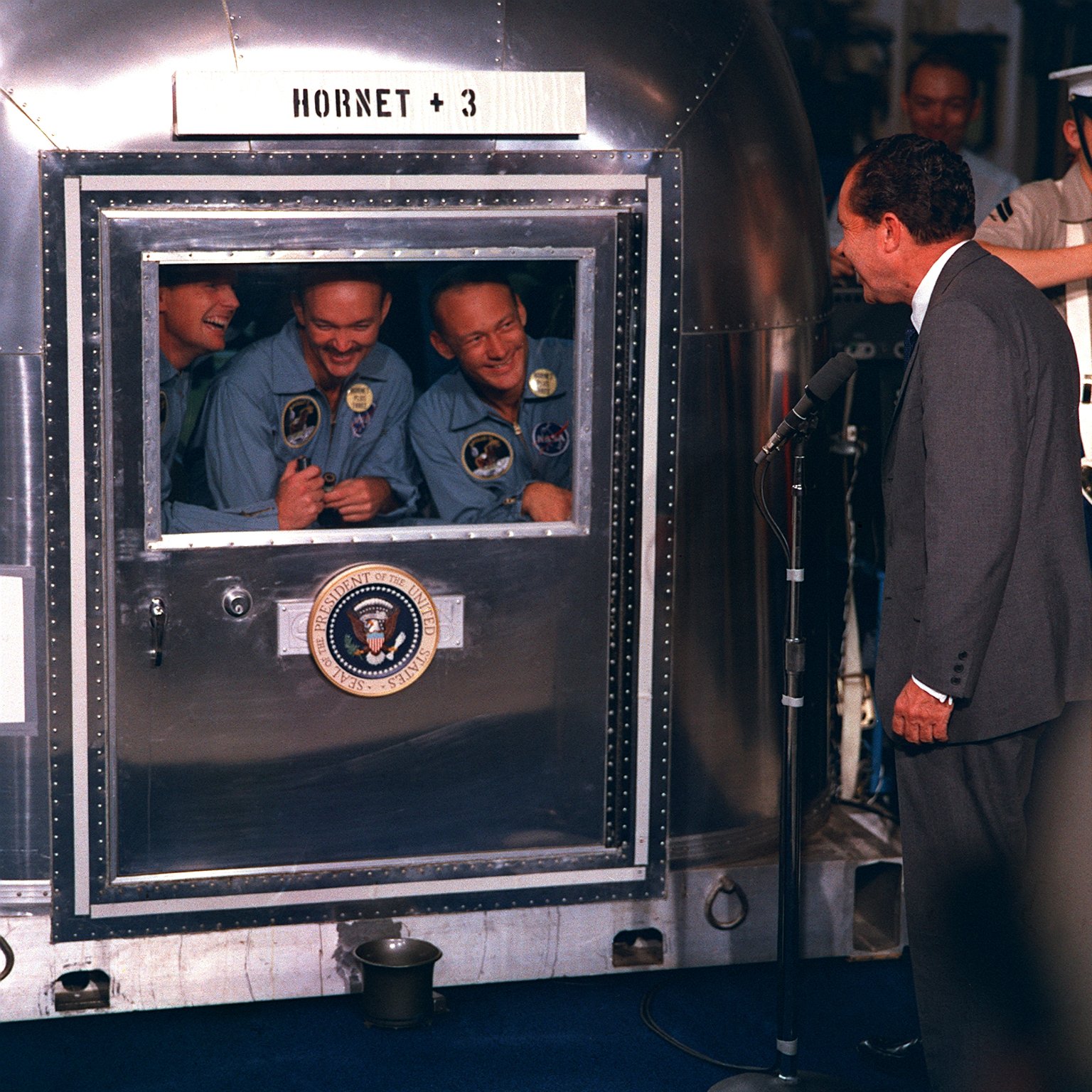
Talking to the Boss
For many people, the photo reproduced above might be their only experience with the quarantine measures that took place during the first three manned lunar landings. The image of the broadly smiling, newly returned crew of Apollo 11, joking with the President of the United States, Richard Nixon, through a window in a strange silver-colored trailer is one of the striking images of the first lunar landing some 50 years ago. What caused them to be sealed into such quarters after their mission, instead of being allowed to celebrate with those countless people who wanted to be part of the joyful event? Like with everything in manned space flight, nothing was left for chance. A small, but serious concern existed that their historic journey to the Moon could have had a negative effect on their health - or even worse, they could have brought back something harmful to others as well. This article will look at NASA's decision to implement a planetary protection quarantine of personnel, equipment and the lunar samples. We will look at the involved procedures, the facilities, and the science of quarantine in what was an unprecedented, and still unsurpassed effort by NASA and associated organizations.
The Concerns- Who Are We Protecting From Who?
The dawn of the space age in the 1950s also created the realization that for the first time, Earth could potentially become the subject of an alien invasion of sorts; the introduction of foreign biological material would no longer be just the subject of science fiction, but would indeed be hard reality. Earthborne microbes might behave oddly in the environment of space, or be exposed to radiation while outside the protective effects of Earth's atmosphere and magnetic fields, returning with harmful mutations. Similarly, exploring machines or men could accidentally pick them up from a foreign world, such as the Moon, and bring them back home. In turn, there were also concerns about Earth lifeforms contaminating the other worlds of the solar system. Human history is filled with examples of biological disasters caused by the inadvertent, and sometimes deliberate, introduction of new microbes or animal and plant species into a naive environment. Catastrophic destruction has often been the result of such contact, in terms of loss of life, and damage to plant life and animal populations.
Apollo entered this stage in the early 60s, but not without precedent. Starting from the late 50s, international cooperation had begun in terms of biological safety of space flight, both for protection of Earth, and other worlds. The terminology may sound grandiose, and although it was quite openly accepted that the probability of life forms existing on other worlds was extremely low, few were willing to take the chance without any consideration for that minute possibility. Even the Soviet Union was keen to promote these ideas on the international stage, which the US agreed on. Apollo was a continuation of such efforts, in terms of the preservation of life on Earth, and the protection of other planets and bodies of the solar system.
In retrospect, it is possible to suggest that these concerns were overblown, but we only know that this is the case due to the careful preparations and the execution of the protective plans that evolved over several years in the build up to the Apollo lunar landings. There were genuine concerns that the Earth's biosphere could be damaged by foreign life forms or the lunar material itself with its chemical composition yet unknown. A July 1964 Back Contamination Conference staged between different US governmental bodies also showed that the concerns extended to the legal sphere. The United States Public Health service had the duty to protect the citizens of the country against microbes, which might exist on the Moon. Similarly, the Department of Agriculture had the duty and the power to determine what kind of potentially biologically hazardous material entered the country - and in this particular case, the very planet itself. This made planetary protection not only a concern for NASA, but for the entire US Government.
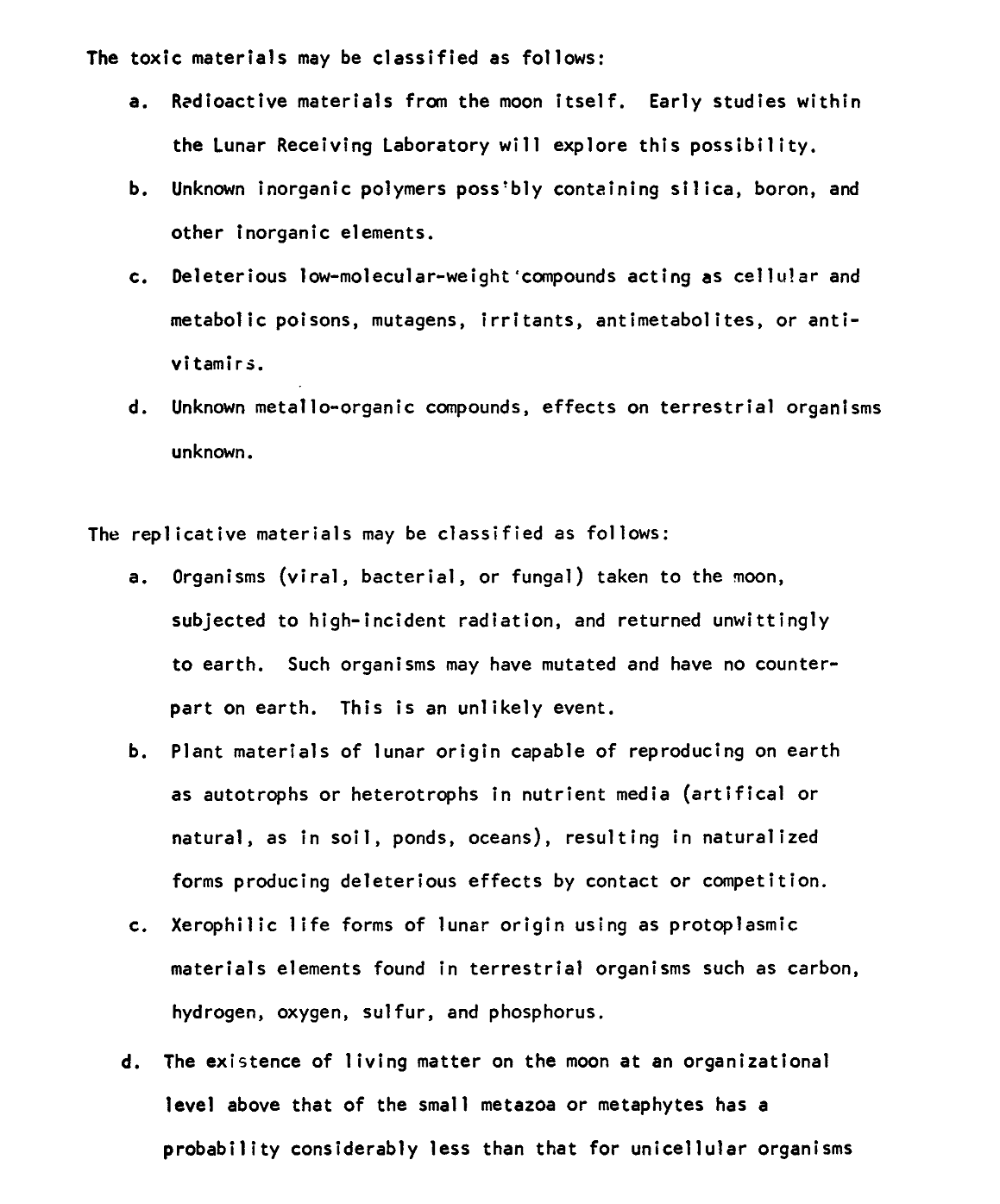
The threats to Earth biosphere detailed in the Baylor Protocol.
Although it was indeed considered to be a remote possibility that lunar material was harmful to Earth life, a list of potential dangers was drawn up. The lunar rocks themselves could be dangerous, composed of toxic metals or chemical compounds with unknown effects on the biological systems and the physiological machinery of Earth's organisms. Although such toxicities would certainly be contained with relatively simple procedures, they would pose a risk to anyone coming into contact with the material. This was not including the indeed minuscule, but not infinitely impossible chance that life forms could survive on the Moon. It was still a possibility that these most likely microscopic life forms could either be directly harmful, or become the ultimate invasive species by thriving all too well in Earth's biosphere, replacing the native plant and animal life.
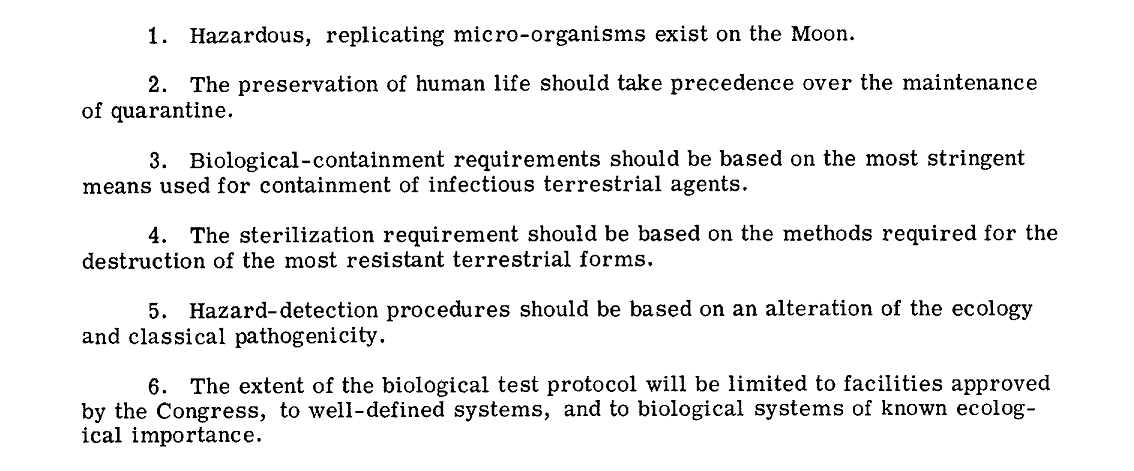
Basic guidelines for lunar quarantine.
With all this in mind, the basic guidelines were eventually drawn. Although most accepted that the likelihood of life on the Moon was very slim, the quarantine would have to start from the assumption that life did indeed exist, and it could be harmful. Human life should come first in terms of protection, whether that meant the astronauts or the general public. Since it was impossible to guess what kind of life existed on another world such as the Moon, all planning for the biological protection should be made based on knowledge of Earth's own life forms. If a sterilization procedure, for example, would render Earth life forms inert, it would have to be assumed to have a similar effect on Moon's life forms as well. The final tenet suggested was again legislative, and financial as well. Money should be considered, even on a plan like this.
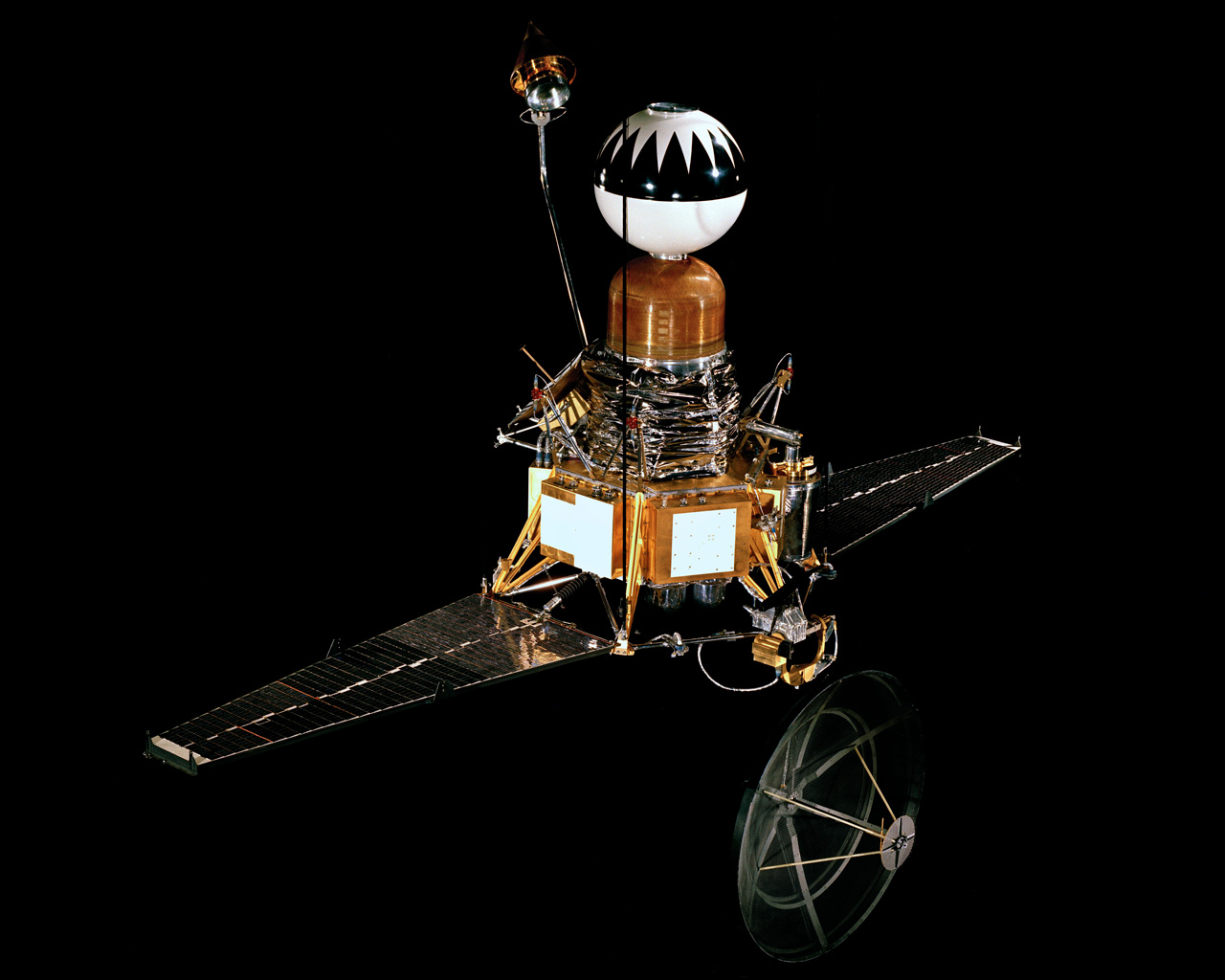
The Ranger Spacecraft
These concerns were not singular and limited to the manned space flight program. NASA had already taken steps to prevent the contamination of the Moon by Earth organisms during the Ranger program to send impact probes to the Moon. The Ranger spacecraft were sterilized with the extremely toxic gas ethylene oxide and the use of high temperatures, in the hope that the chemicals and heat would render the probes sterile. These experiences showed that although some of the components on the spacecraft might be designed to survive the hardships of space flight, the sterilization requirements would produce new needs in terms of durability. Similar issues would certainly be encountered during the long Apollo development and operational phases.
A System Takes Shape
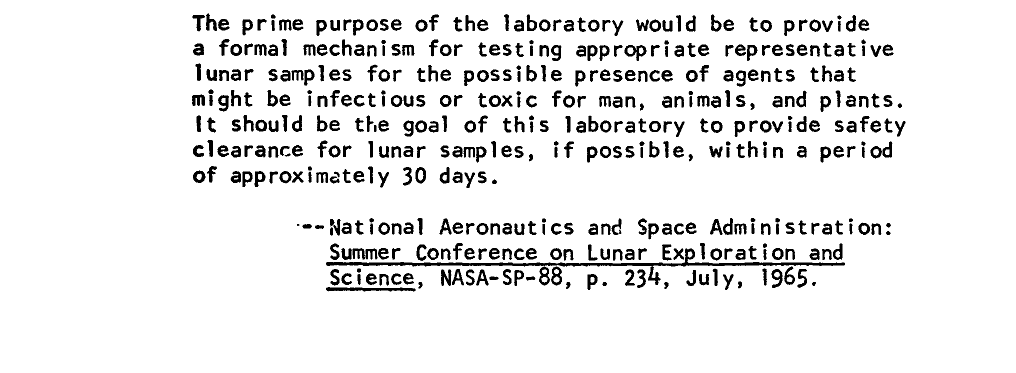
The statement of purpose for the LRL.
To handle the planning for the lunar sample return and crew quarantine, a new organization was formed, named the Interagency Committee on Back Contamination, or (ICBC). It would advise NASA and the various other government offices with regard to the procedures, equipment, and facilities needed. Although there were initial hopes that it would be cost effective to procure the needed laboratory space and equipment from an existing facility, a review showed that although the various capacities required for the project were indeed available, none of the present facilities offered all of them. The needs for the lunar sample laboratory were highly specific and broad. There was a requirement for maximum level of bio-safety for sample handling and to contain both the crewmembers, staff, and whatever test animals and plants that would be required for determining the safety of lunar material. It would not be feasible to transport the lunar samples or the Apollo crews across the country, for example. Another government survey proved that trying to provide all these functions in one of the pre-existing locations would be as expensive or even more expensive as constructing a brand new dedicated facility for the purpose. The most reasonable choice was to create a dedicated facility, and construct it at the Manned Spacecraft Center (later the Johnson Space Center) in Houston, Texas.
NASA and the ICBC began to draw up plans for actual sample reception and the crew recovery. Under a commission from the ICBC, Baylor University College of Medicine in Houston produced a 571-page document detailing the needs for the scientific program to determine whether lunar material was harmful to Earth life.
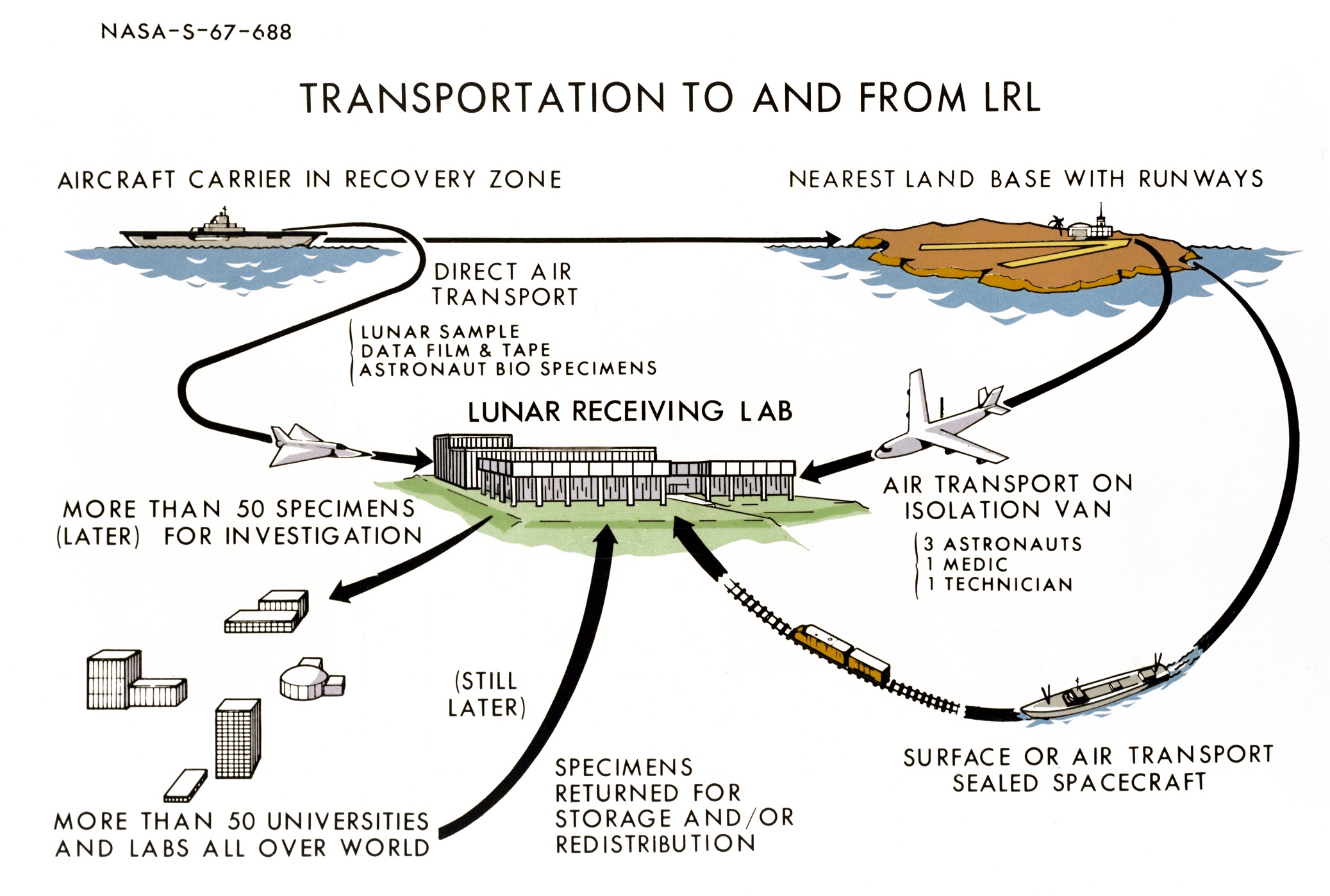
A graphic depiction of the operational flow of sample and crew recovery.
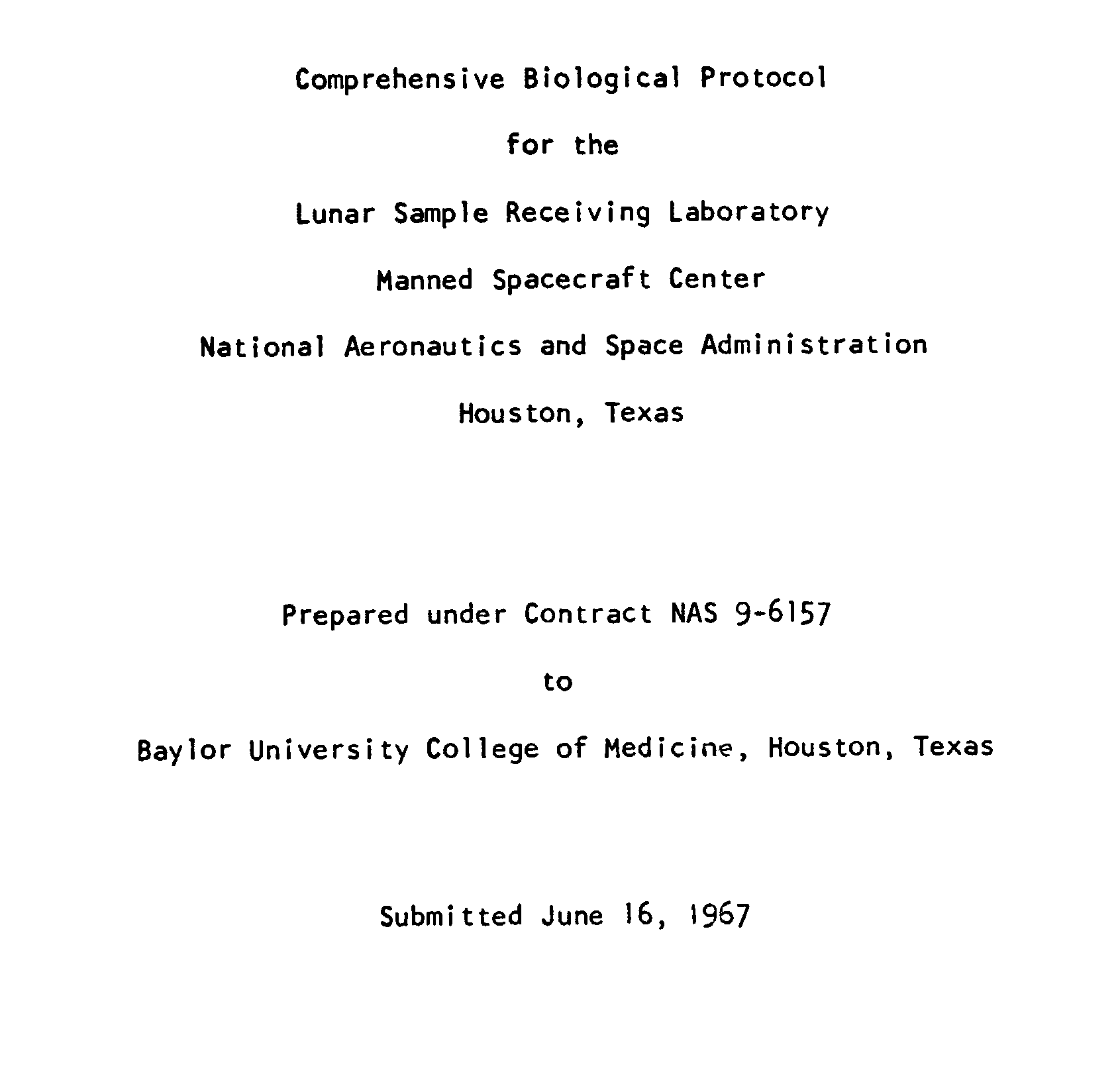
Front page of the Baylor Protocol.
The Rock Box
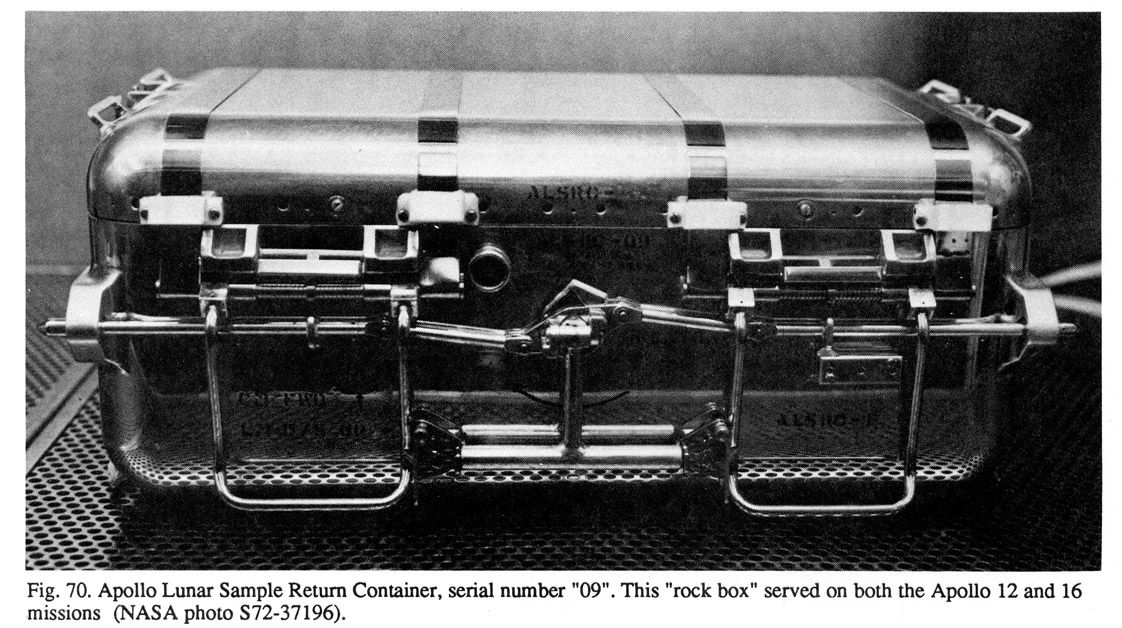
The Apollo Lunar Sample Return Container
Nothing symbolizes the planetary protection effort better than the Apollo Lunar Sample Return Container - known with the somewhat cumbersome acronym of ALSRC, and more pleasantly called the rock box. Typically two of these flew on each mission, stored in the MESA - an equipment storage unit on the base of the Lunar Module. These were no ordinary cases, but had been designed with the purpose of containing the lunar samples in a perfectly sealed environment until the box would be opened in the Lunar Receiving Laboratory on Earth. To keep the lunar samples pristine, once they were closed on the lunar surface, nothing could get in and out of them, thanks to the sturdy construction, the locking mechanisms and a triple sealing mechanism at the lid. They were designed to withstand great physical forces, and even a computer simulation of a rock box was created to calculate the possible G forces it might have to endure during the mission. It is perhaps a good indicator of the seriousness of this effort that they were constructed at the Y-12 Plant at the Oak Ridge National Laboratory in Tennessee, at a government facility best known for manufacturing nuclear bombs.
For the outgoing leg of a lunar mission, the rock boxes usually contained equipment for gathering and safekeeping of the samples. All the equipment and the box itself had to withstand thermal sterilization to ensure that it would not contaminate the samples, or the lunar surface.
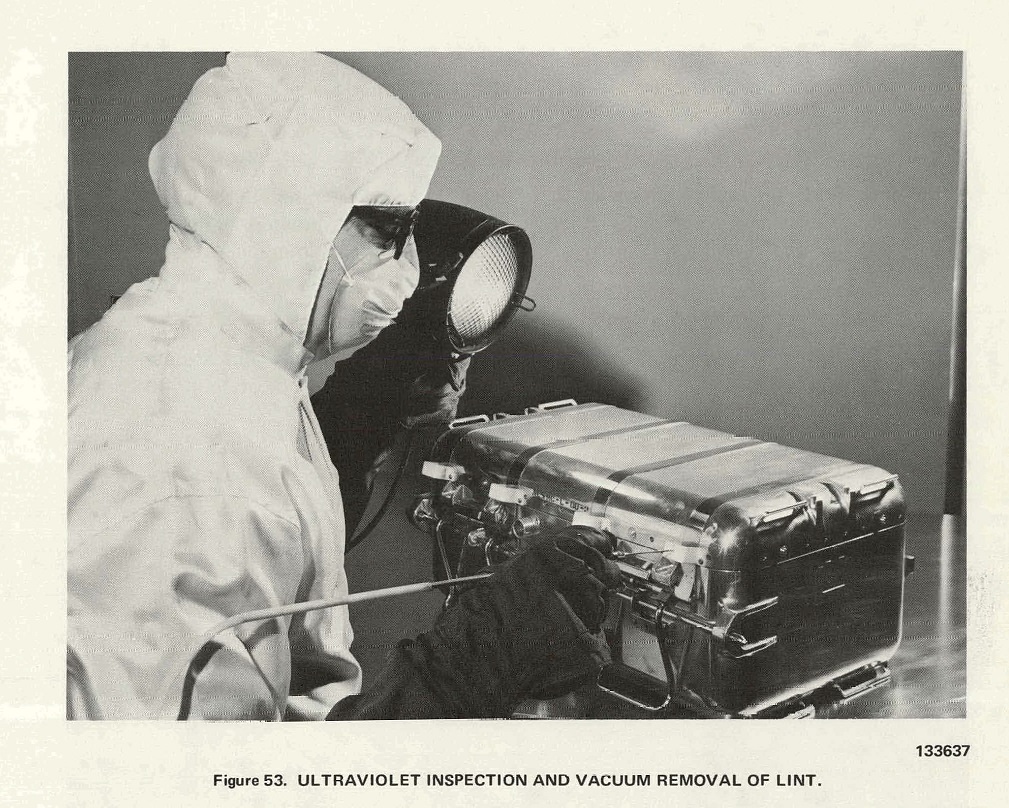
Clean suited engineer works on the Sample Recovery Container. Maximum cleanliness was the norm at all times during equipment preparation.
On The Moon and In-Flight
The mission to the Moon would expose the crew to the lunar surface as soon as the hatch was opened - but similarly, there was a concern that the crew would bring with themselves both organic and inorganic material that could contaminate the virginal lunar surface. Although all their equipment meant for the surface operation was sterilized, no effort was made to sterilize the Lunar Module. This would have simply been too impractical, considering the complexity and sensitivity of the equipment onboard. A special step taken to protect the Moon was to install a bacterial filter into the valve that was used to relieve the Lunar Module cabin atmosphere out to the vacuum on the lunar surface. This was later discontinued as an unnecessary procedure, but for the first landing, it was performed to make sure that Earth microbes did not contaminate the very first place humans landed on the Moon, even though it excessively slowed the rate of depressurisation.
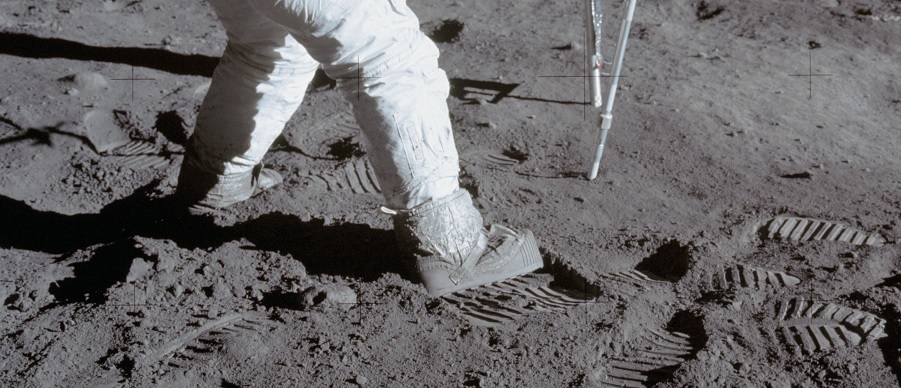
Portion of AS11-40-5964, showing Buzz Aldrin's dusty boots and suit.
Some of the first remarks on the surface concerned the dust that covered the Moon. On Earth, the effects of erosion caused by wind and water are the main source of dust and sand and these processes transport them to the seas. On the Moon, the countless asteroid impacts across billions of years has ground down the surface into a powder which was found to keenly adhere to the space suits. This posed a hazard for the crew as soon as they would return to their spacecraft and remove their spacesuits. Would they be harmed by the dust floating in the cabin, especially in zero G?
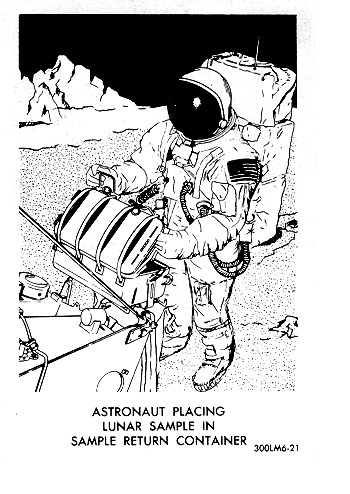
Apollo training illustration of an astronaut working at the sample container. The samples were enclosed in the return containers while outside the spacecraft. After the moonwalk, the boxes were moved into the cabin and then placed into the Command Module after docking.
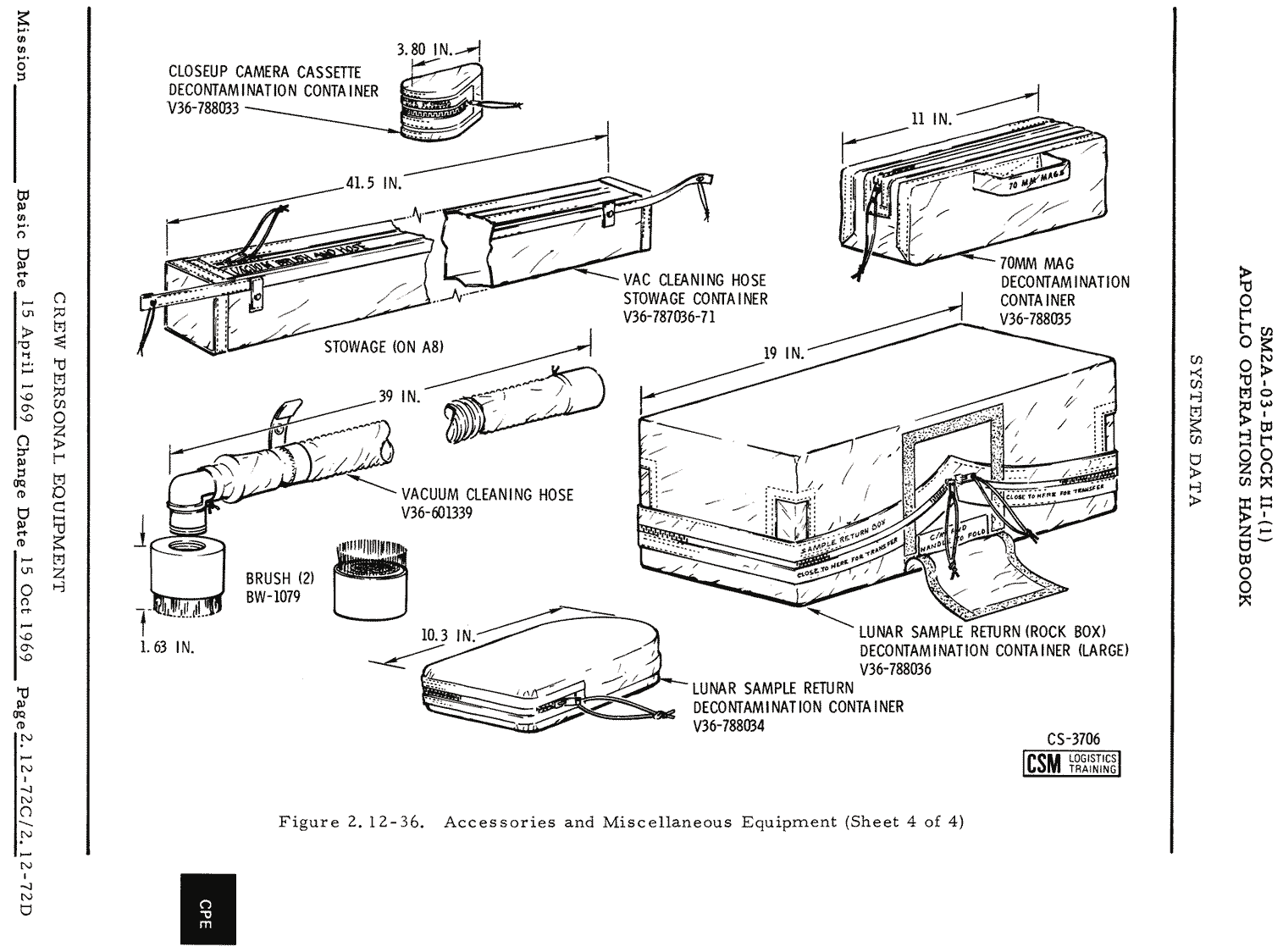
Command Module in-flight decontamination equipment.
It came as a no surprise that the crew found itself very dusty. The onboard vacuum cleaner was first used in the Lunar Module to remove as much of the loose dust as possible. The lunar sample containers, film cartridges and any other returning items were sealed in bags made of the fireproof Beta cloth before they were moved to the Command Module after docking. Although some loose dust did migrate with the crew and their precious samples, the qualities were slight in comparison. The Command Module itself would be dusted and vacuumed several times during the return trip. The crew also found that weightless dust was not a great danger after all. The life support system drew the cabin air into the lithium hydroxide filters for carbon dioxide removal, and it was these filters that most likely caught the majority of the loose dust as well.
Recovery
The terrestrial portion of the lunar quarantine operation began with the splashdown of the spacecraft into the Pacific Ocean. The original plan had been to pick up the Command Module straight off the sea and onto the deck of the recovery ship. This way the crew and any potential contaminants would remain inside the Command Module and pose no threat to the environment or the recovery personnel. It was quickly determined that trying to maneuver an aircraft carrier close enough to the small spacecraft so that a crane could lift it up from the potentially stormy sea would extremely hazardous for all parties involved. The design of the Apollo Command Module only added to the problems with such a plan. The life support system was deactivated as soon as the spacecraft descended low enough that the ambient air was sufficient for the crew to breathe, and only a small fan could be operated with the limited battery power that remained. Staying enclosed to the Command Module in the Pacific heat for several hours, potentially, would have required the design to implement a much more capable air conditioning system. Even water cooled clothing similar to the ones the astronauts wore while exploring the lunar surface were suggested, but eventually ruled out as impractical. Eventually the plan evolved to allow the crew to leave their spacecraft for recovery.
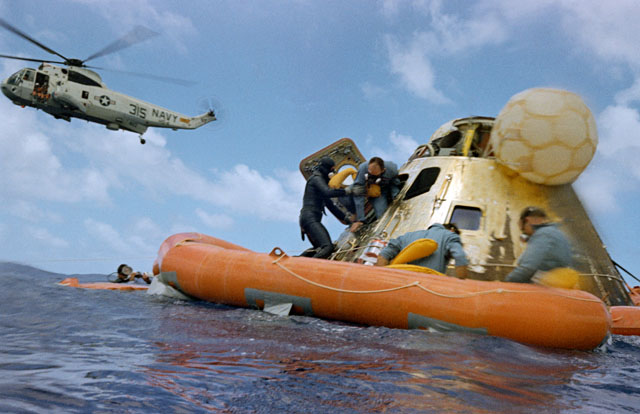
Crew of Apollo 12 being helped out of the Command Module.
Rescue divers jumping down to the sea from a helicopter became the first line of biological defense as well. After securing the Command Module with a flotation ring, the divers, clad in protective gear of their own, would pass biohazard gear to the crew inside the Command Module. Chemicals would be used to disinfect the exterior of the Command Module.
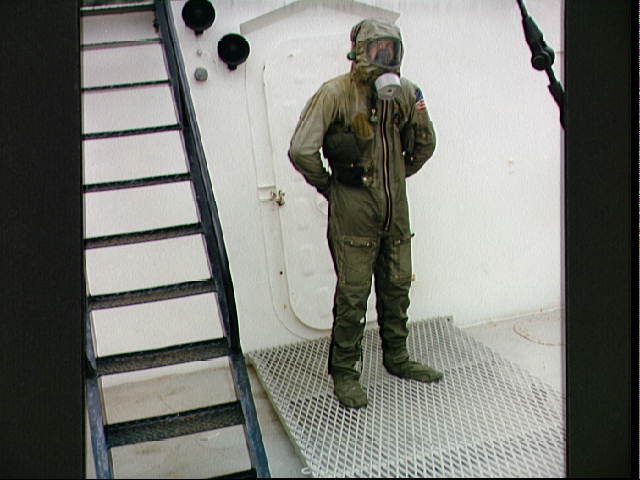
BIG - Biological Isolation Garment. Test photo.
A heavy duty protective suit known as the BIG (Biological Isolation Garment) was designed to contain the crew during the first moments back on Earth. It consisted of a Nylon jumpsuit that covered the body entirely, with an integrated breathing mask that filtered the air exhaled by the crew. The astronauts would wear these as they waited to be picked up by the helicopter and transported to the recovery ship.
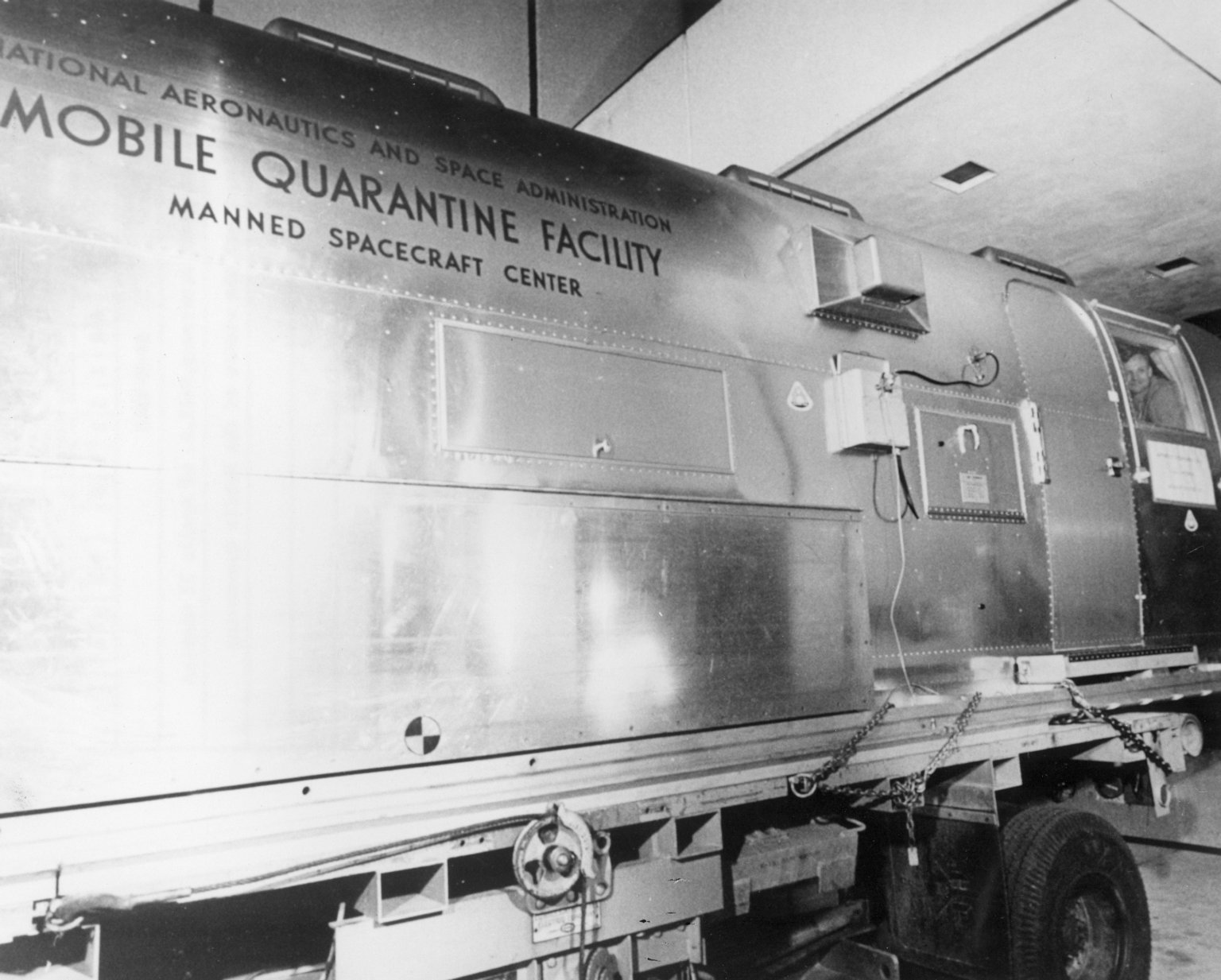
The Mobile Quarantine Facility
It would take a while for the crew to reach Houston and their ultimate destination at the Lunar Receiving Laboratory. It was determined that the most practical and secure way to isolate them for the return trip was to provide them with a mobile confinement unit. This would house them and their support personnel until arrival at the LRL. A sealed, self-contained system was developed for this purpose and became known as the Mobile Quarantine Facility. It could be transported via sea, air and road and protected the environment from exposure to the potentially contagious crew and the lunar samples.
From one Aluminum Tin to Another - the Mobile Quarantine Facility
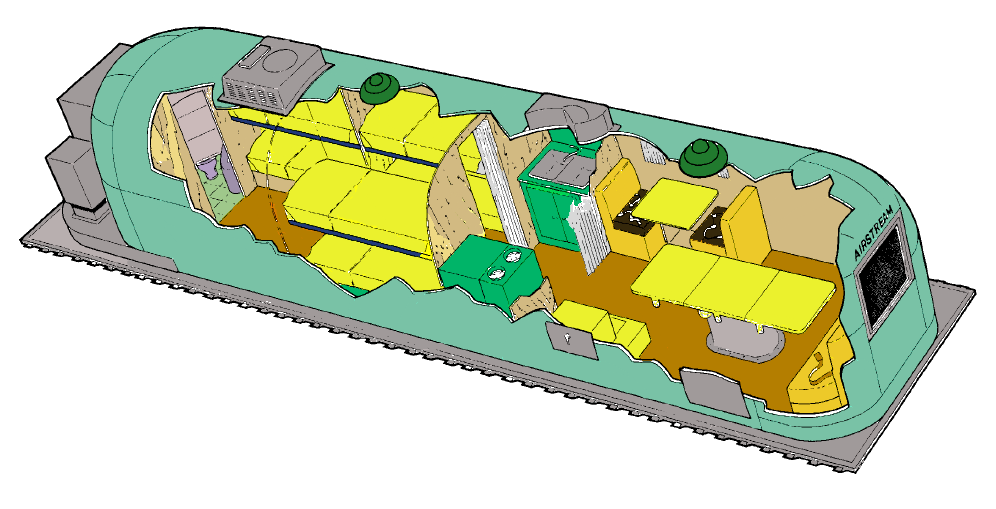
A colored diagram view of the Mobile Quarantine Facility
The basis for the MQF was an Airstream trailer that was extensively modified by the Melpar Corporation to serve as a mobile isolation unit. The main structural frame was covered in an aluminum skin that was made carefully airtight. To facilitate the easy transport of the MQF, the whole trailer was constructed on top of an aluminum frame that would be easy to fit into pre-existing structural supports onboard transport aircraft and for road transport on board a truck. It was also a useful base for the installation of the emergency diesel generator and battery equipment that would power the MQF's environmental control system in case that external power was unavailable. This system filtered all air flowing in and out of the MQF trailer and maintained a negative pressure within the trailer. Should there be a breach, air would flow into the trailer and not out to fill in the void created by the lower atmospheric pressure.
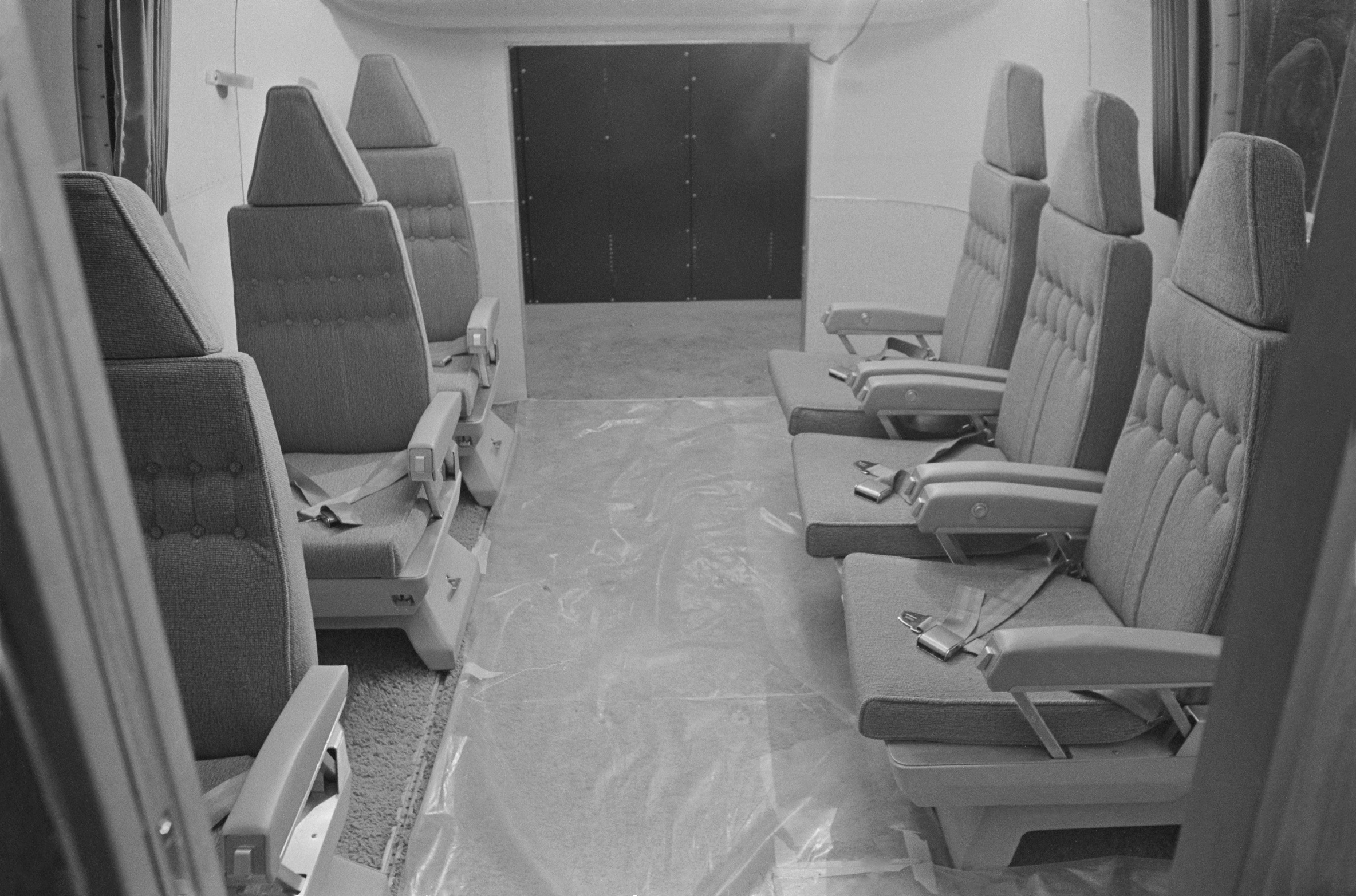
Sitting area in the MQF.
The main living area was the so-called lounge, with an adjoining kitchen. There were six airplane seats around a foldable table that could be used for eating and leisure activities. The kitchen was equipped with a microwave oven for heating up ready meals. The kitchen also contained a decontamination airlock that could be used to pass items into the MQF trailer after a sterilization with a bath in sodium hypochlorite. It was through this airlock that the lunar sample containers, film and other equipment from the Command Module were passed out to be transported to Houston.
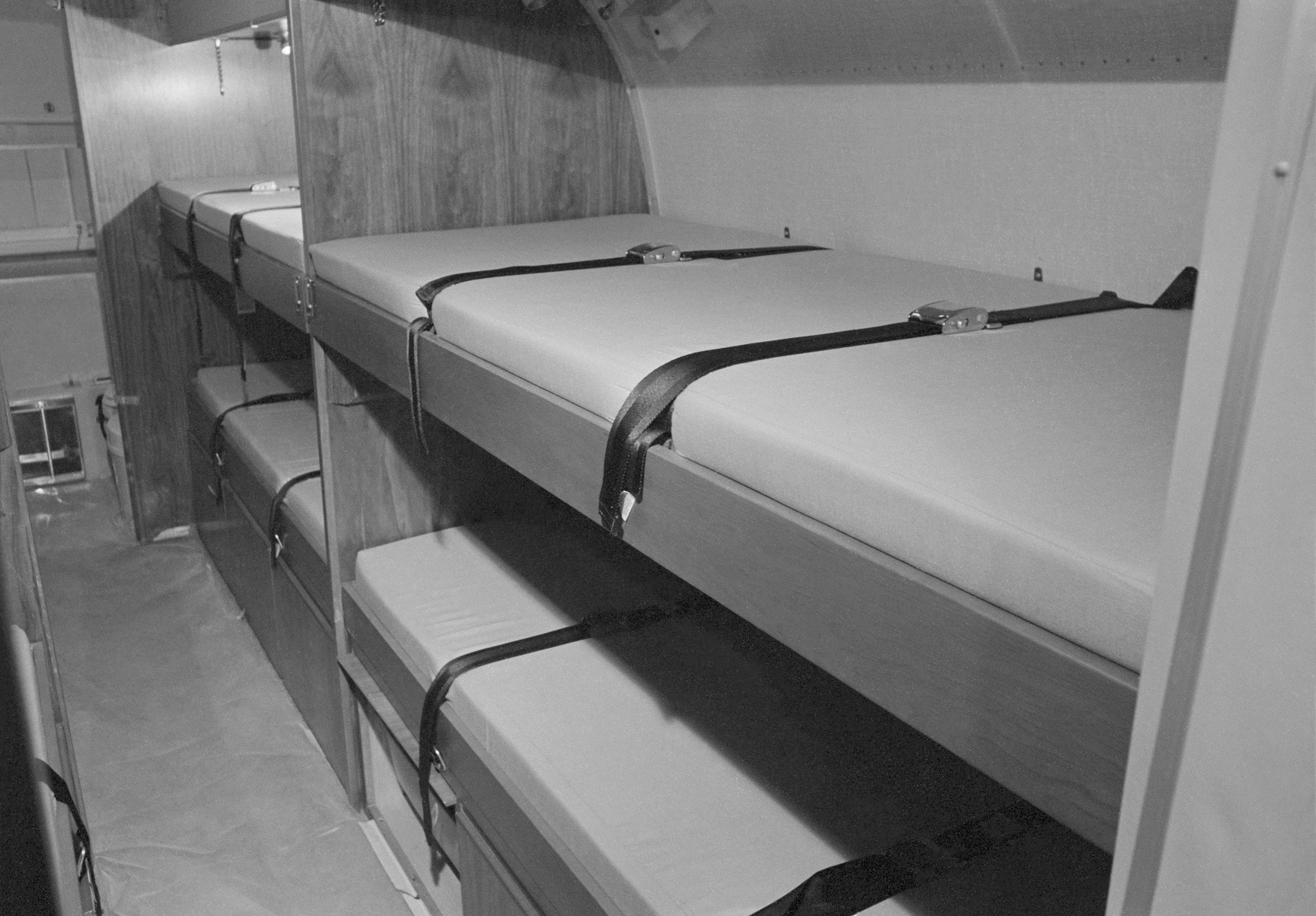
Bunk bed sleeping area in the MQF.
Spartan sleeping quarters were provided for six people in the MQF. The bunk beds were equipped with restraints and oxygen masks for in-flight emergencies.
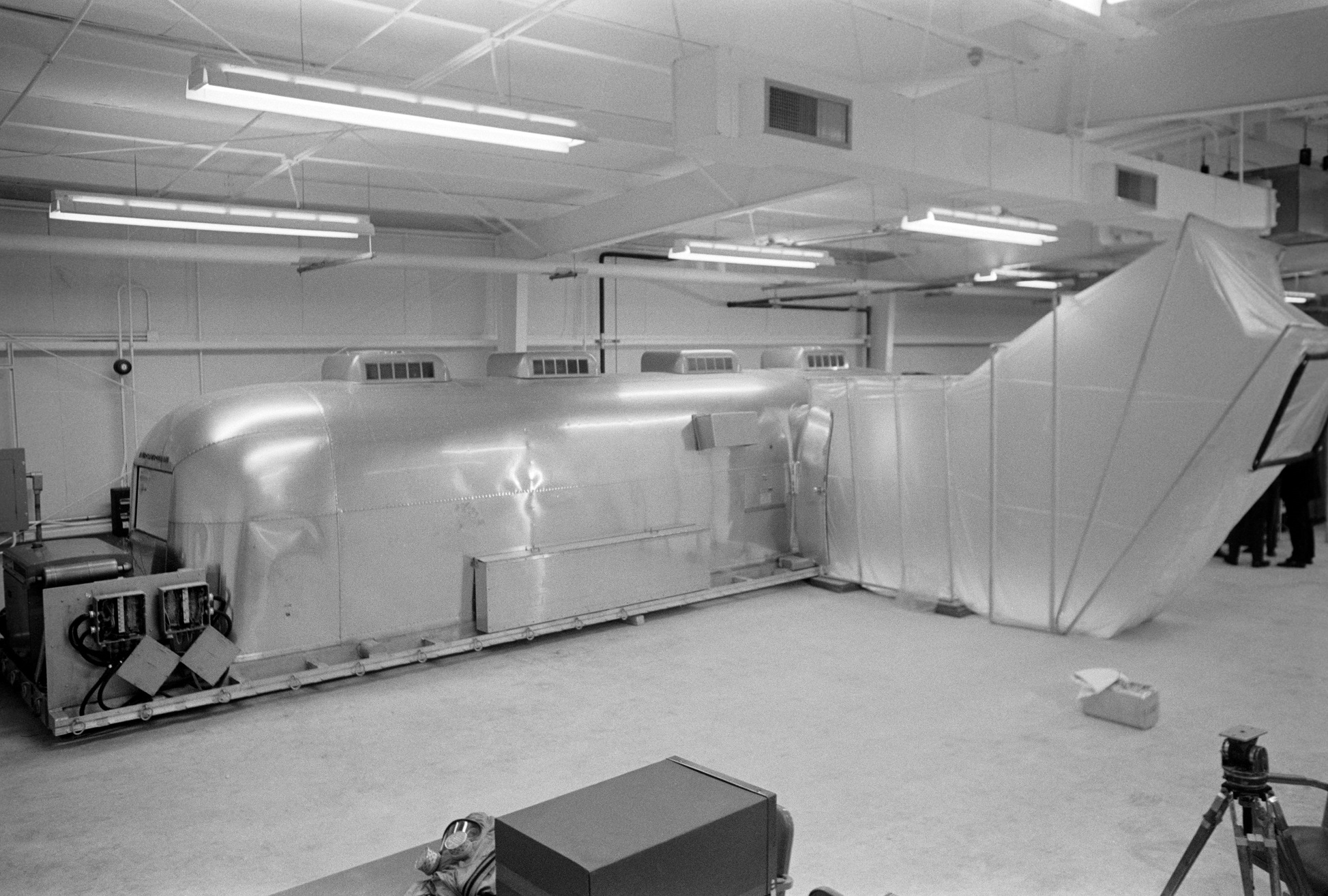
The MQF and the attached Command Module access tunnel
Since the plan was for the recovery technician inside the MQF to handle the removal of samples and other materials from the Command Module, a way to interface the two had to be created. The solution was a folding plastic tunnel that could be connected to the MQF door and then placed to cover the hatch of the Command Module. This way, personnel from inside the MQF could enter the Command Module without exposing anyone outside to lunar dust or other hazards.
Transport to Houston
The main plan for the crew transfer to Houston was for the MQF to be unloaded from the recovery ship and then put on board a cargo plane. It could be then flown to the Ellington Air Force Base just outside Houston from where road transport in a protected convoy finished the journey to the Lunar Receiving Laboratory at the Manned Spacecraft Center.
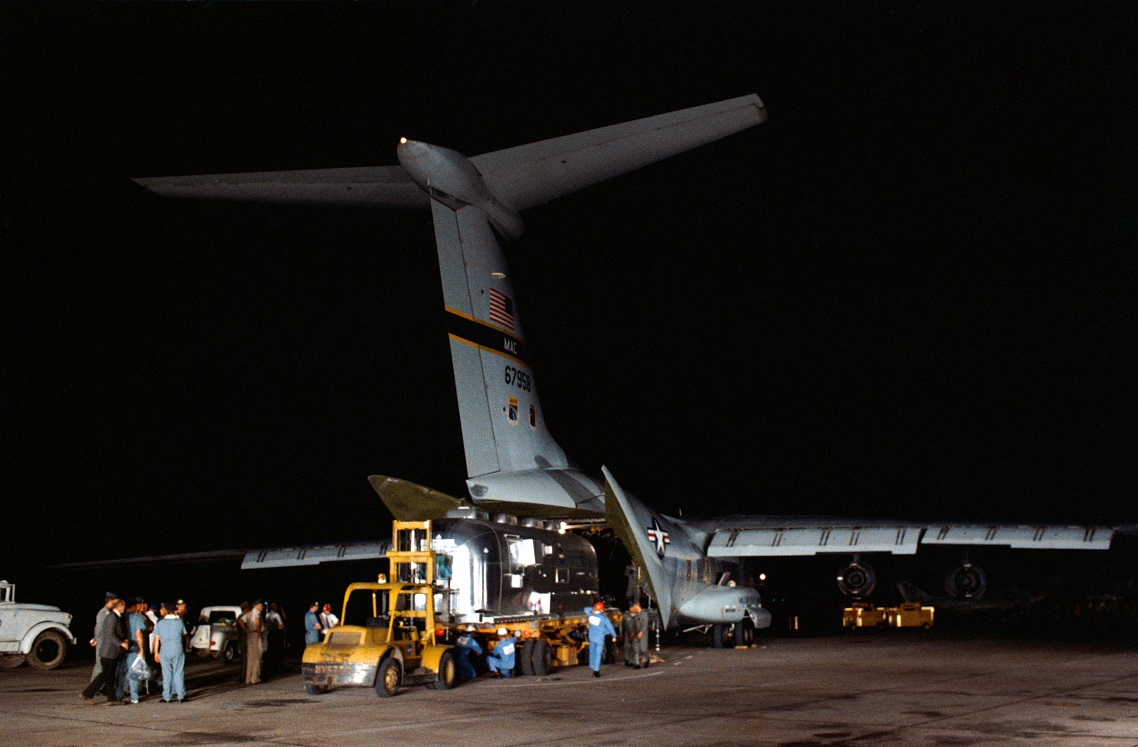
The Apollo 11 MQF removed from the C-141 Starlifter aircraft.
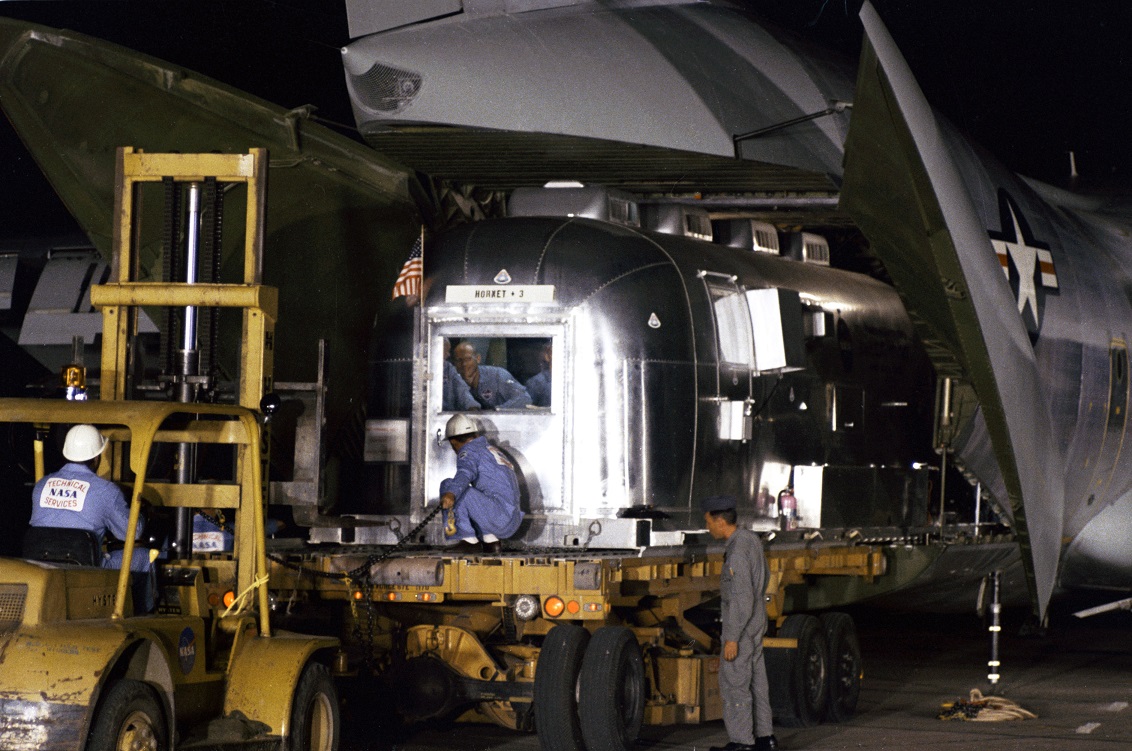
The MQF unloaded onto transport truck.
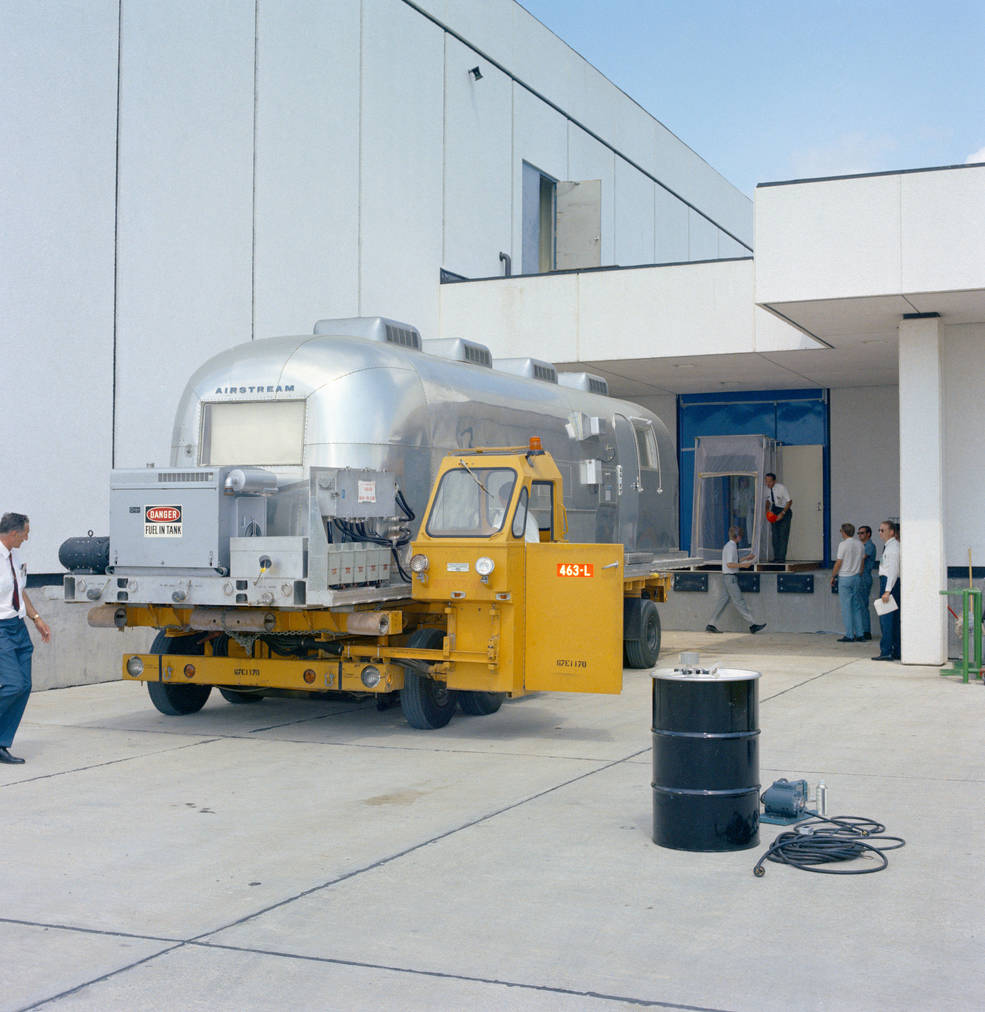
The loading dock for interfacing the MQF with the LRL. The backup power generator is well visible on this photo of the MQF on its transport rig. The accordion-like plastic transfer tunnel to connect it to the LRL is folded at the doorway into the building.
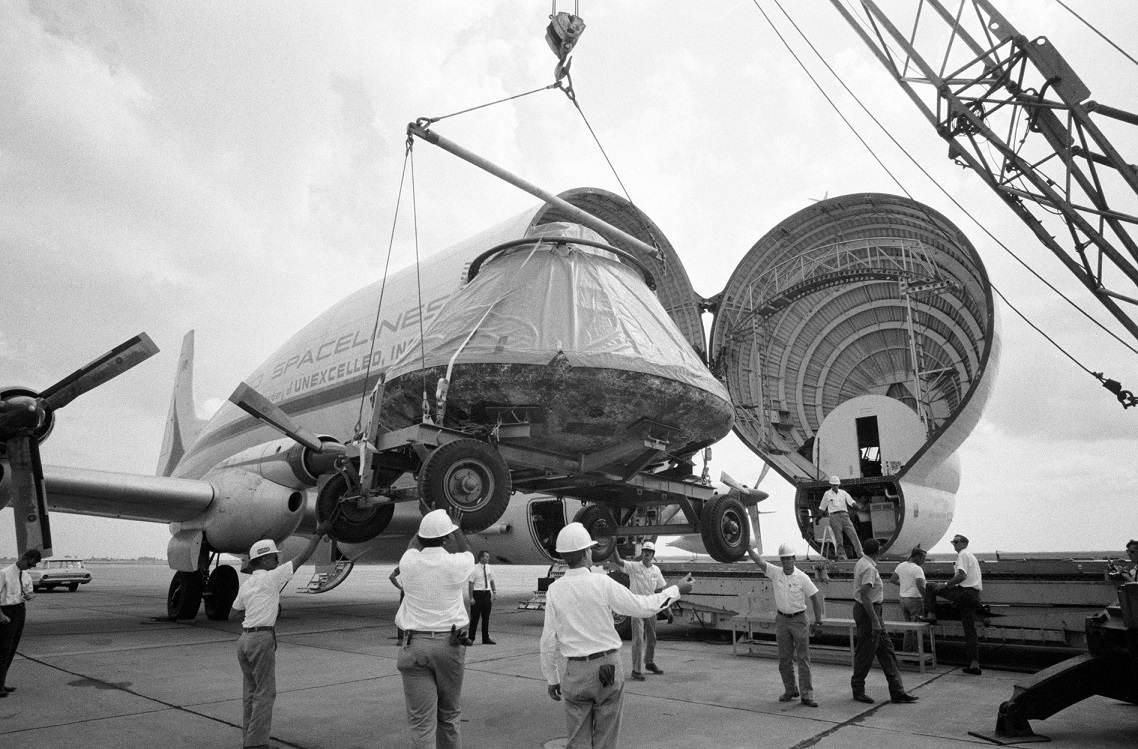
The Command Module followed soon after onboard the Super Guppy plane.
The Command Module would also make its way to Houston. According to the plan, the spacecraft was sterilized with gaseous formaldehyde for 24 hours and sealed airtight. From the recovery ship, the Command Module would be taken to a suitable facility for it to be rendered secure for reasons not related to biohazards at all. Even after landing, there were a number of pyrotechnic explosive devices and incredibly toxic fuel remnants aboard the spacecraft. Once it was deemed safe, the Command Module could be loaded into a Super Guppy special transport plane and taken to the LRL in Houston, where it could be housed for the duration of the quarantine.
The Lunar Receiving Laboratory
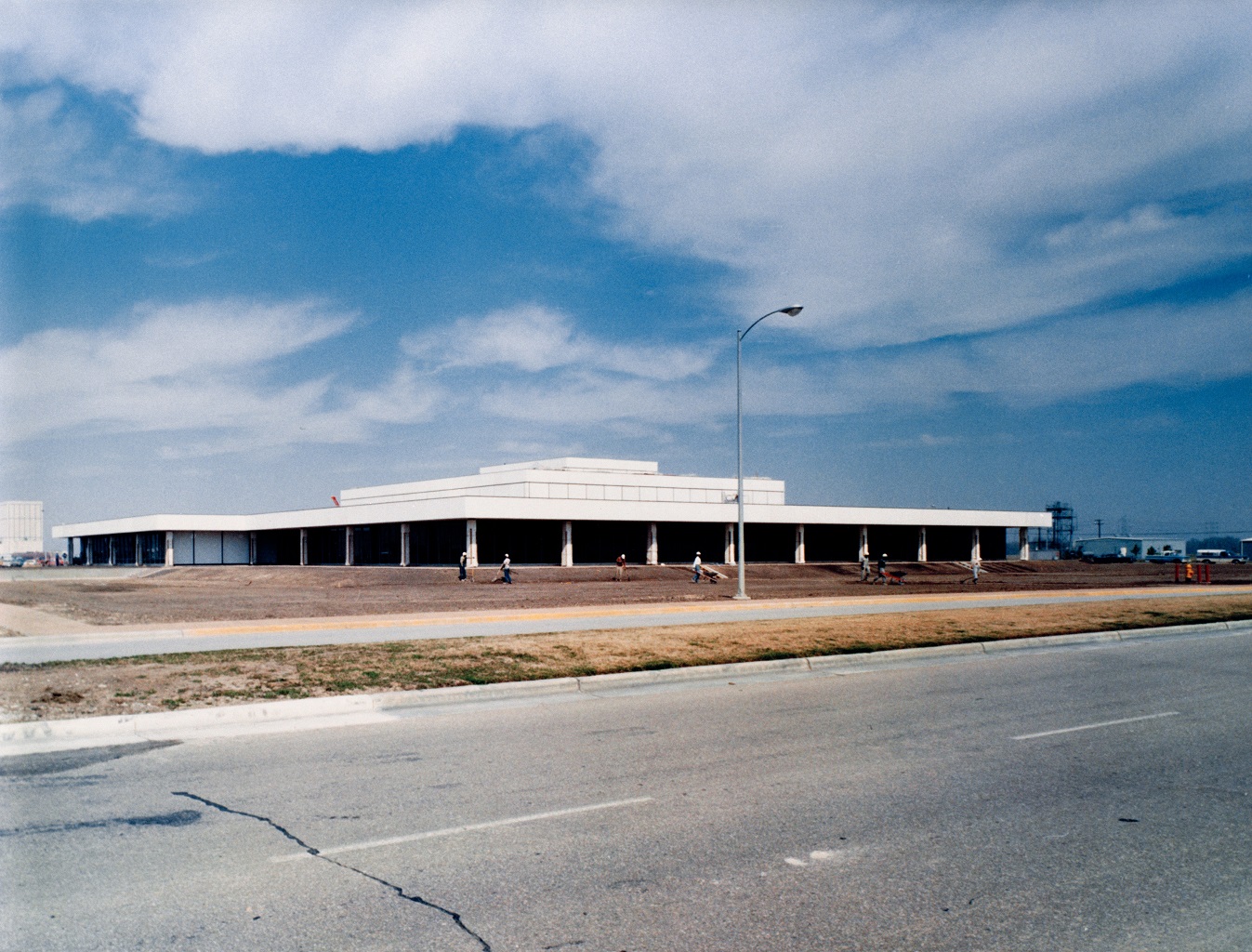
The Lunar Receiving Laboratory, aka Building 37
With the decision to locate the dedicated LRL at the Manned Spacecraft Center in Houston, construction was initiated in 1966. Main structural work was already finished in 1967 although the preparation work continued up until the very moment of Apollo 11's mission in 1969. Multiple difficulties were encountered in setting up this unique facility, ranging from equipment breakdowns to budget cuts and even having too many visitors who were keen to gawk at the marvels of the LRL.
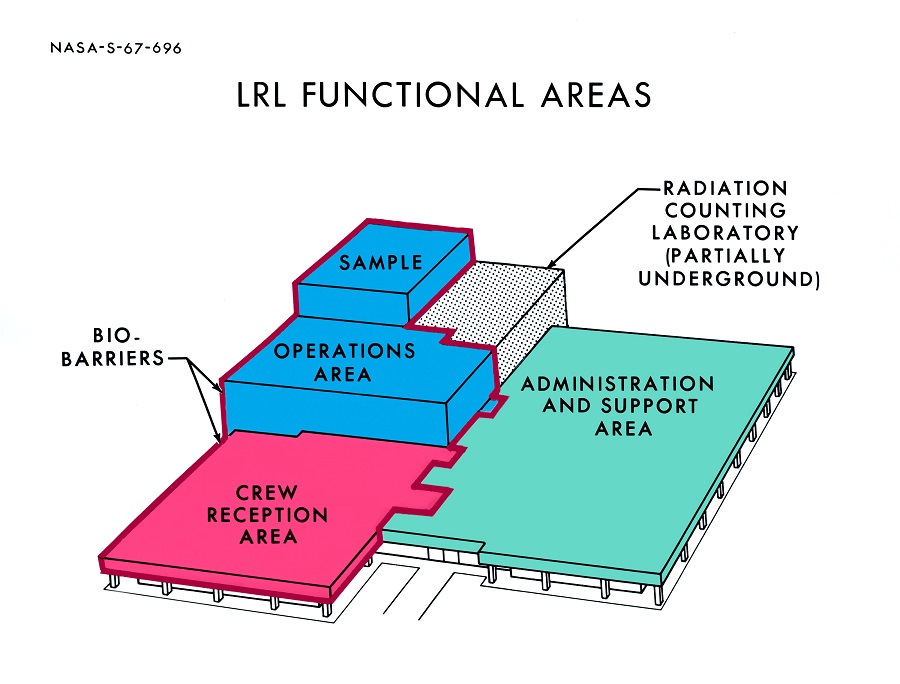
Areas of the Lunar Receiving Laboratory.
The LRL was divided into three primary sections, each with their own mission. The Crew Reception Area (CRA) would house the three Apollo astronauts, their MQF support staff, and the actual Apollo Command Module for the duration of the isolation. Directly adjoining it was the Sample Operations Area, which could be roughly divided into three primary areas of its own. It was here that the lunar samples were examined and contained, protecting both the personnel and the samples themselves. A special part of the Sample Operations Area was the Radiation Counting Laboratory. It was located mostly underground to shield it from background radiation, and was used for radiological studies of the lunar samples. The third section was the Administration and Support Area. Adjunct staff worked here, and had no direct contact with the isolated materials or personnel.
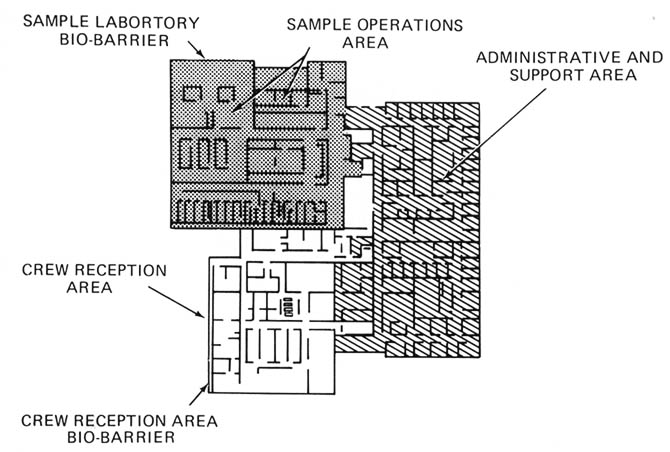
General layout of the Lunar Receiving Laboratory. A single facility contained the entire LRL, hence limiting the potential for exposure while transporting possibly hazardous material.
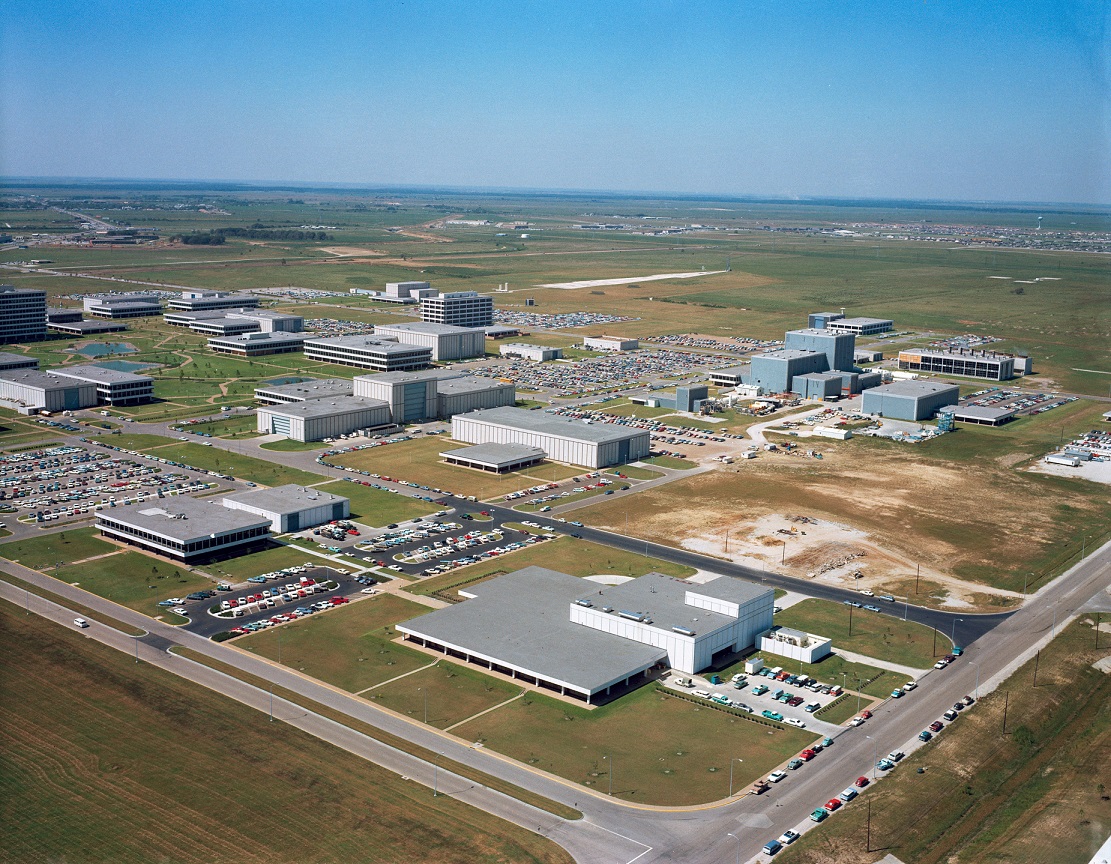
Aerial view of the Manned Spacecraft Center in Houston, with the LRL in the foreground. The drab exterior suggested nothing of the extremely specialized, groundbreaking nature of the work that was taking place inside Building 37.
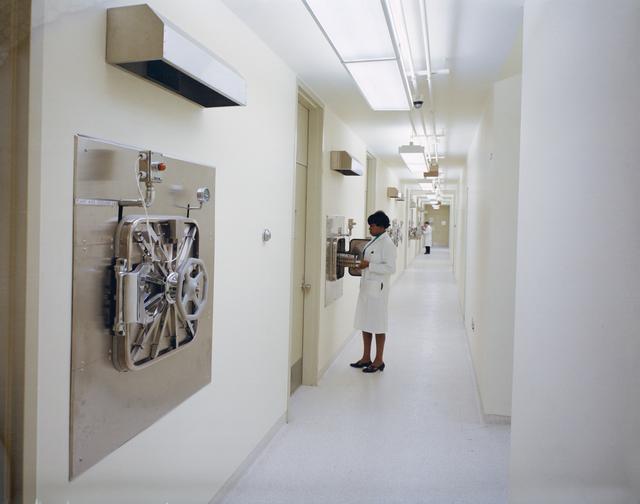
Sterile white hallway inside the Lunar Receiving Laboratory.
Staff requirements were strict for the people working in the LRL. Pregnancy or any medical condition were disqualifying factors. Everyone entering the quarantine laboratory had to pass through an airlock containing a source of ultraviolet light. Ultraviolet radiation destroys genetic material and would hence kill any exposed bacteria and other microbes. Personnel within the laboratory wore clean lab work clothes, for hygiene. Leaving the laboratory involved a shower and disinfection. Everyone had to sign a waiver agreeing that should there be a containment breach, the staff could be subjected to an indefinite period of quarantine until their safety could be determined.
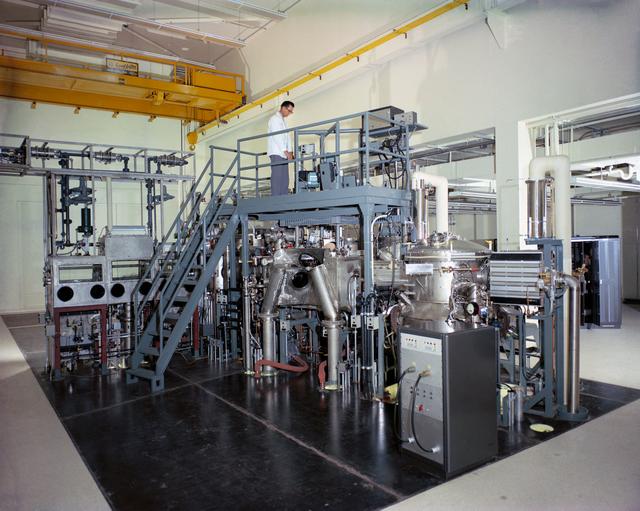
The High Vacuum Complex, for sample preparation. Vacuum equipment would maintain the lunar samples in protected conditions, with the staff secure from exposure to the lunar samples - and vice versa!
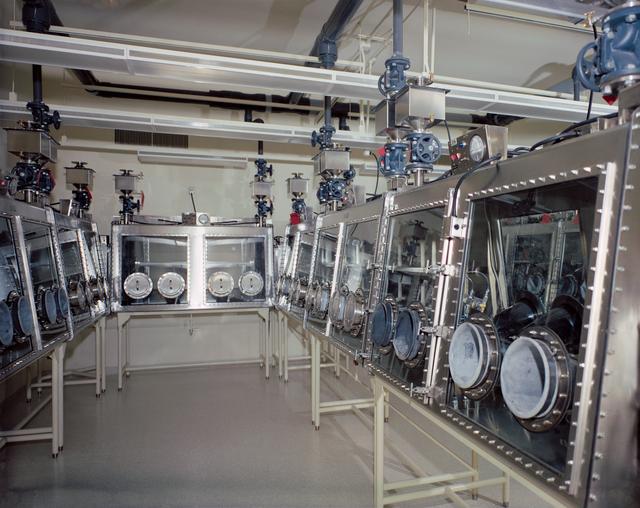
Isolation cabinets at the support laboratory. Class III fully enclosed biological safety cabinets formed the first line of defense.
The safekeeping of life and health was the main purpose of the LRL. Considering that potentially extremely harmful pathogens could be harbored in the samples kept inside the lab, everything had to be designed for the maximum containment of such a potential hazard. NASA consulted with the best experts available at the time to them in the United States, including the Communicable Diseases Center (later Center for Disease Control) as well as the U.S. Army medical institute at Fort Detrick, Maryland, (later USAMRIID) home to the U.S. bioweapons research laboratory. Eventually the design of the LRL's biological protection system even surpassed that of the latter. If present day determination of bio-safety levels would be used, the LRL's biological facilities fill the requirements of Biosafety Level 4, used only for the most dangerous and virulent, and potentially lethal agents, with work being under done maximum security measures. Although this classification did not exist yet at the time, this was their goal.
A defense-in-depth approach was taken in the construction of the LRL in regards to biological safety. All sample handling was to take place inside cabinets that were completely sealed and isolated from the environment outside. All manipulation of the samples inside the cabinets was to be done by the LRL staff while using specially manufactured gloves that penetrated into the cabinets. The rooms containing the isolation equipment were maintained at a negative pressure so that all air flowed from the outside to the inside - hence any airborne contamination would remain inside, rather than potentially escape. The containment of the samples in these cabinets was known as the primary barrier. The staff would be kept isolated from the lunar material and anything exposed to it at all times. Should the primary barrier be broken and an exposure could be proven, the staff would be isolated just like the astronauts and anyone who had had direct contact with them, until it could be determined that no danger existed. As a further safety measure, the LRL building itself formed the secondary barrier against contamination. The laboratory areas were kept under negative pressure, and all ingoing and outgoing air was filtered and incinerated to destroy any contamination. To maintain this negative pressure, access to the isolation areas was only via airlocks. Similarly, any sewage water and material was carefully treated before it could be introduced into the general drainage at the Manned Spacecraft Center. Tight security insured that the personnel traffic was kept to a minimum.
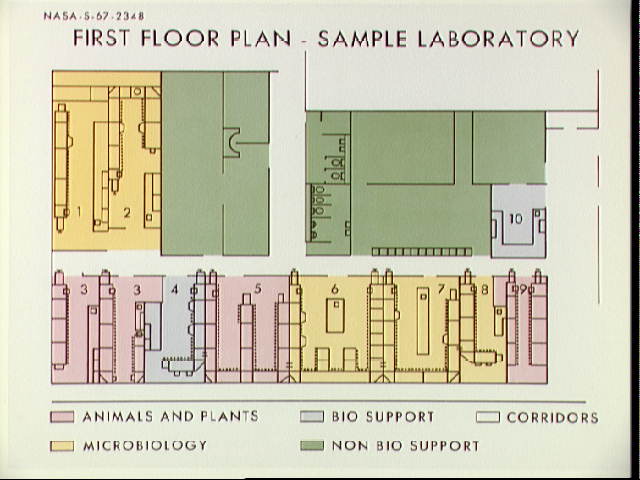
Sample laboratory plan.
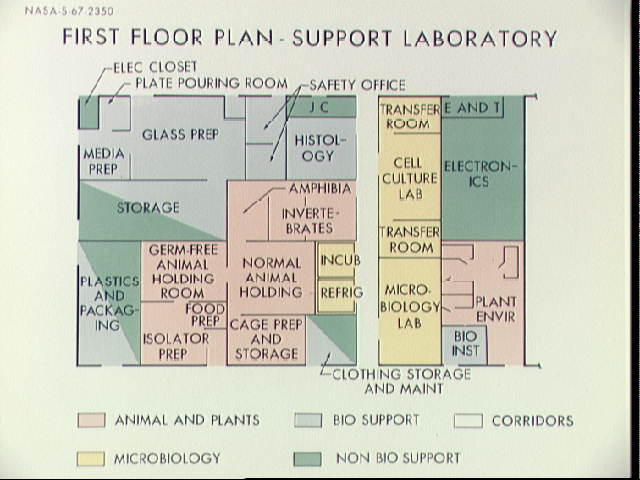
Support laboratory plan. Further laboratory areas mainly concerned themselves with the biological model species used for the bio challenge program.
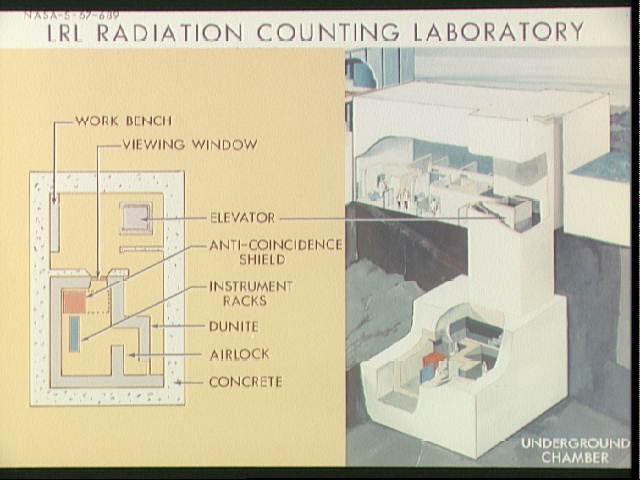
Concept diagram of the Radiation Counting Laboratory
The Radiation Counting Laboratory or RCL was a highly specialized part of the LRL. It was set up 15 meters or 50 feet underground to protect it from background radiation produced by radioactivity in the Earth's own crust. Massive amounts of lead shielding and a special air conditioning system produced an environment where even the smallest amounts of radioactivity could be potentially detected in the lunar samples. With very brief half lives, the samples required for the radiation counting were those that were processed most quickly in the High Vacuum Complex for sample reception in the hopes of catching any elusive results.
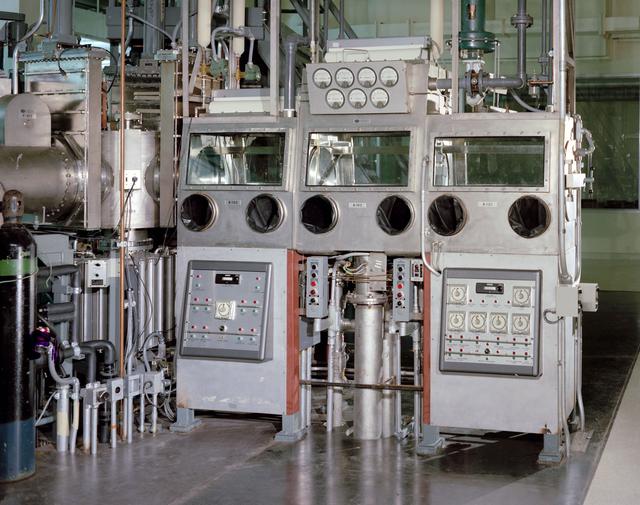
Isolation cabinets at the High Vacuum Complex.
Crew Reception Area
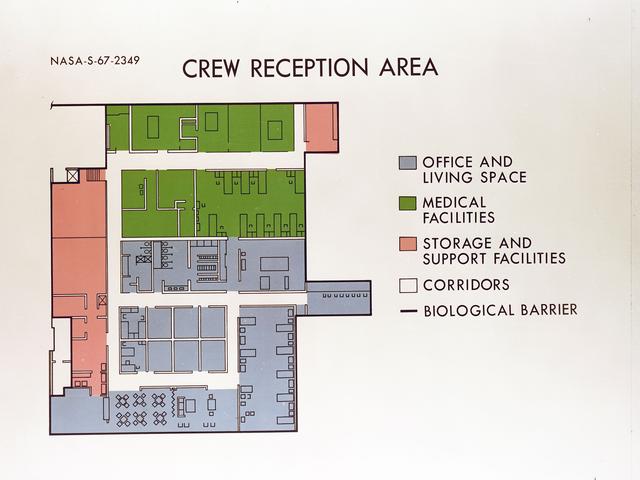
Layout of the Crew Reception Area
The Crew Reception Area - or CRA - would house the Apollo crews, their recovery support staff, and the facility staff in isolation for the duration of the quarantine. Living quarters, support areas, and storage for the Apollo Command Module were provided. A full medical facility was built into the CRA for the purpose of conducting the crew medical examinations, and to treat any minor illnesses and injuries that might occur during the quarantine. Biological barriers were in the form of solid walls and other structures. Filtered, negative pressure air system prevented exposure of the outer world to the potential hazards posed by the crew.
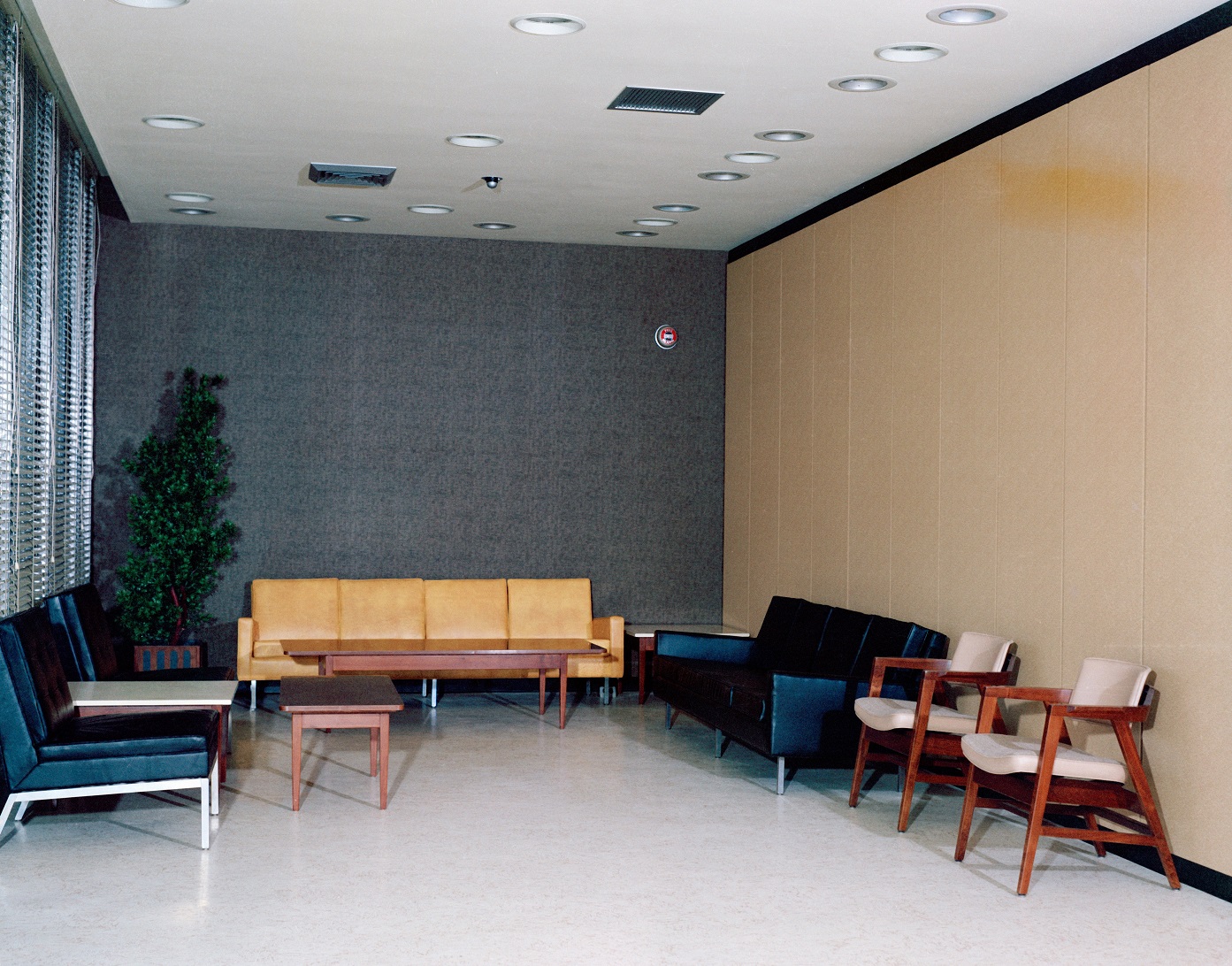
Sitting area.
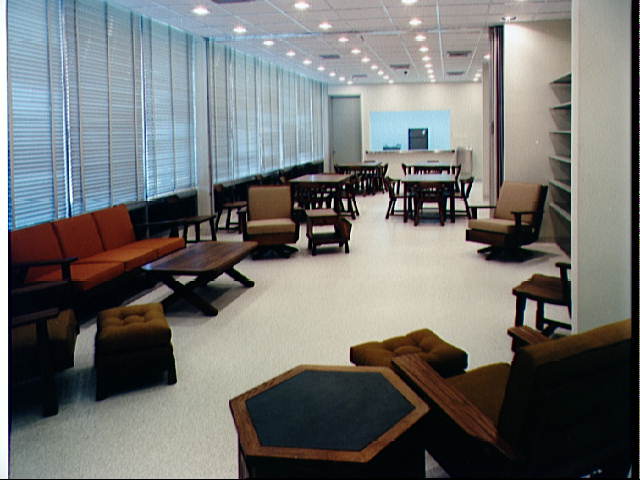
Reverse view into the crew area, showing the dining tables and the hatch to the kitchen.
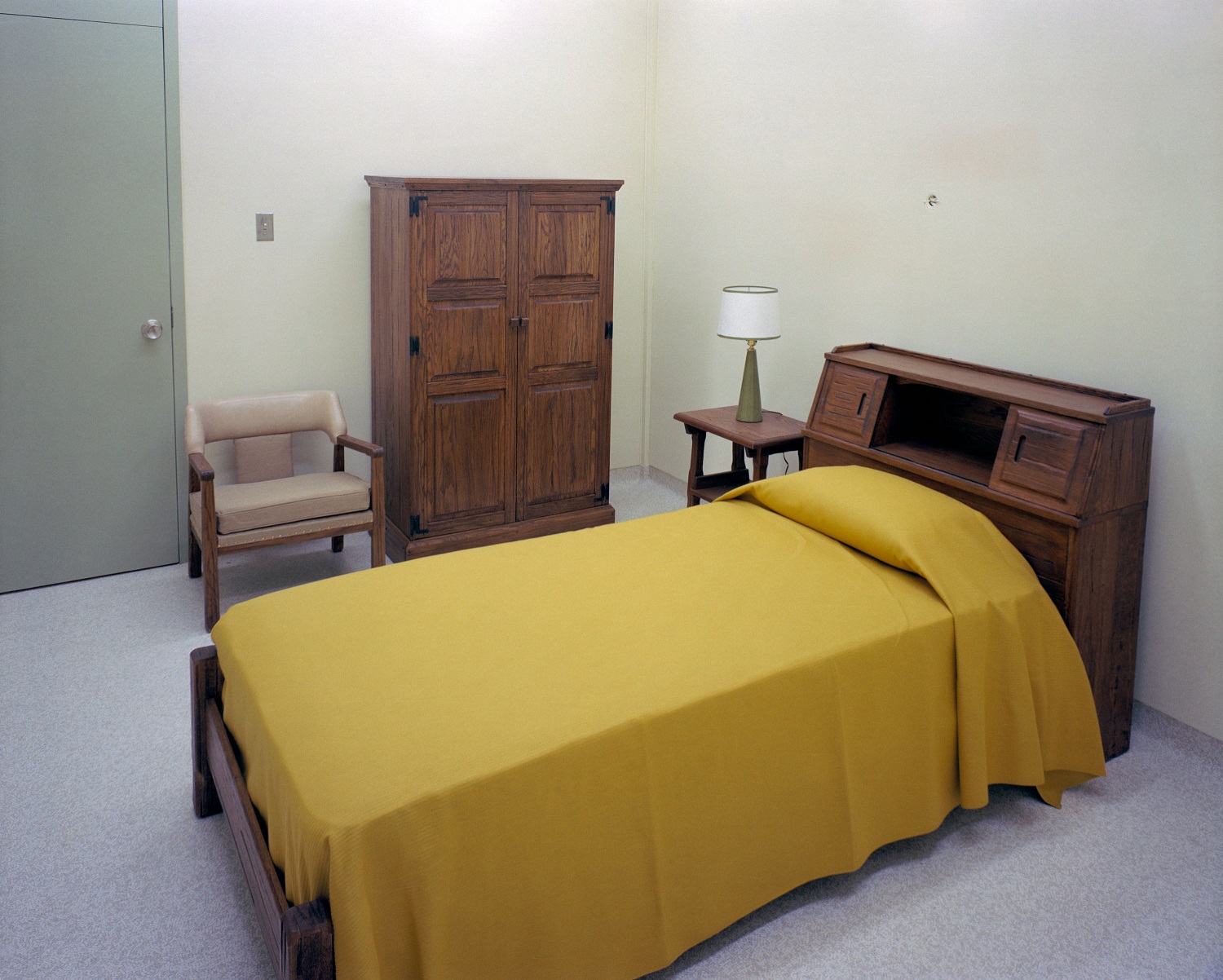
Typical astronaut quarters in the LRL.
Quarters were provided for the crew and the CRA personnel. Should there be a major containment breach, or signs of severe contamination or danger to life, there was space in the facility to quarantine all the staff in the confines of the LRL.
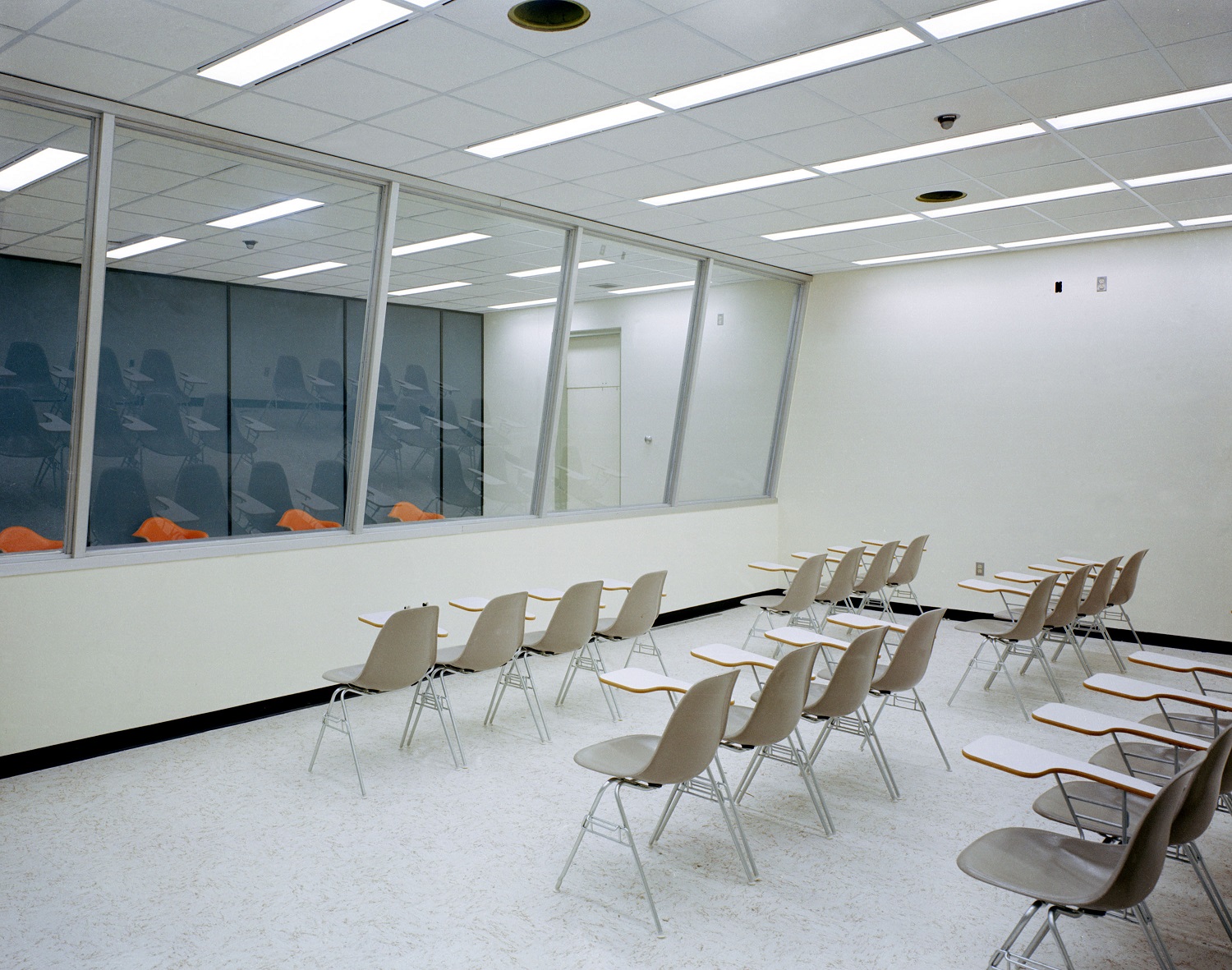
Briefing and press room in the LRL.
One notable point of contact between the CRA and the outside world was the briefing and press area. The crew could enter an isolated part of the room, protected via a window, and interact with people on the other side. It was here that they answered crew questions as well as underwent the post-flight debriefing. It was important to perform the debriefings as soon as possible after their return so that their memories and experiences were still fresh.
The Handing of Lunar Samples
The lunar sample retrieval plan called for complete isolation of the lunar material. This was done for the purpose of two-way isolation - both to protect the Earth biosphere from exposure to the lunar material, as well as to prevent the back contamination of the lunar samples via Earth organisms and materials. For this purpose, an elaborate system was designed and constructed that would maintain the initial lunar samples in such preferred condition.
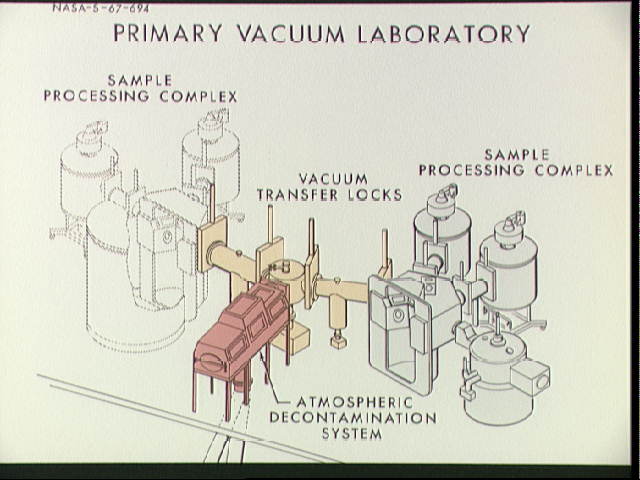
Contemporary diagram of the High Vacuum Complex. The diagram illustrates two High Vacuum Complexes joined by a transfer lock (in yellow). As the diagram indicates with the dotted line, the second unit was planned but not constructed, for budgetary reasons.
The solution chosen was the High Vacuum Complex. It consisted of a series of stainless steel chambers connected to one another. Intricate pump machinery evacuated all gases from within to produce a high vacuum in the vicinity of 0.133 mN/m2, or 10-6 torr, similar to conditions in outer space. The systems was constructed by Union Carbide, using specialists from the Y-12 Plant at the Oak Ridge National Laboratory in Tennessee - a government facility most famous for constructing nuclear bombs. They were also responsible for the manufacture of the Apollo Sample Return Containers that were processed within the High Vacuum Complex.
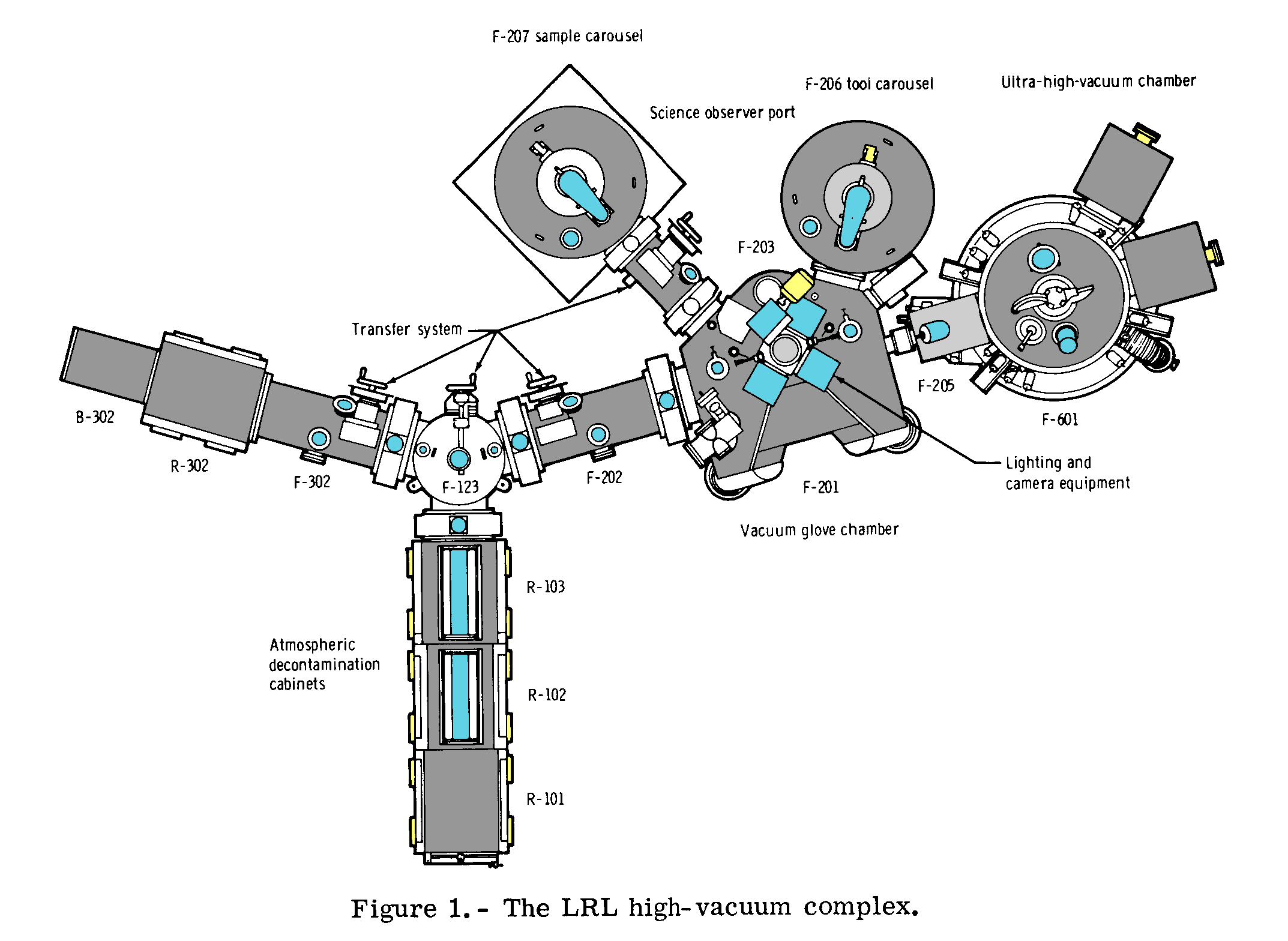
Structure of the High Vacuum Complex (diagram)
The High Vacuum Complex was a very intricate, state of the art piece of equipment. At its core was the F-201 Glove Chamber, where most of the sample preparation and investigation work happened. All equipment and materials entering and leaving the High Vacuum Complex had to do so through the adjoining atmospheric decontamination cabinets. Here items were first sterilized with peracetic acid, followed by hot nitrogen and then a 160°-Celsius bake out. Only then could any objects be moved into the actual F-201 chamber for handling. A two-pronged transfer system with air locks and a monorail transfer system that could be operated from the outside was used to move the sterilized samples inside the High Vacuum Complex. This system particularly was found to be very temperamental, with items repeatedly getting stuck inside the transfer section. It was deemed too convoluted for the purpose needed, but there was no time nor money to make any changes. The primary reason for the unnecessary complexity was that it had originally been envisioned that the single decontamination airlock cabinetry could service two separate High Vacuum Complexes joined by the transfer section. A budget cut slashed out the second High Vacuum Complex, leaving them with one Complex and the rickety transfer system.
The F-201 Glove Chamber allowed technicians and scientists to examine and study the lunar samples while maintaining them in the vacuum environment. Equipment inside was provided for photography and surface examination of each sample. The extremely stiff, cumbersome gloves meant that the chamber operators became fatigued quickly. A 15-minute time limit for each operator was instated to ensure that nobody would tire too easily.
The interface between the lab technician and the lunar samples consisted of a specially prepared pair of gloves. They were reinforced to prevent the material from ballooning when pushed into the vacuum chamber - while the interior of the gloves was maintained at a normal pressure. A second glove made of Viton (synthetic fluorine rubber) formed the outer protective layer. These gloves were prone to splitting at the fingers and caused all kinds of trouble, especially during the hectic build-up to the first lunar landings when the systems were tested for the actual lunar sample processing.
Samples and equipment could also be taken in and out of the High Vacuum Complex with the transfer carousels. They consisted of a portable vacuum chamber with its own pumping equipment to maintain the vacuum inside the container.
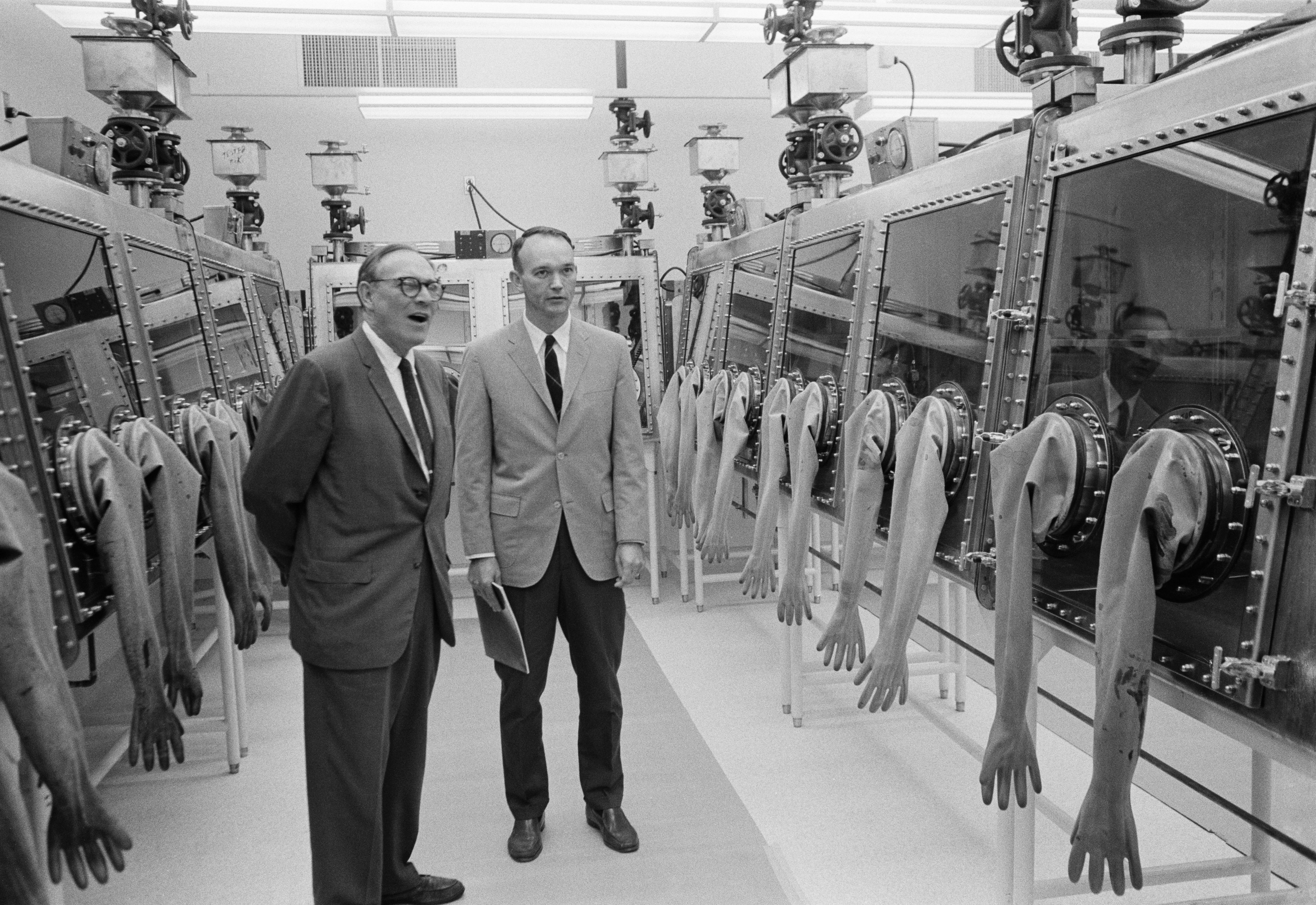
Michael Collins touring the science facilities at the LRL in 1967.
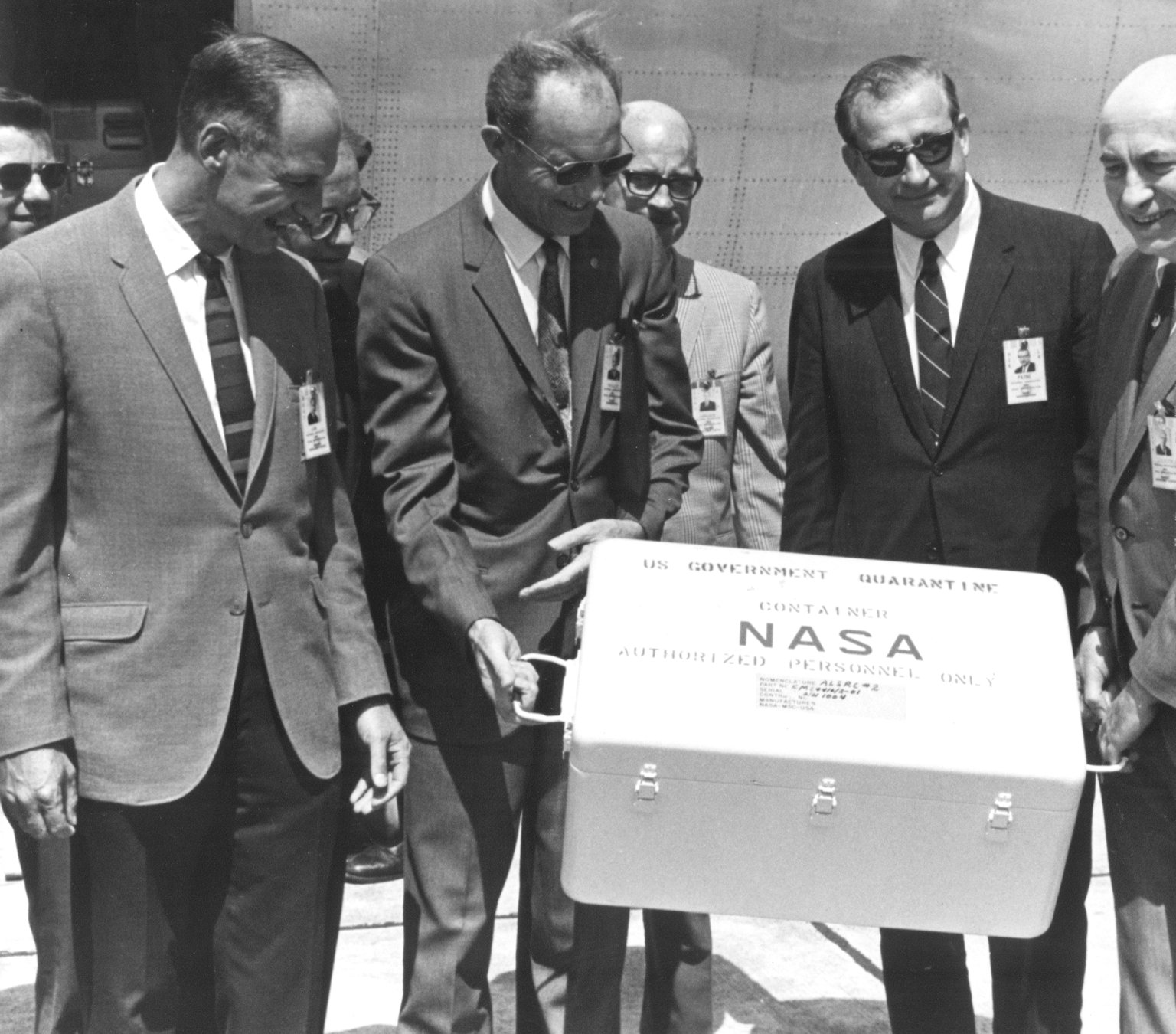
NASA officials had the time to pose for photographs with the newly delivered lunar rock container containing the lunar samples. Thomas Paine and Robert Gilruth at the right.
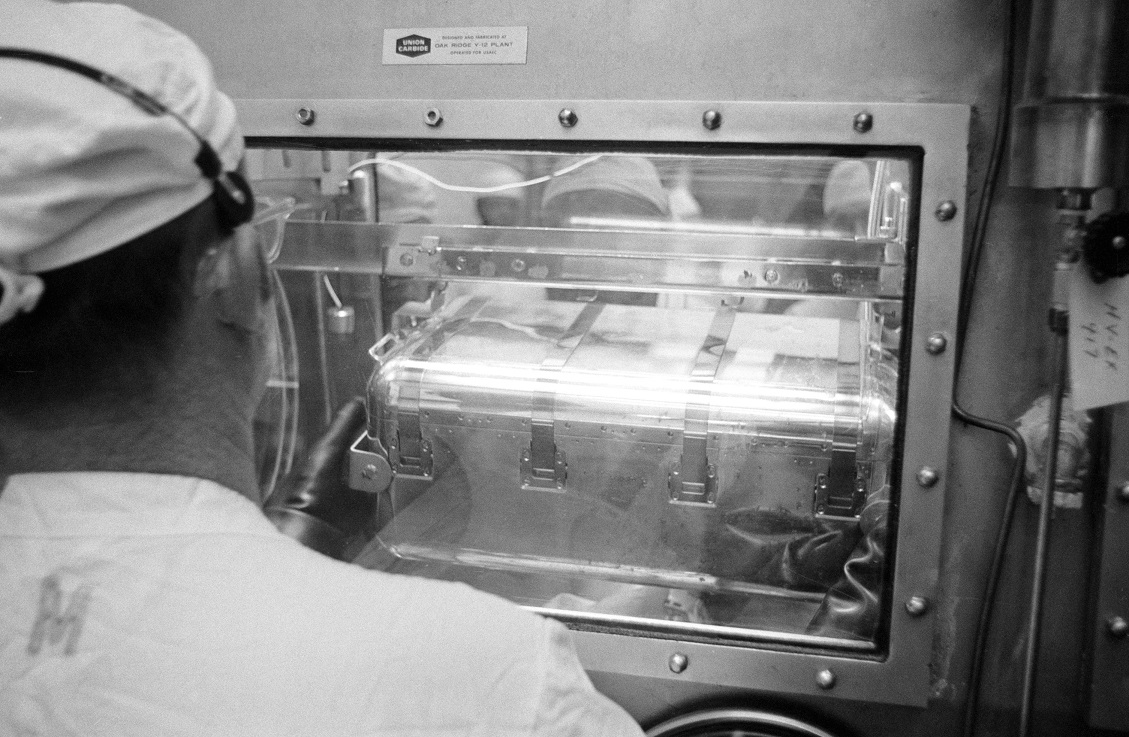
The first Sample Container being opened at the High Vacuum Complex. A sticker on the cabinet declares it a UNION CARBIDE product, constructed at the Y-12 plant, Oak Ridge, Tennessee.
After external sterilization, the sample containers were taken into the vacuum chamber. First, a special probe was inserted into the rock box through the seal to bleed out any possible gases from within to be analysed.
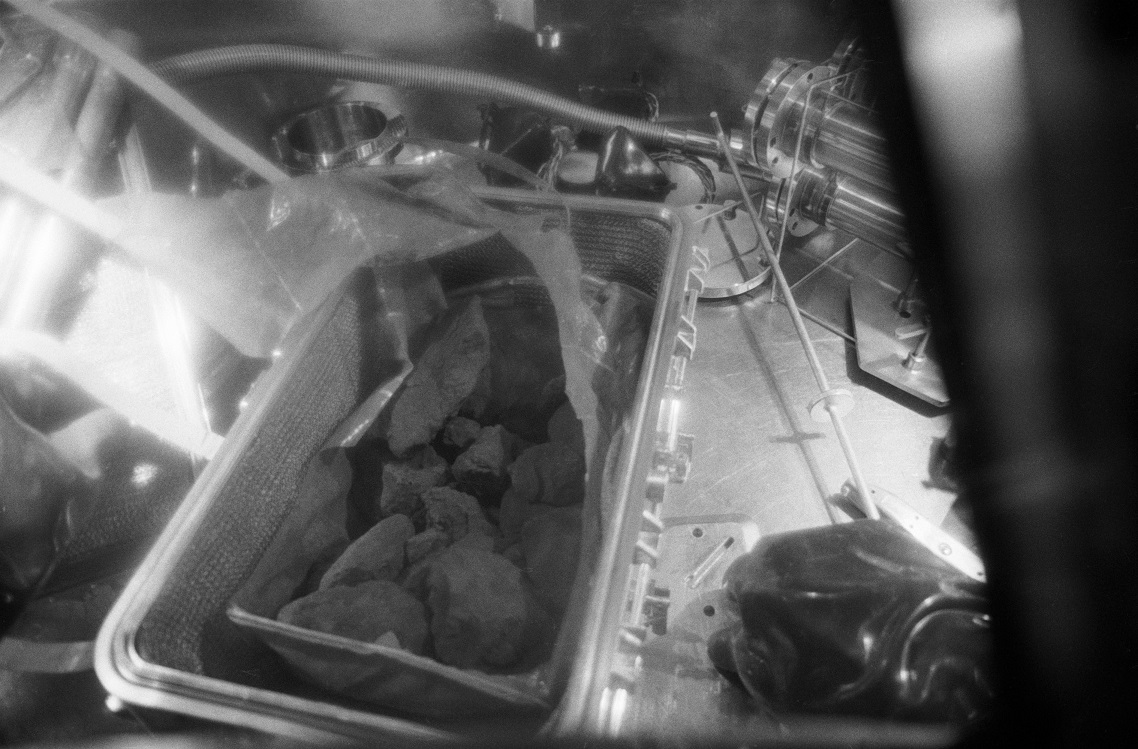
Apollo Sample Return Container open inside a vacuum chamber.
The contents of each rock box was carefully inventoried at the first opportunity. Time critical samples for the Radiation Counting Laboratory and for the biological analysis were procured as quickly as possible.
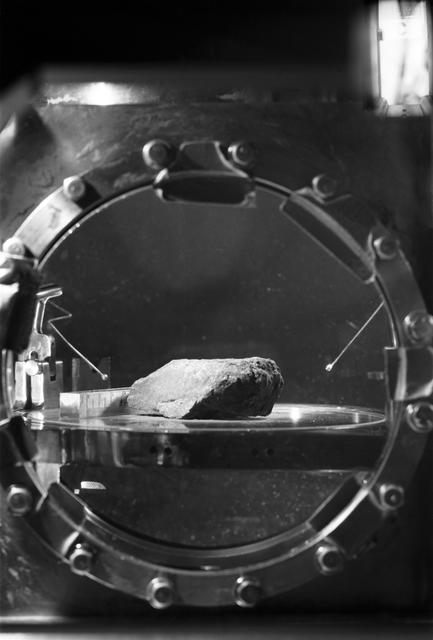
The first lunar rock sample begins investigation - named 10003.
Once each sample was recorded separately, individual analysis began in the F-201 chamber. The lunar samples were photographed from six angles using cameras on the top of the vacuum chamber. A scale inside the chamber was used to weigh the sample. The surface was also examined with a microscope. Some rocks were split and the resulting 'daughter rocks' were then individually recorded as well.
The cutting edge nature of the High Vacuum Complex not only made it extremely delicate, difficult and expensive to operate, but also unwieldy. After Apollo 12, the requirement for the vacuum isolation of the samples was lifted. A new system was instated that would keep the samples isolated in a sterile, dry nitrogen atmosphere that substituted for the complete vacuum. This physical and atmospheric isolation would still maintain the samples in a pristine condition for testing and analysis, while it eliminated many of the operational problems posed by the High Vacuum Complex. For the rest of the Apollo missions, the returned samples were investigated primarily in the nitrogen system.
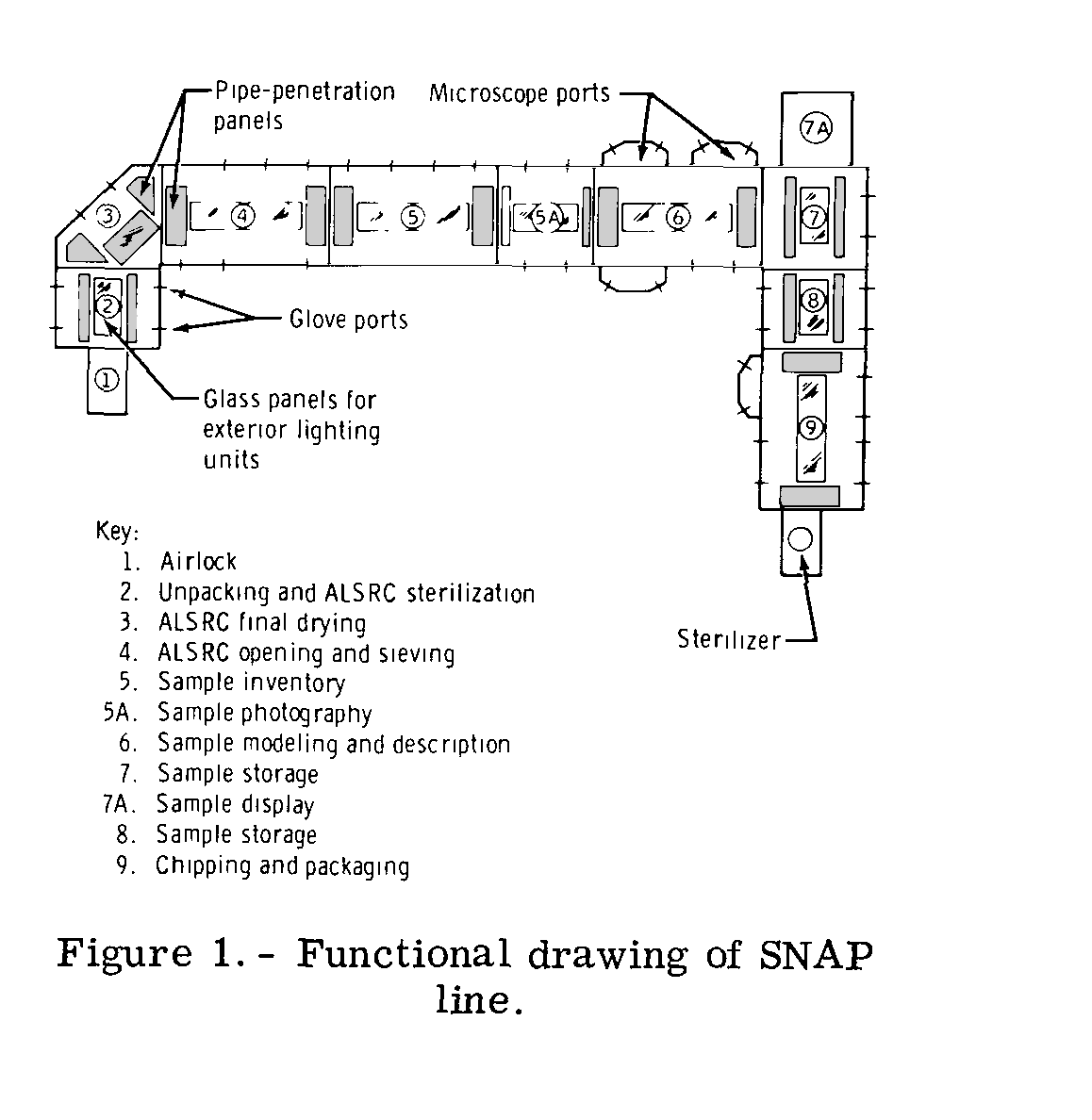
The Sterile Nitrogen Atmosphere Processing (SNAP) line (diagram)
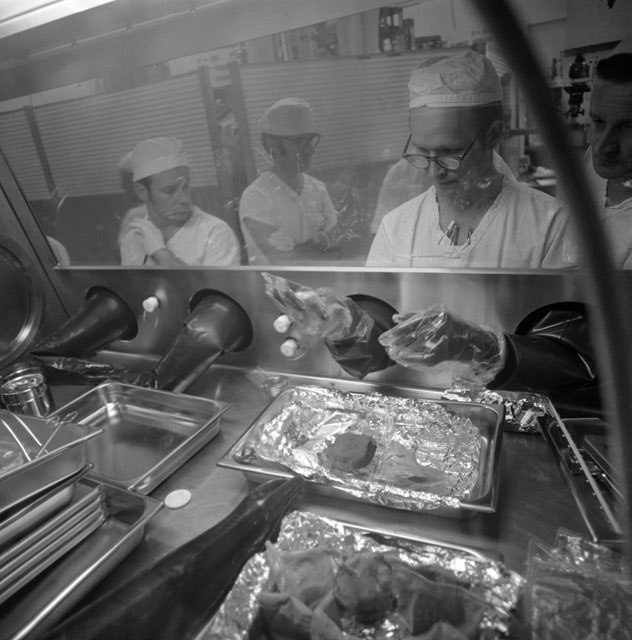
Initial assessment of lunar samples in the nitrogen containment cabinet. Investigation inside the nitrogen cabinets still took place within sterile, oxygen-free conditions. All materials within had to be able to withstand these requirements. Tin foil was found to be a useful solution to dust and particles flying around while the rocks were handled or split.
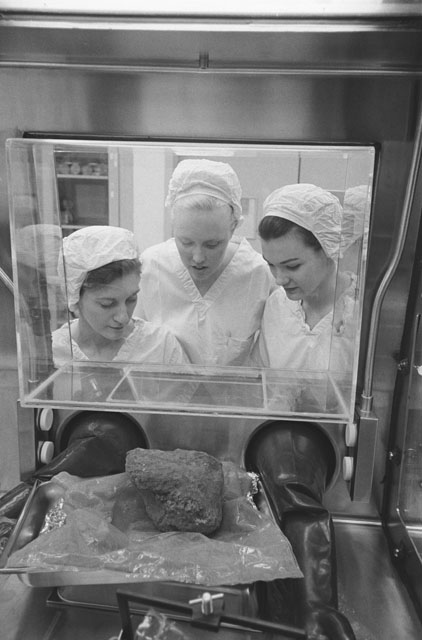
A particularly large Apollo 14 lunar rock is examined by technicians.
The First Men to the Moon and Back
Mission: Apollo 11 (G-1)
Duration: 16-24 July 1969
Crew: Neil Armstrong (CDR), Michael Collins (CMP), Edwin 'Buzz' Aldrin, Jr. (LMP)
Quarantine period: 24 July to 10 August 1969
Lunar samples: 21.55 kg (47.51 pounds) - from the Sea of Tranquillity
After years of preparations, planning, simulations and training, all that remained missing were astronauts and Moon rocks to study. The 8-day mission of Apollo 11 finally fulfilled the effort that had taken the whole decade, and the effort and work of 400,000 people. It came as a great relief that the three-man crew of Armstrong, Collins and Aldrin returned safely with a splashdown in the Pacific Ocean on 24 July 1969.
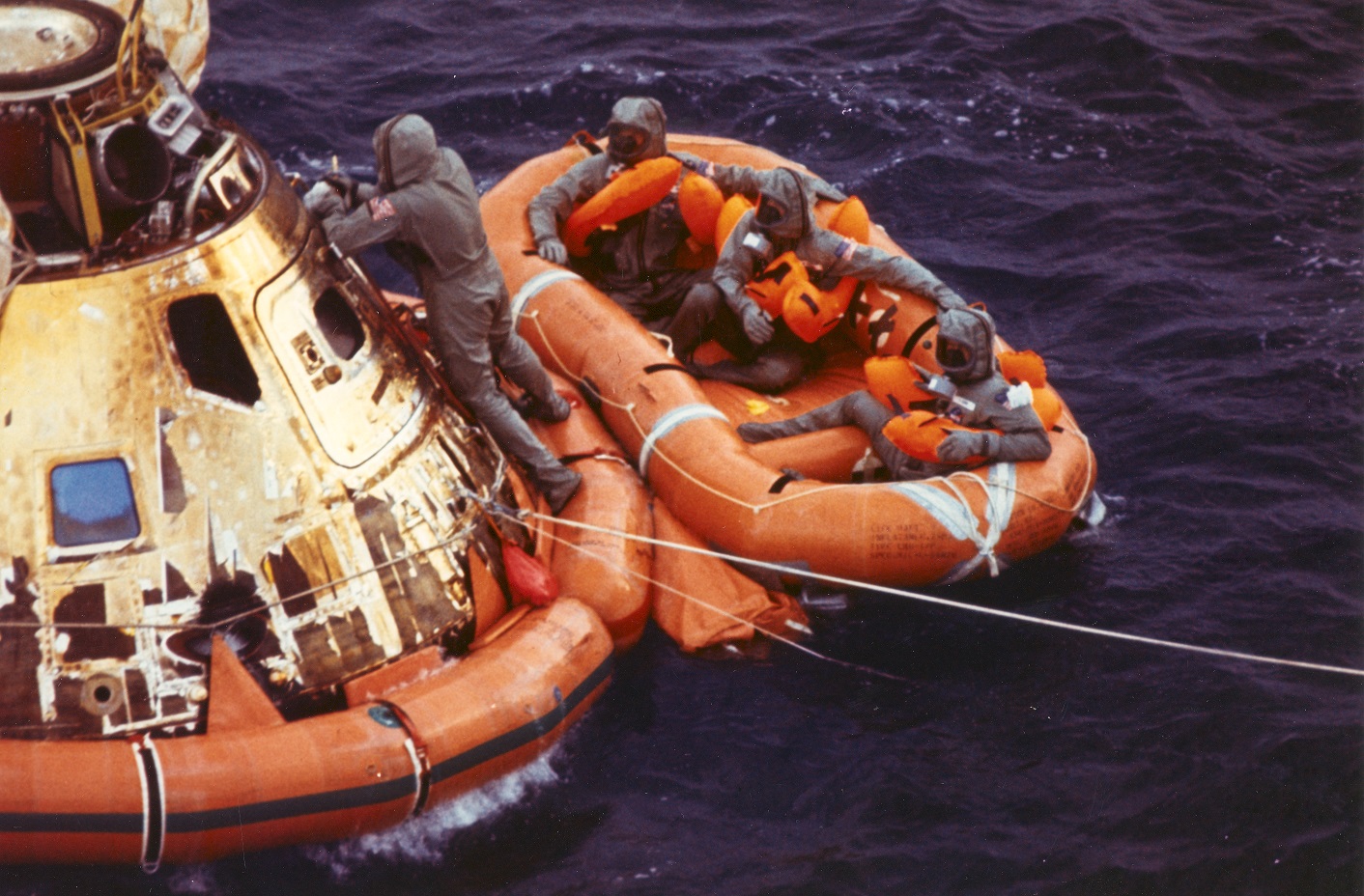
Apollo 11 crew onboard a recovery raft in their BIG suits.
The return to Earth began with the slightly indignant upside down condition of the Command Module, known as Stable II, but this did not cause danger to the crew. Rescue divers from the aircraft carrier USS Hornet arrived to the scene almost immediately and began the recovery operation. The hatch was washed with Betadine (a iodine-based disinfectant) and the BIG suits were passed over to the crew inside the cabin. Besides sea water, the Apollo trio was met with a bath of sodium hypochlorite (bleach), that was also used to disinfect that rescue drafts and the associated equipment. The rafts and flotation gear were sunk into the sea in the hopes that this would deal with any problems they might have posed.
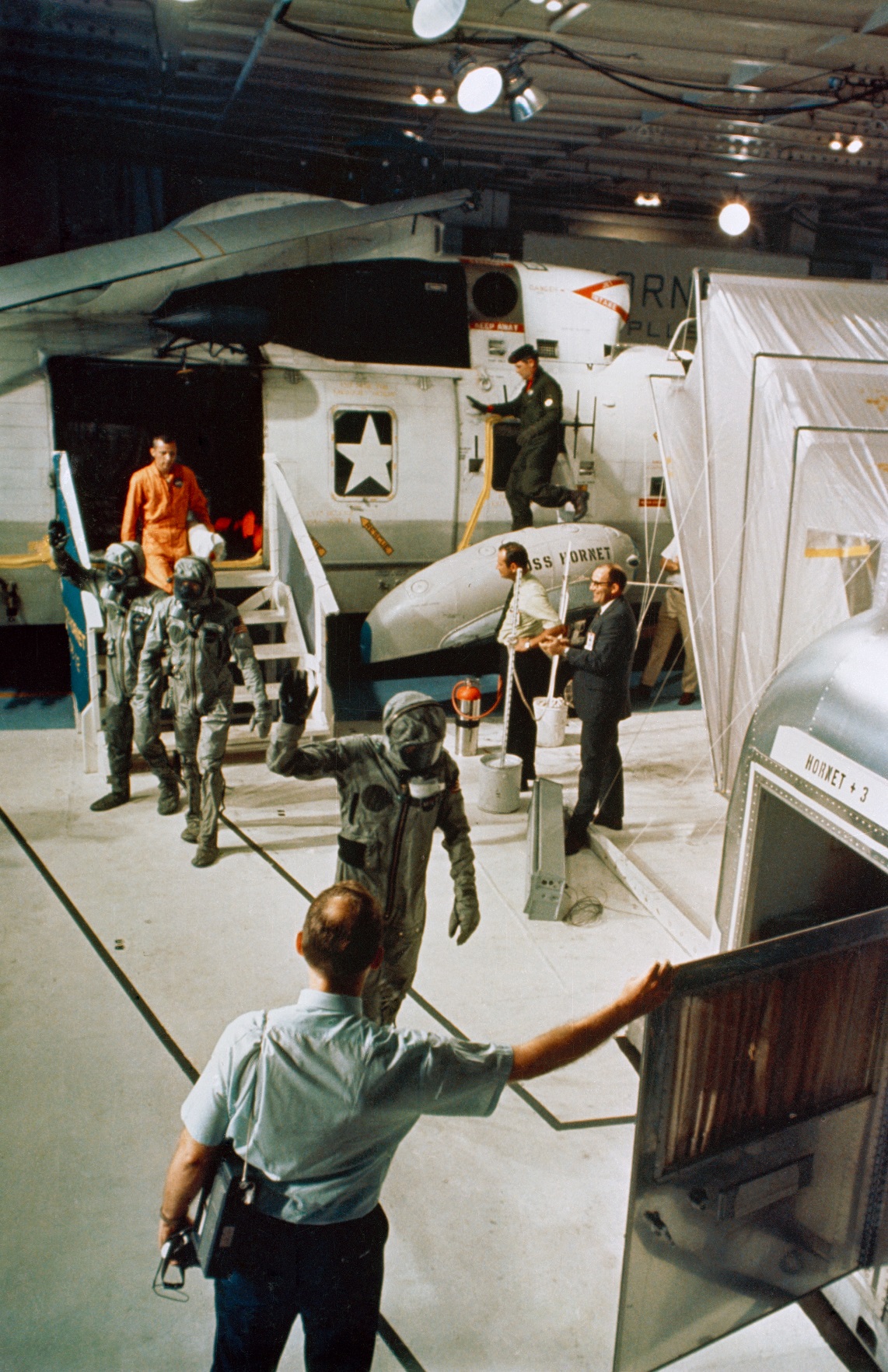
The crew of Apollo 11 crosses the deck from the helicopter and into the MQF. The bio suits and the MQF are in contrast to another element in the biohazard prevention measures - a man in a tie with a mop and a bucket.
The helicopter recovery of the crew was perfectly safe. The helicopter and the footpath taken by the crew on their way to the awaiting Mobile Quarantine Facility was disinfected by applying large amounts of glutaldehyde. A recovery technician and a doctor joined the three astronauts in the MQF trailer.
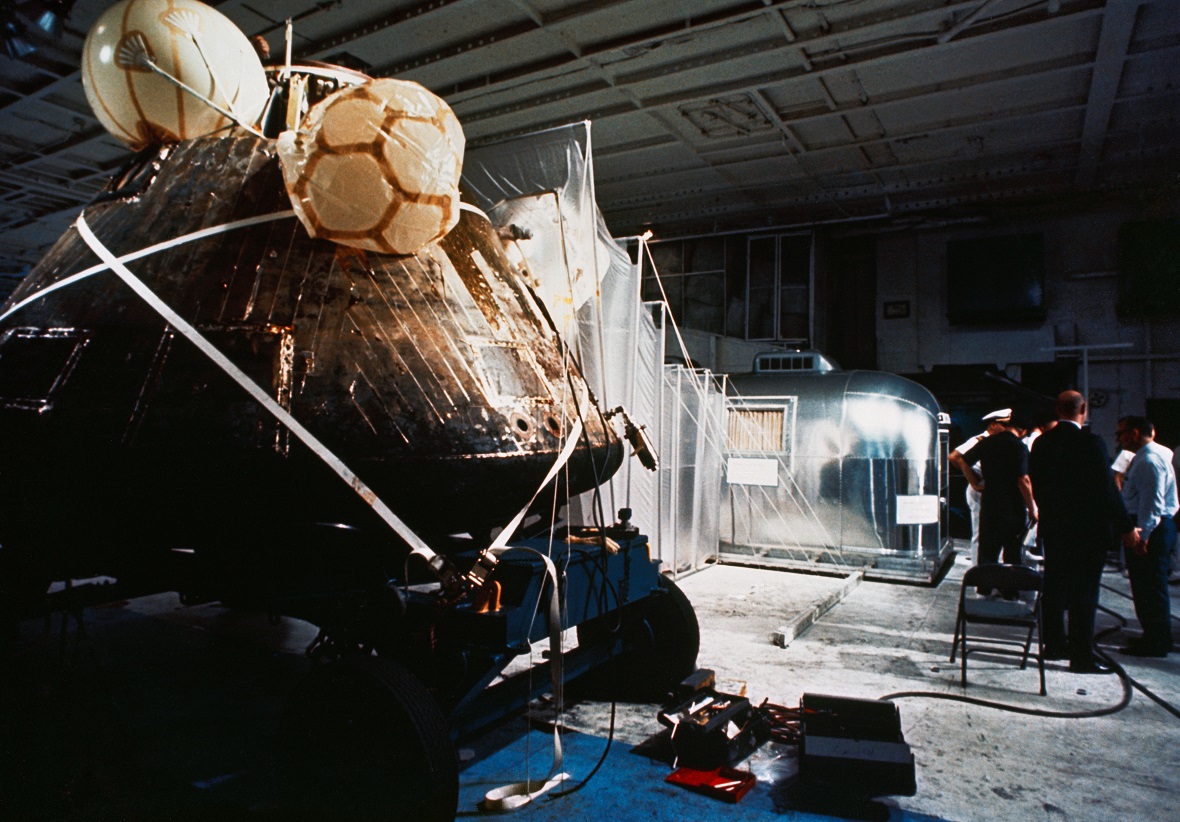
Command Module Columbia connected to the MQF via the transfer corridor.
As per the plan, the accordion tunnel was attached and the lunar sample containers, biological samples, film canisters, and the data tapes from the onboard recorders were removed. These were later passed through the sterilization airlock in the MQF to the carrier crew, and sent by two different planes to Houston in order to hurry the samples for analysis.
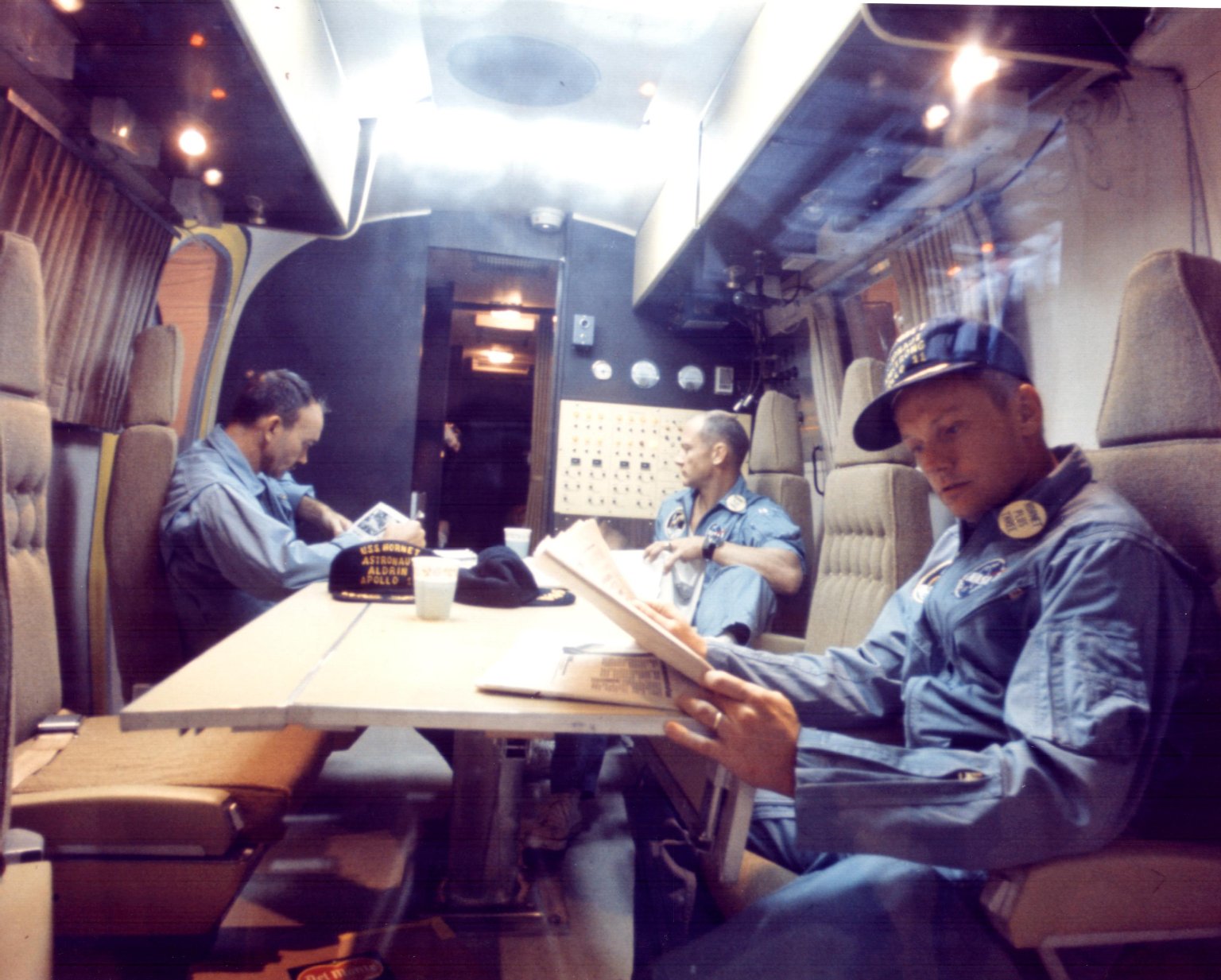
The Apollo 11 crew photographed through the entry door window in the MQF lounge.
Initial medical evaluation showed the crew to be in perfect health after their mission.
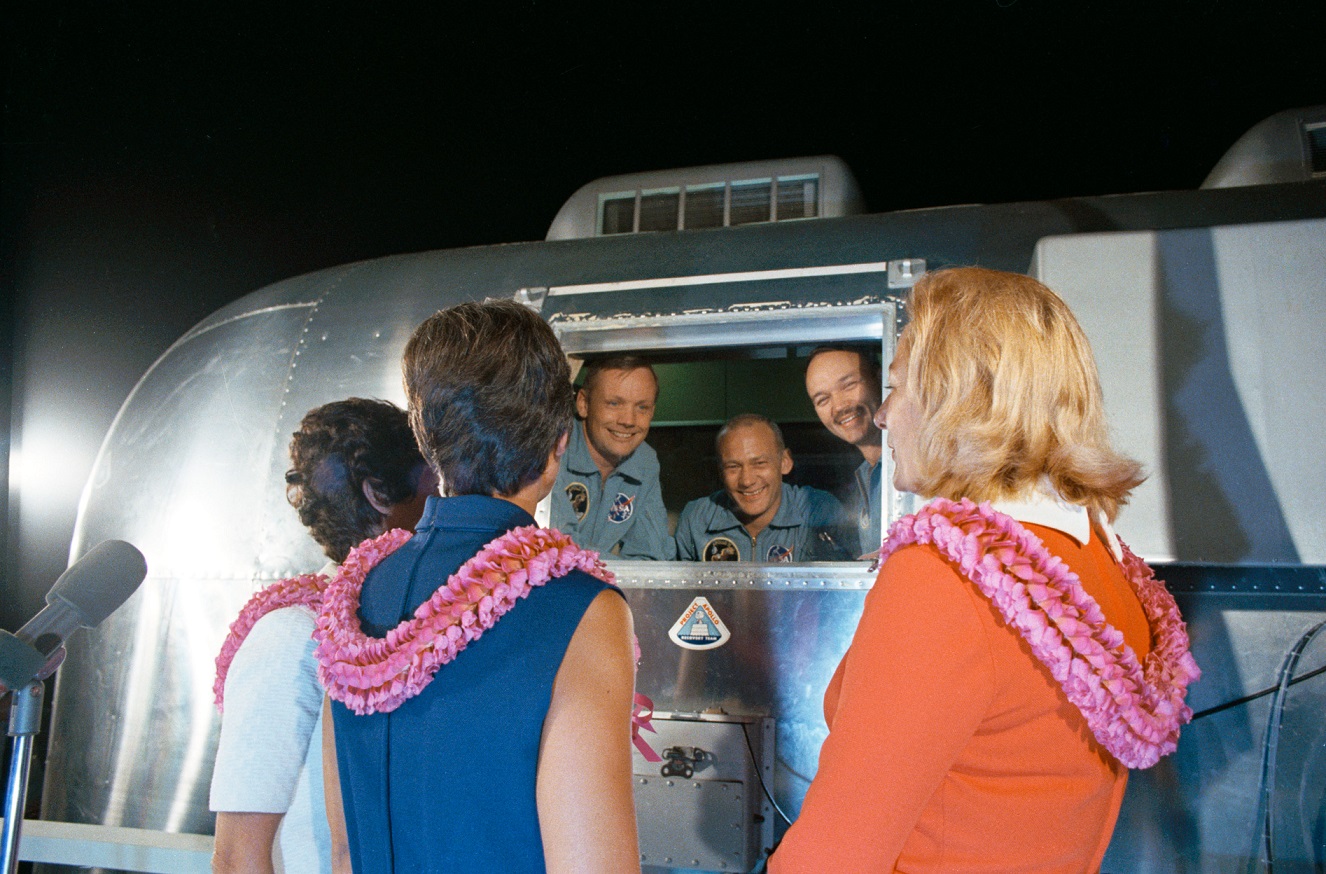
The wives get a glimpse at their husbands, through the MQF window.
The MQF was off-loaded on 27 July and flown to Houston, where they arrived on 28 July. The crew even had a chance to see their better halves at the airport, briefly, before the MQF was transported to the LRL.
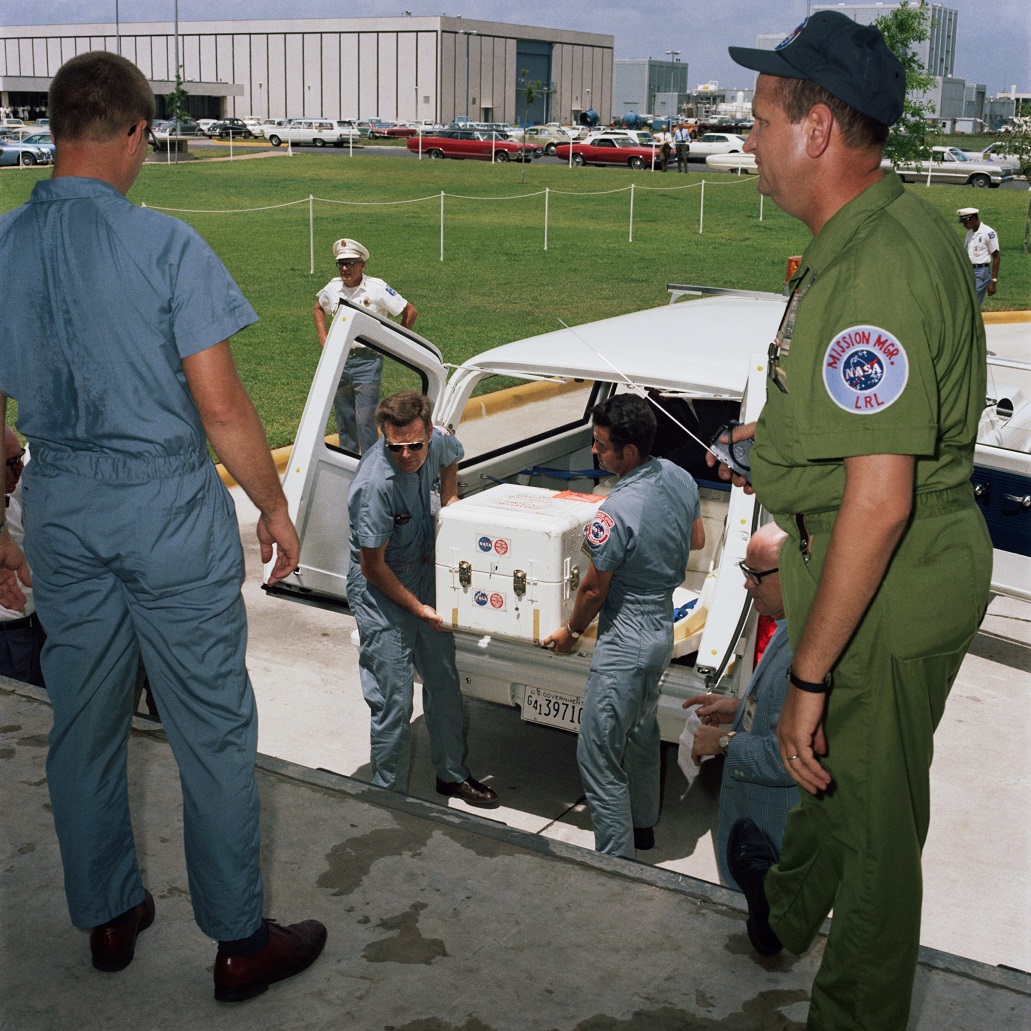
The first lunar samples are brought over to the LRL.
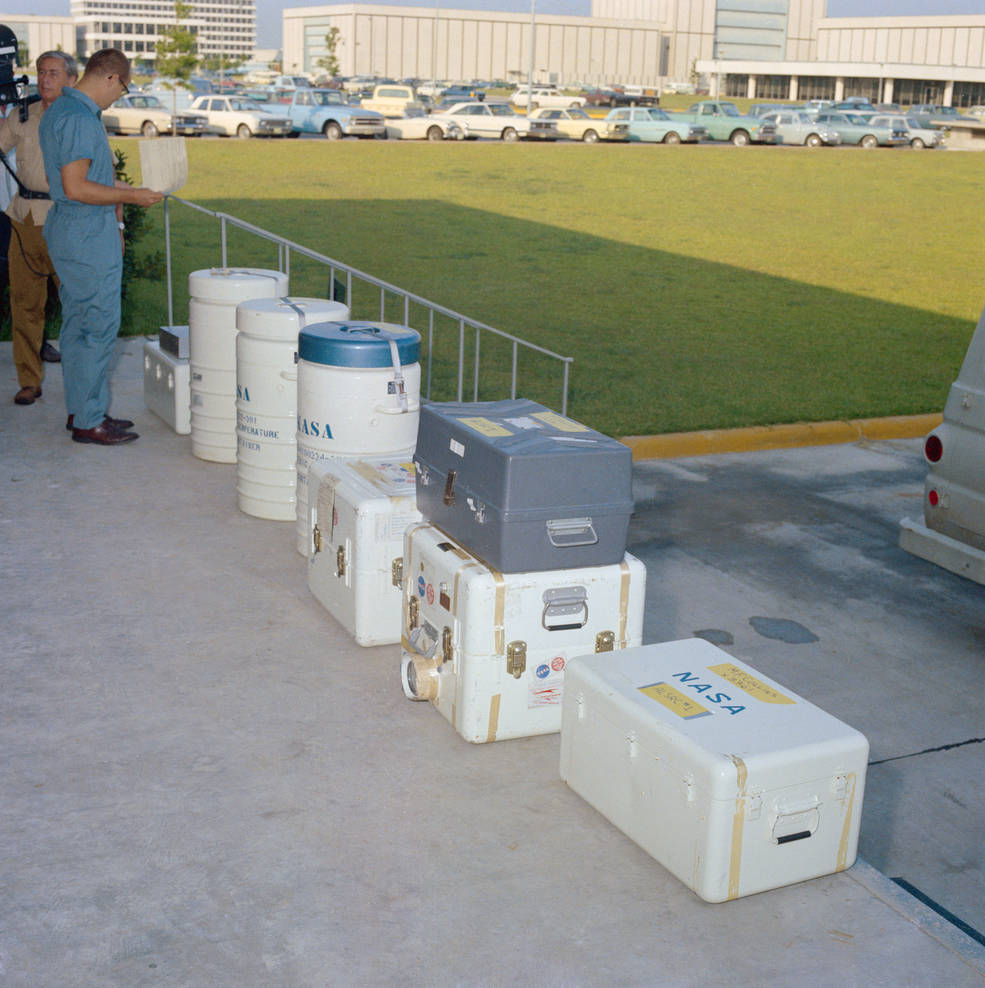
Lunar sample and other containers during LRL simulation. Various sample containers as they would have appeared upon delivery.
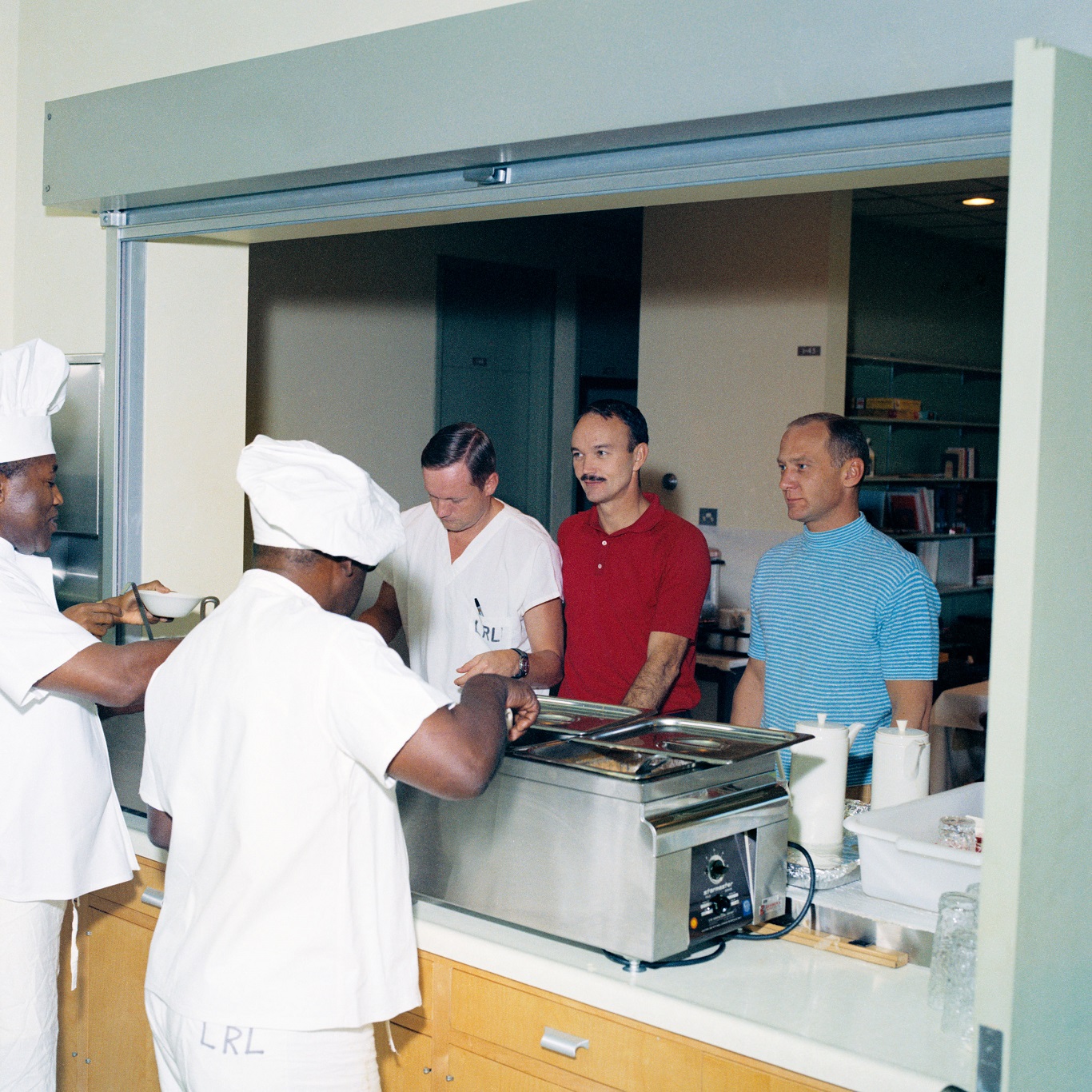
Neil, Mike and Buzz get their lunch.
The days at the Crew Receiving Area were filled with the routines of meals, medical examinations, and rest. No effort was made to isolate the CRA staff from the astronauts, whom were not considered to be contagious - unless they started to show symptoms of any illness.
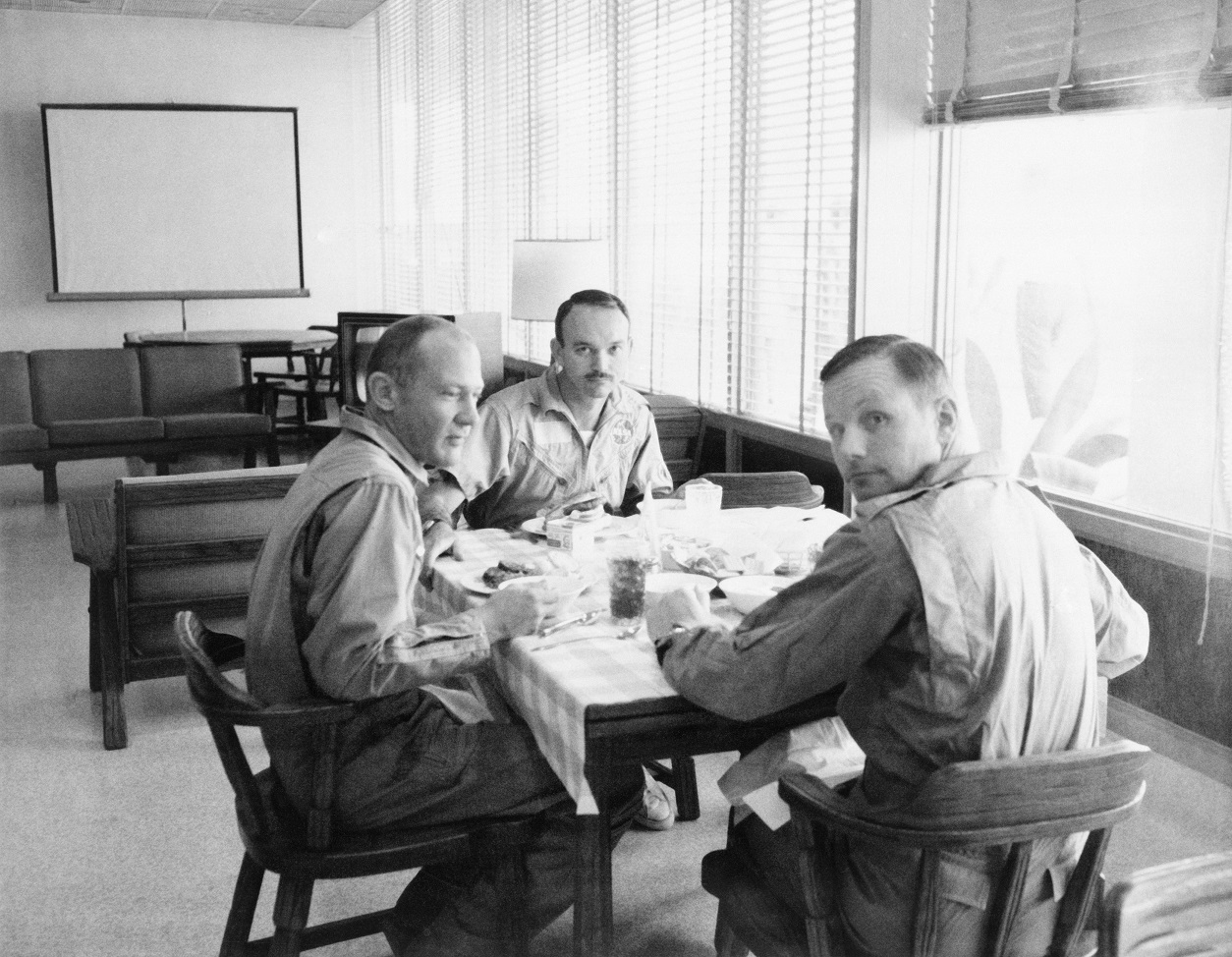
Buzz, Mike and Neil enjoy the comforts of home at the Crew Reception Area.
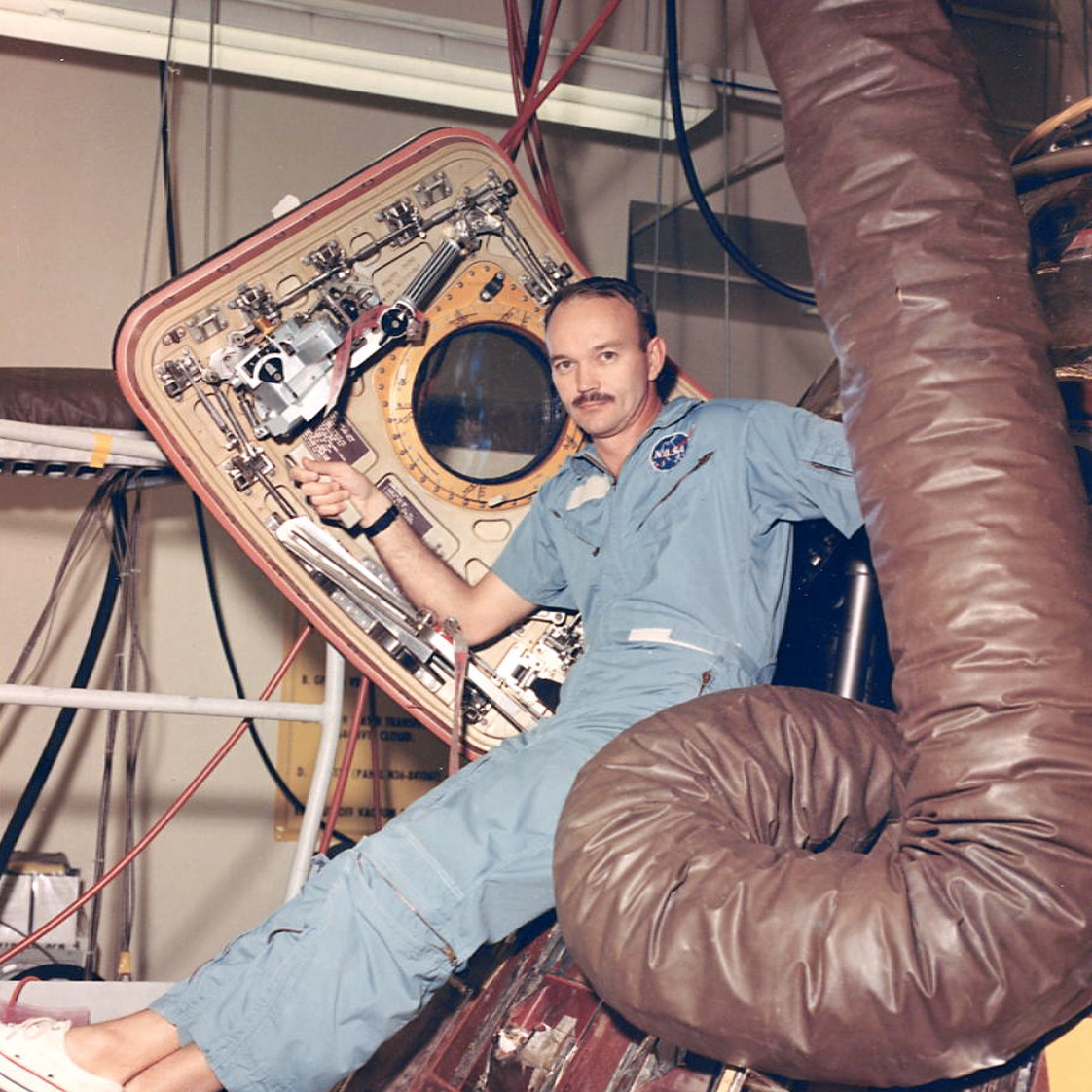
Mike Collins at the CM hatch. The Command Module Columbia arrived at the LRL on 30 July.
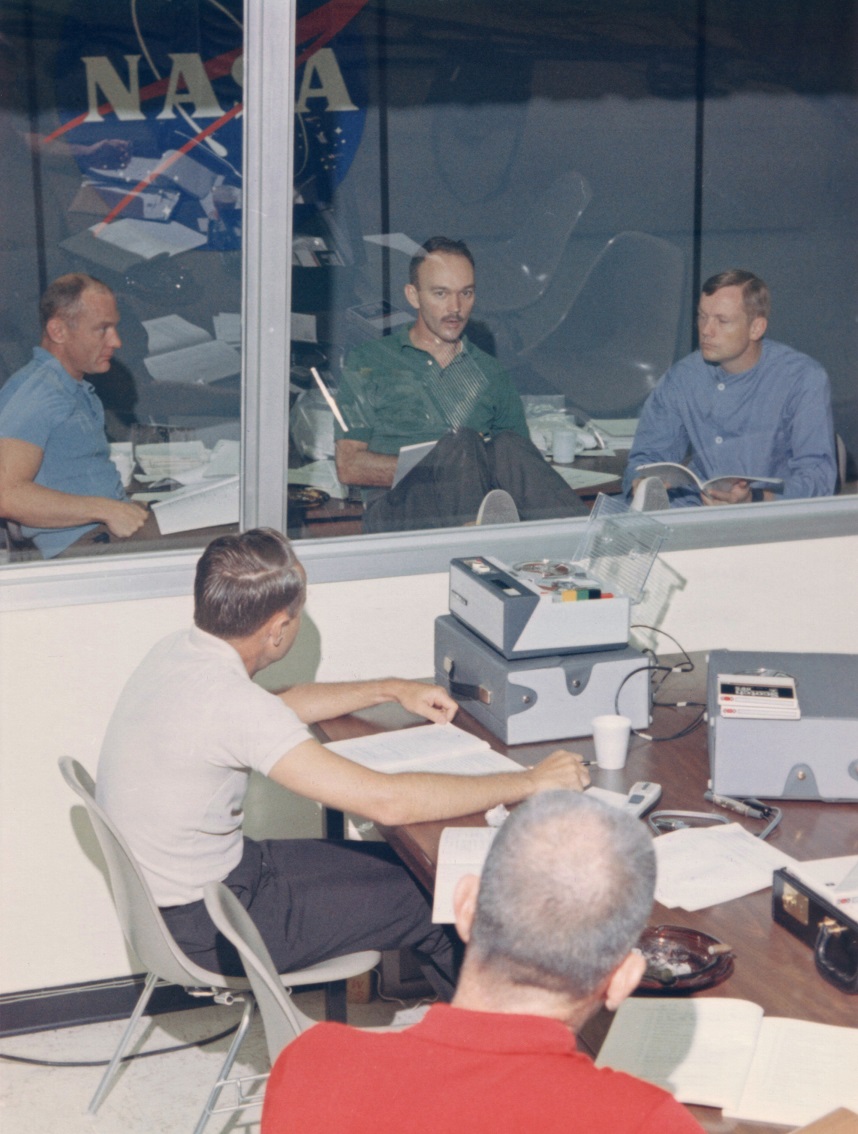
Debriefing at the LRL. Debriefing of the crew commenced almost as soon as they arrived. The interviews were presided over by Deke Slayton, the Director of Flight Operations. Although this was an important event, the relaxed poses suggest that things were not taken too seriously.
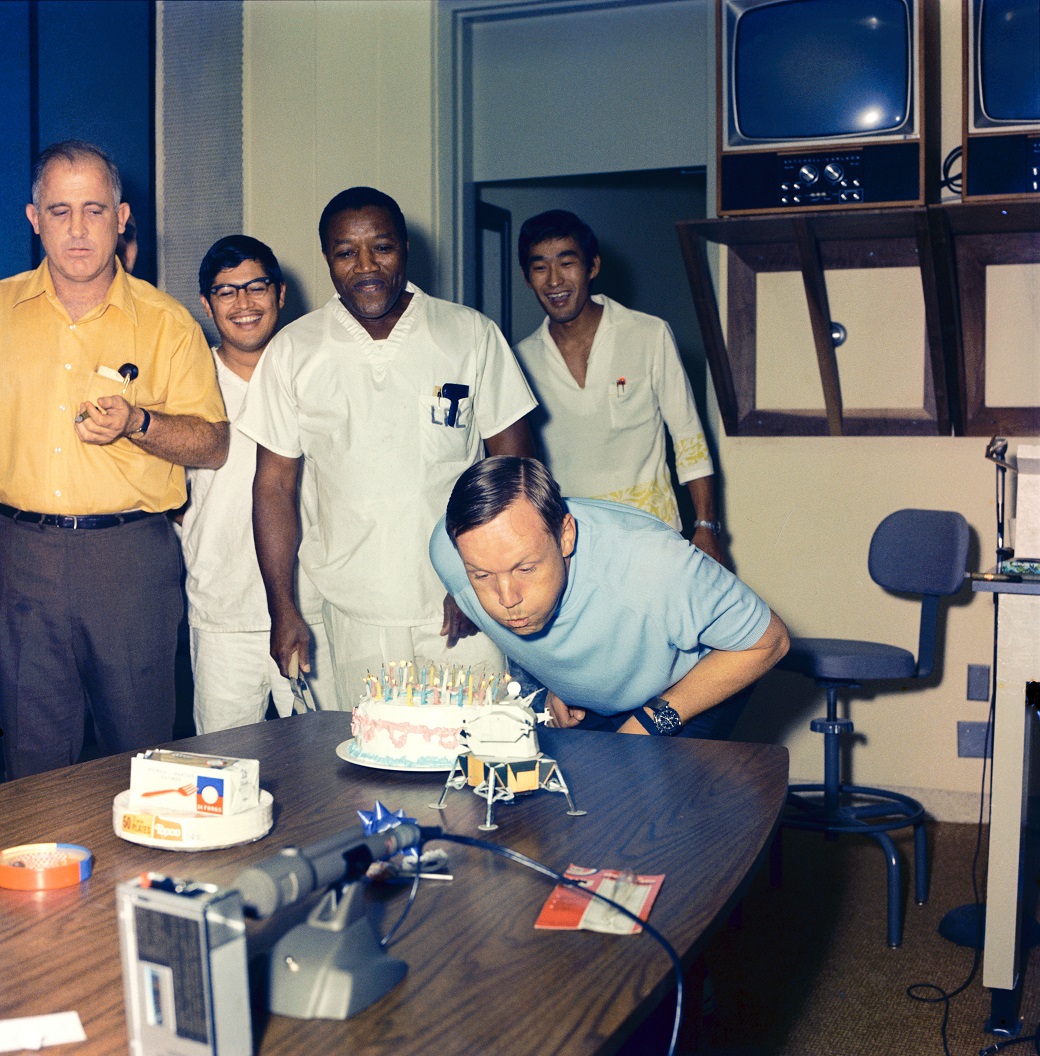
Neil's birthday party while in quarantine.
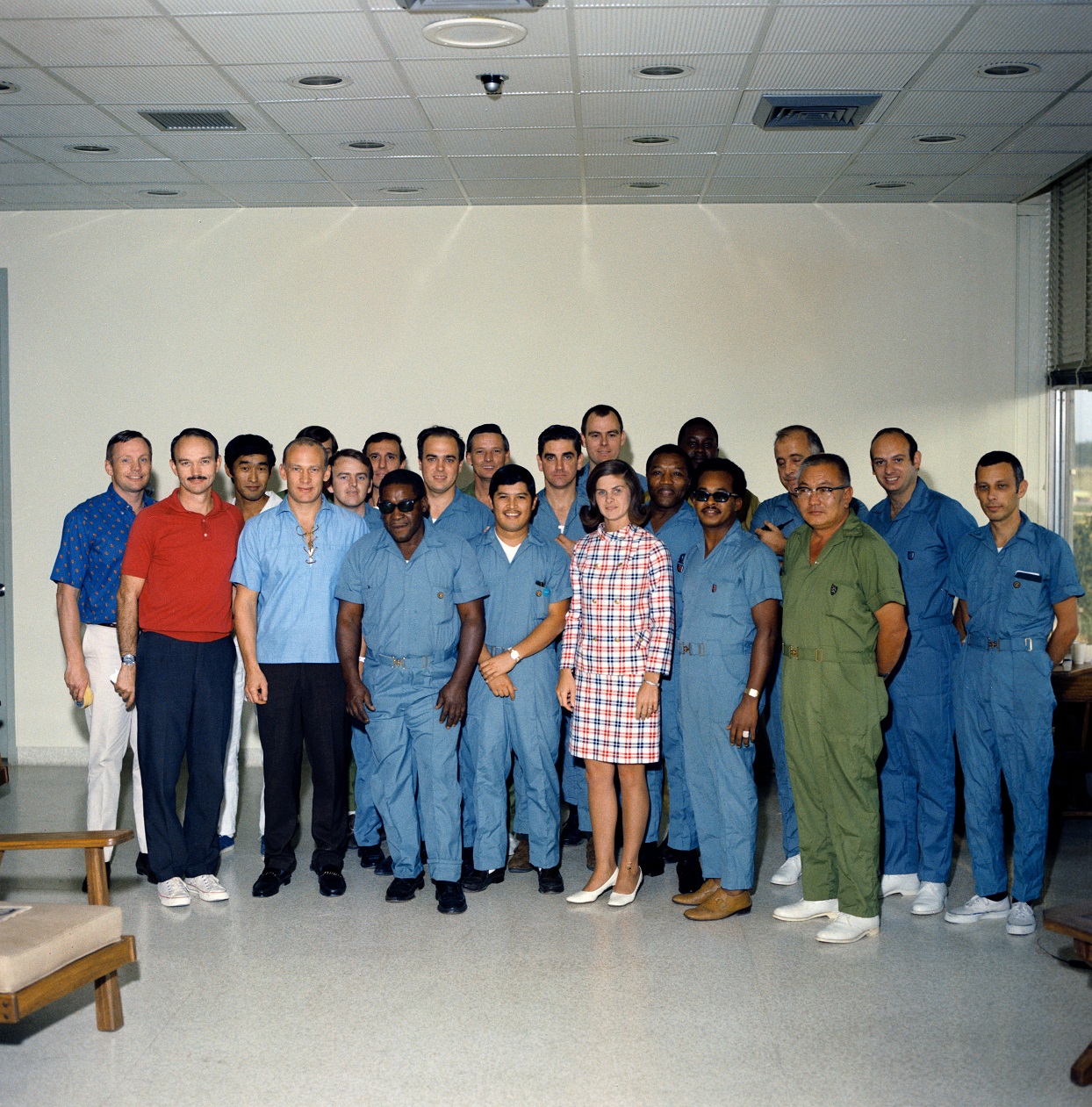
The staff of the Crew Reception Area and the astronauts pose at the end of the quarantine
Besides the crew, also in the quarantine were the flight surgeon and the technician who had joined them already at the recovery ship, as well as the CRA staff. A few lab staff members had had to join their ranks due to breaches in the sample containment.
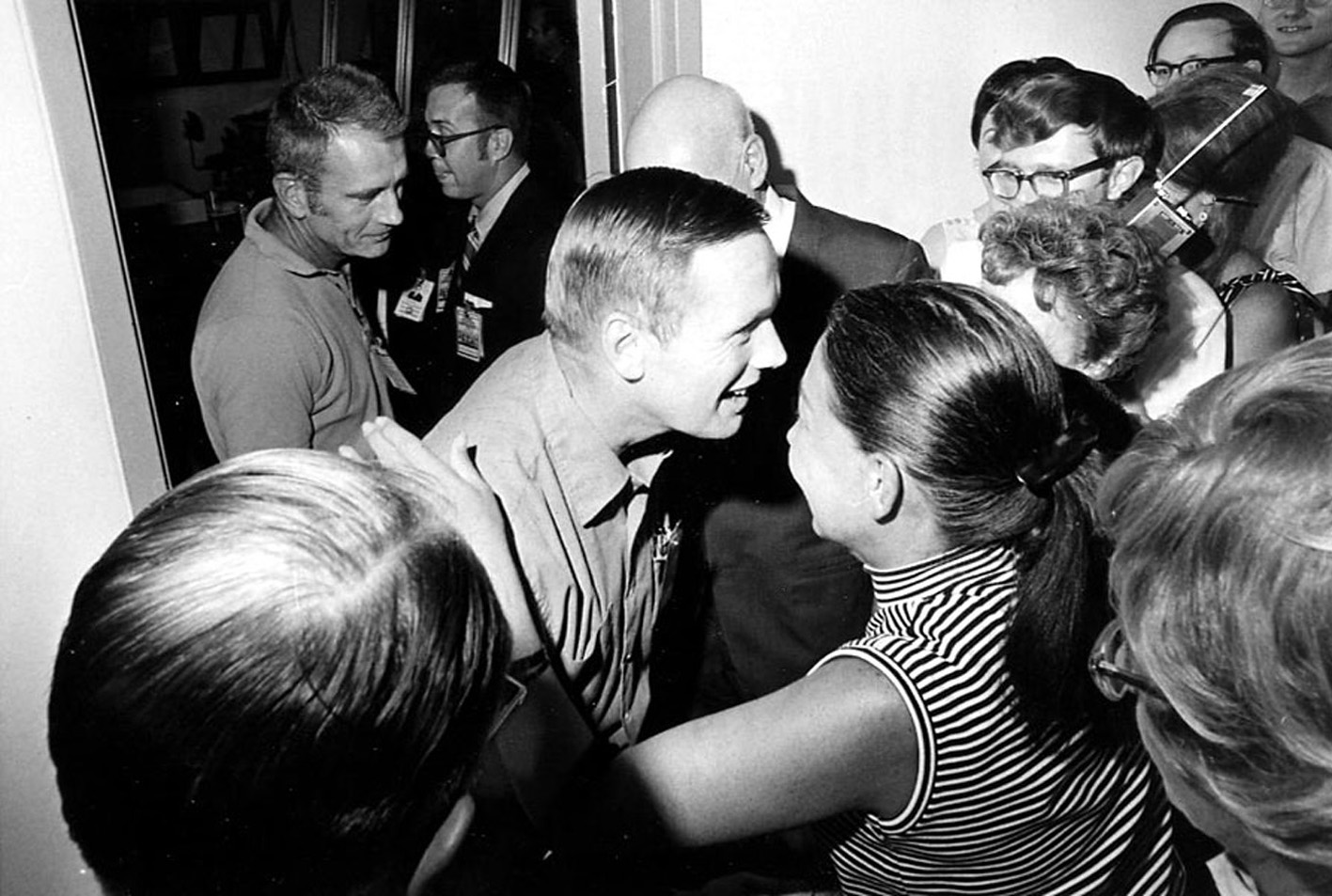
Neil steps out of isolation, with Deke Slayton in tow.
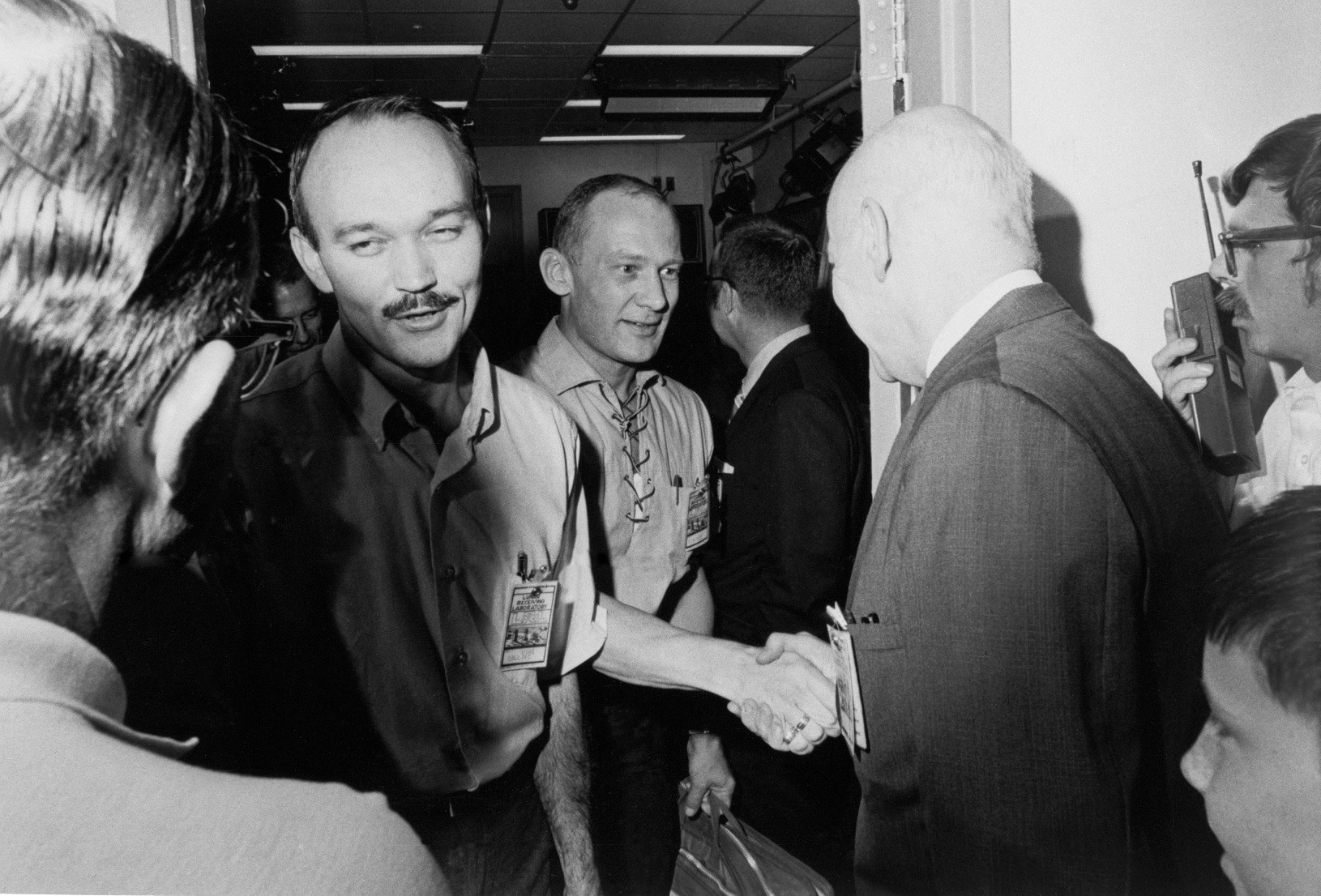
A whiskered Michael Collins steps out of quarantine. Buzz Aldrin is shaking hands with NASA administrator Gilruth. The quarantined crew left the CRA very early in the morning in the hopes of avoiding media frenzy surrounding their release.
The crew of Apollo 11 was released one day early from the quarantine on 10 August. They were in perfect health and it appeared that the only ill effect from their space flight was a rash caused by the glue that had been used to attach the in-flight ECG electrodes to their chests.
The Bio Challenge
As the work began to analyse the lunar samples for the first glimpse into extraterrestrial geology, the Lunar Receiving Laboratory staff also busied themselves with the more controversial aspect of their mission. To the chagrin of the geologists, a considerable amount of the lunar material had to be allocated for the biological testing that would determine whether it was potentially harmful to human or other Earth life forms. A great number of the scientists were convinced that this was a waste of the scarce lunar material available. Yet these studies were one of the central reasons for the very existence of the LRL facility.
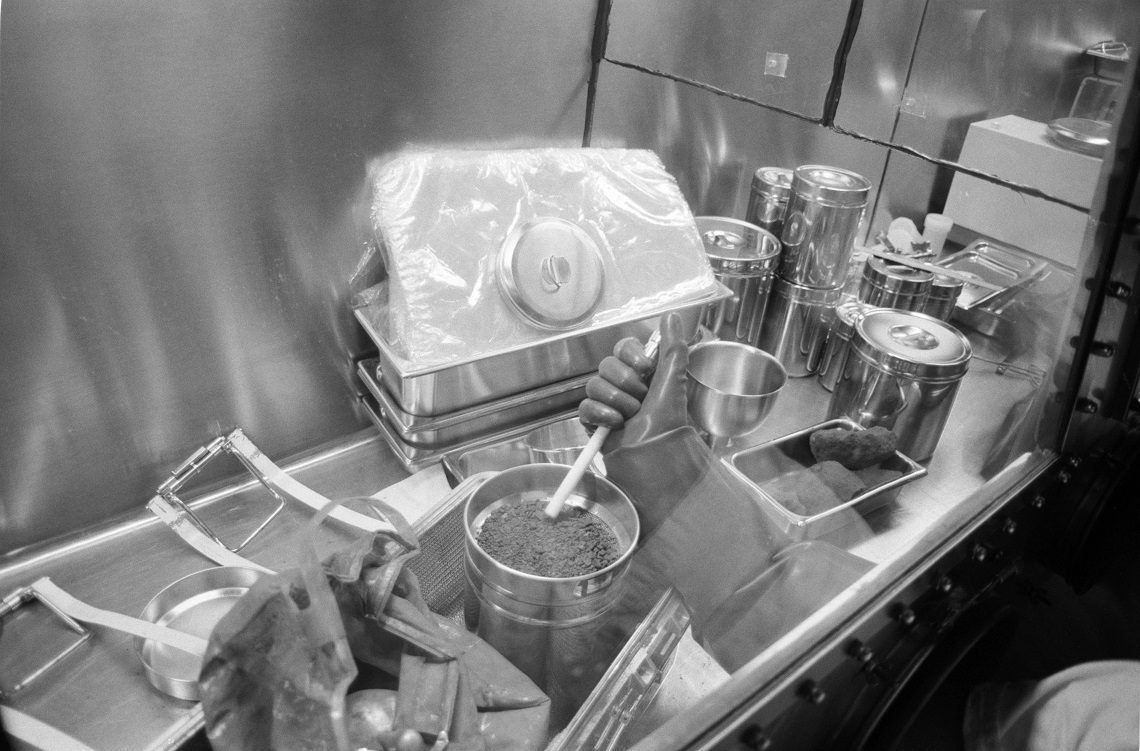
Examining samples being taken out of an opened Sample Return Container. All the equipment used inside the vacuum and nitrogen isolation cabinets had to be able to withstand several hours of heat 'bake out' to sterilize them.
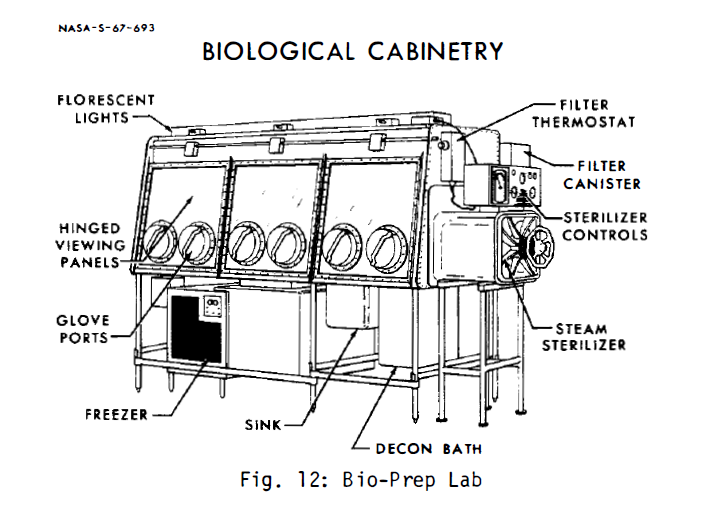
Diagram of the nitrogen cabinets used for biological sample preparation.
Samples of lunar soil were prepared inside isolation cabinets for use in the biological experiments. They were completely separated from the laboratory space outside, accessed through glove ports, and filled with inert nitrogen to ensure sterility.
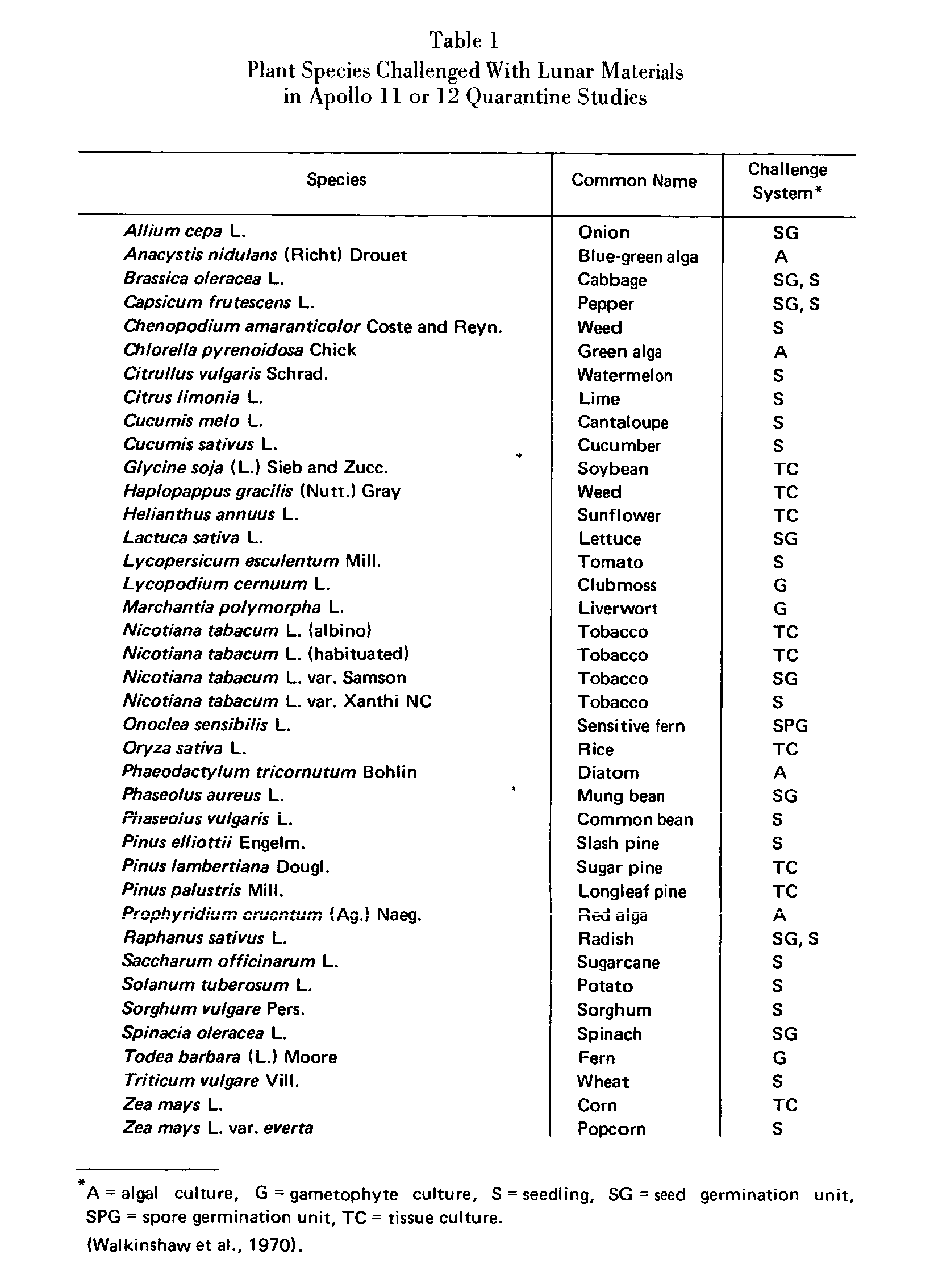
Plant species used in the biological challenge. Biomedical results of Apollo
The plant species used for the biological challenge were selected on the basis of being representative of various forms of plant life found from Earth, as well as their importance to the world economy. The most important food crops, for example, have been so heavily cross bred throughout the centuries to maximise productivity that consequently the species have grown more sensitive to infection. A single particularly virulent pathogen could potentially destroy every single example of the species. Should it have been revealed that lunar material had the potential to do such damage, the results could have been disastrous. Hence crops like wheat and corn as well as tobacco and potato were included in the biological test program.
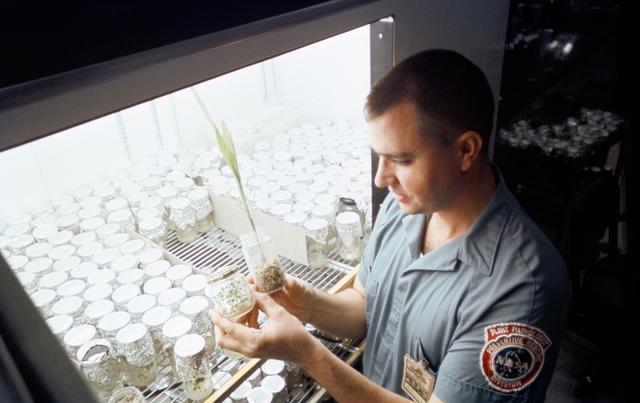
Germ-free plants examined in the support laboratory.
Thus began the experiments on lunar agriculture. Moon dust was added to the soil in which the test species were grown. Studies were made to the metabolism and anatomy of the plants to determine whether any adverse effects could be found due to exposure to lunar material. The results were in fact quite the opposite. Lunar soil is rich in some micronutrients that are sparse in Earth soil, which meant that lunar material acted like a fertilizer and encouraged growth in several of the test species. No infection by moonborne organisms in the lunar material could be found in any of the microbiological assays.
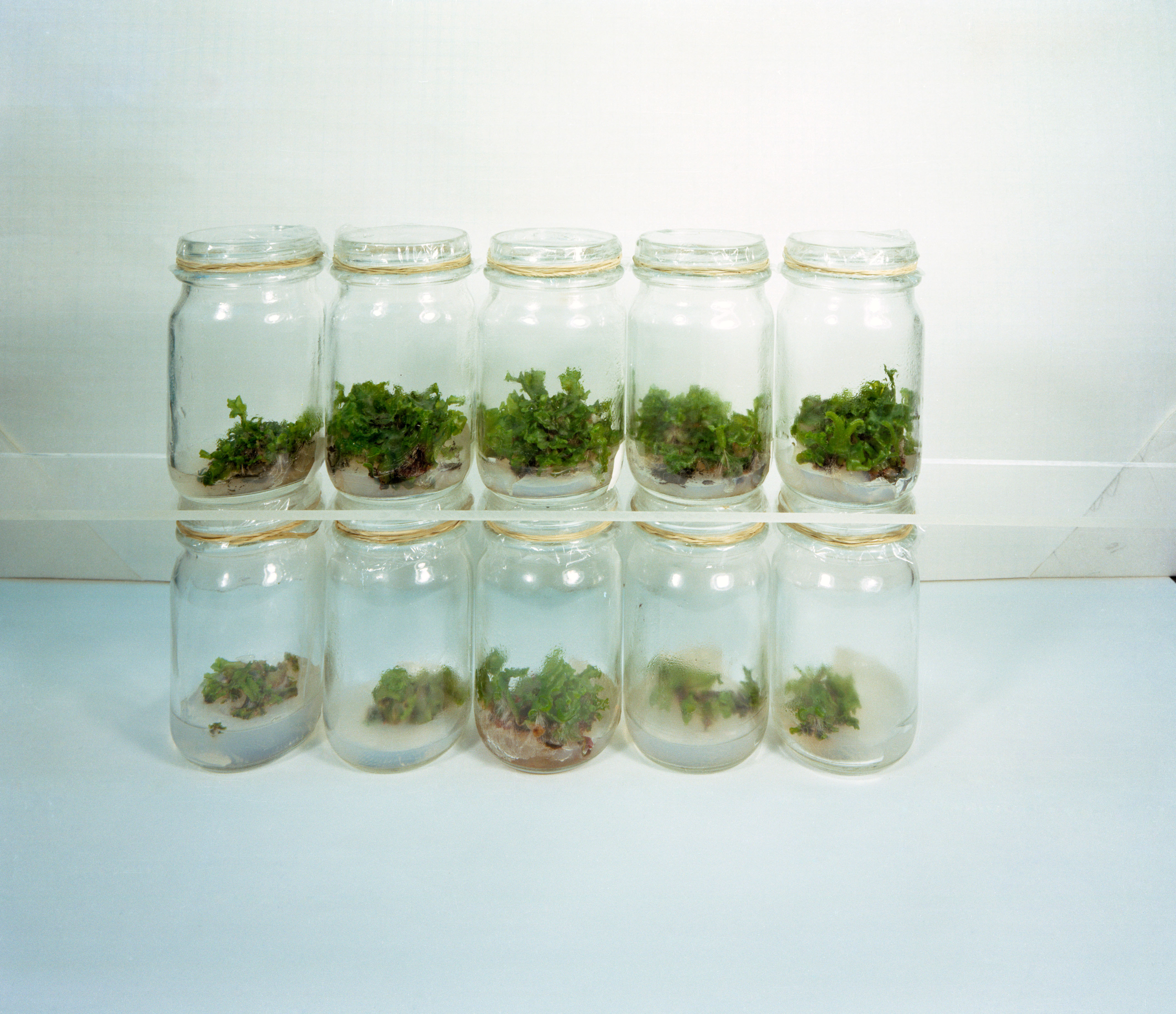
Plants growing in lunar soil.
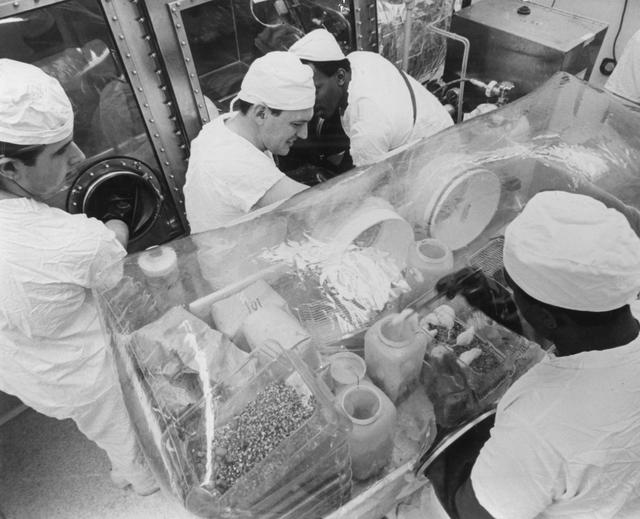
Laboratory mice being handled at the LRL.
Fifteen animal species were used in tests to determine negative effects of lunar material on animal biology, as well as the potential of infection from life forms living in the lunar soil. Exposure happened via various routes. Waterborne animals had the lunar dust simply added to the water tanks that they dwelt in. Other species were directly inoculated with suspensions of lunar material injected into their peritoneal cavity or under the skin. The animals were then investigated for negative effects of such direct exposure, or for the presence of alien microbes replicating in them.
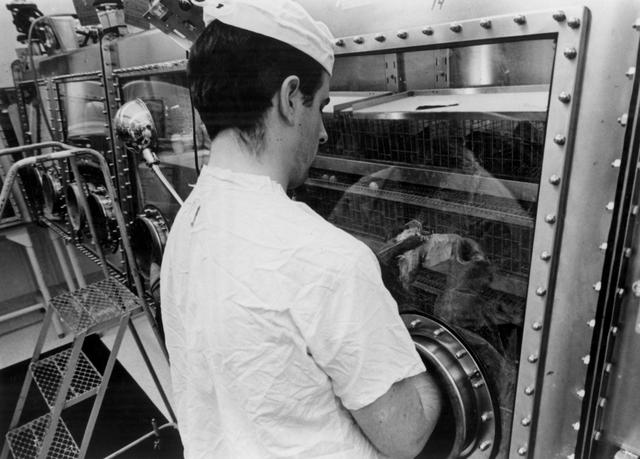
A lab mouse handled inside an isolation cabinet.
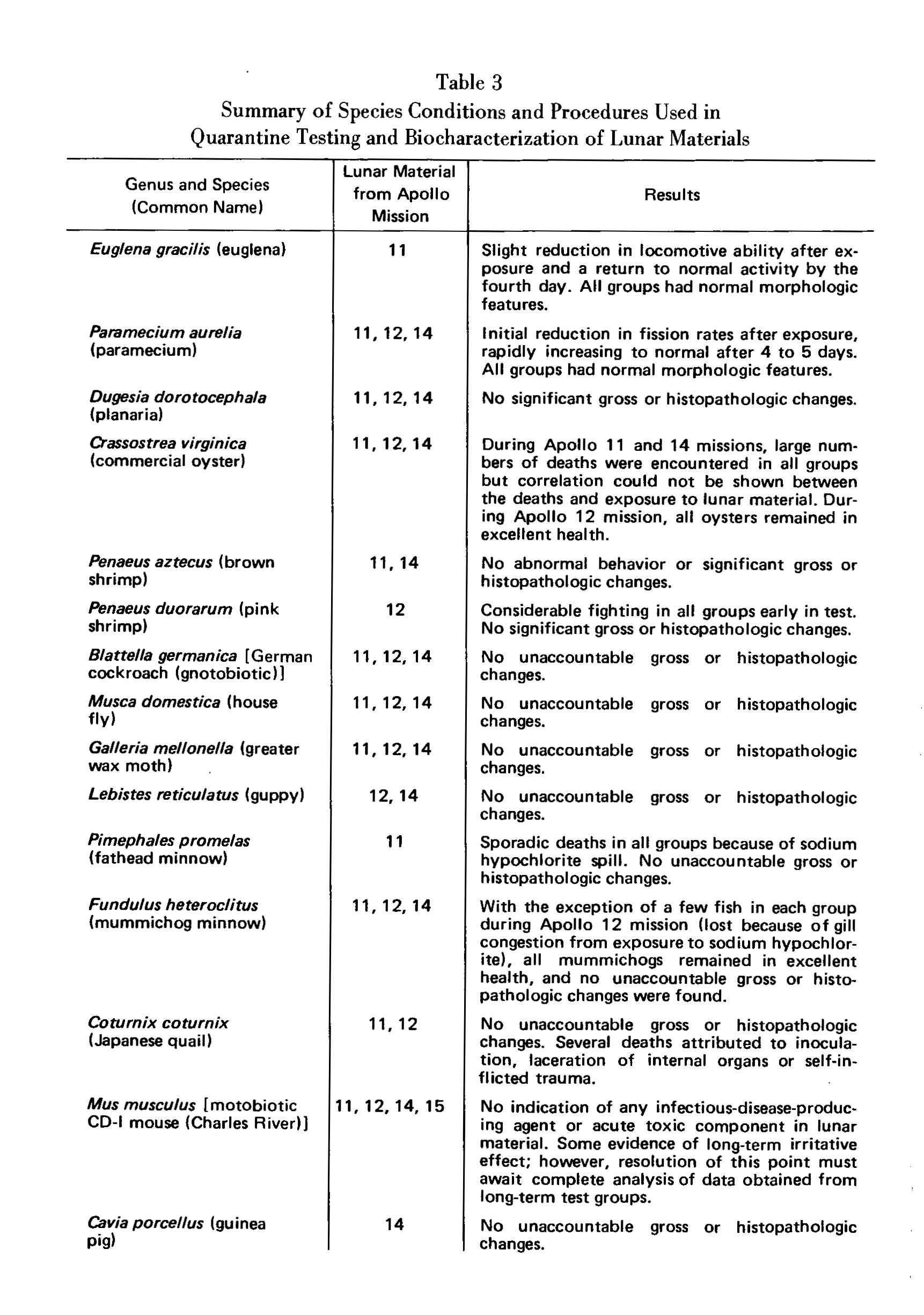
Animal challenge model species. Biomedical results of Apollo
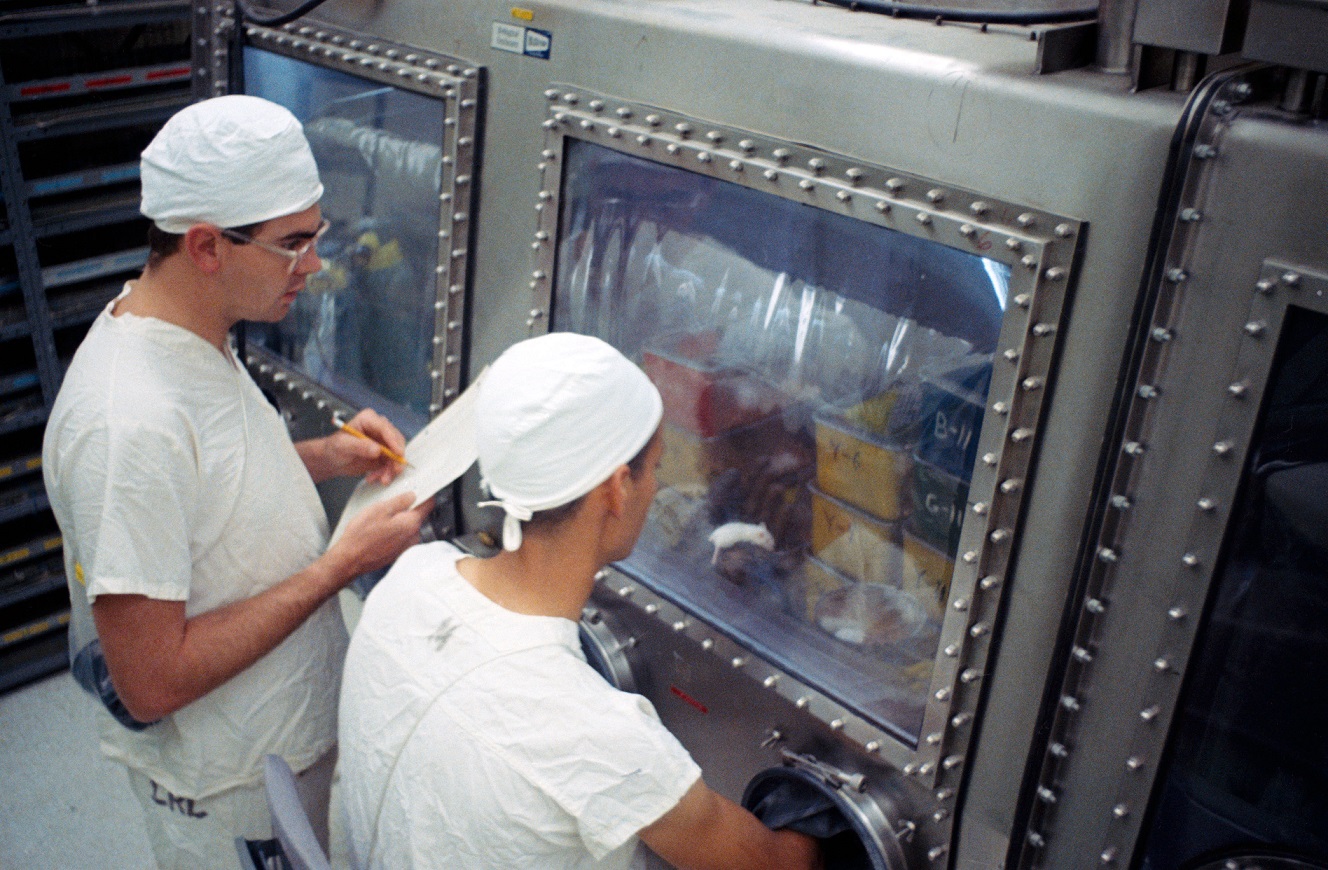
Mice in the isolation cabinet at the biological laboratory.
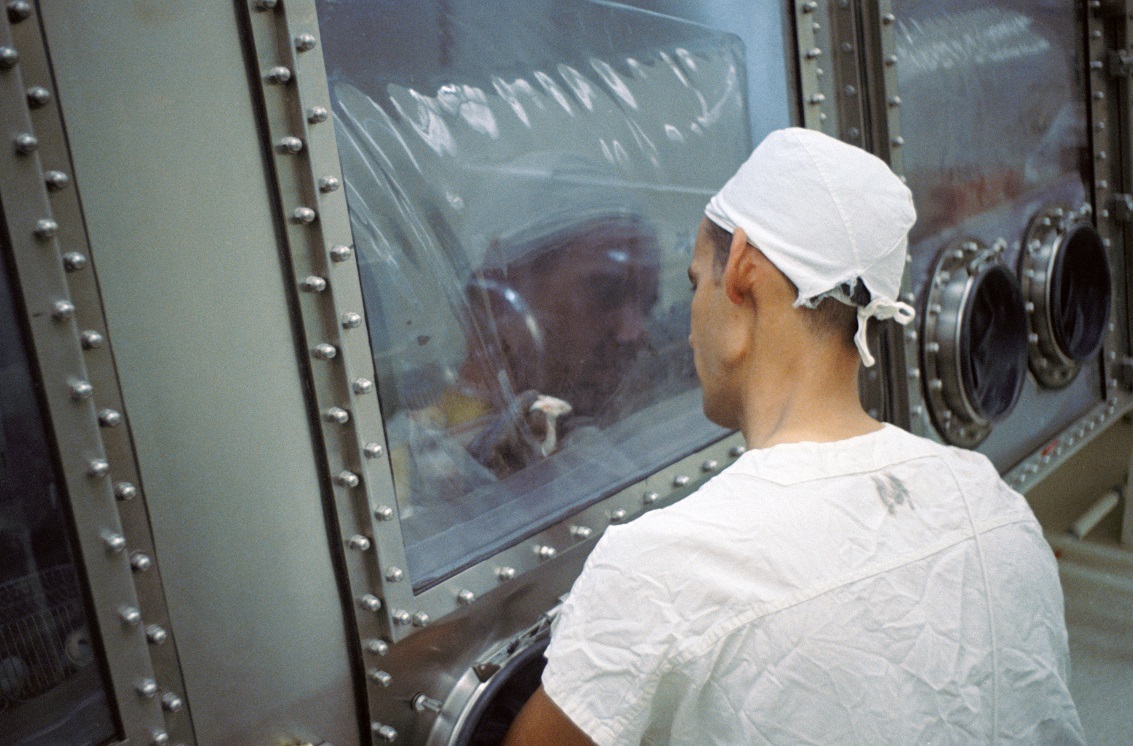
Isolation cabinetry work at the biological laboratory.
All animal testing results were found to be negative. Although there were many deaths among the test animals, they were attributed to accidental exposure to disinfection agents such as bleach. Several inflammatory responses were recorded in the test animals exposed to the lunar material, but none of these reactions could be considered unusual in terms of normal physiological response to foreign material in a normally sterile body cavity.
Apollo 12 - The Second Run
Mission: Apollo 12 (H-1)
Duration: 14 to 24 November 1969
Crew: Pete Conrad (CDR), Dick Gordon (CMP), Alan Bean (LMP)
Quarantine period: 24 November to 10 December 1969
Lunar samples: 34.35 kg (75.73 pounds) - from the Ocean of Storms
The triumph of Apollo 11 might have been the culmination of public excitement for the Moon program, but in terms of science to be done, it was only a beginning. Now that the manned lunar landing and sample return had been shown to be feasible - with minimum biological danger as well - the program was ready to continue lunar exploration. While the previous mission's goal had been to land somewhere on the Moon, this follow-up mission was planned to be an exercise in pinpoint landing. Remarkably, they even had a man-made target on the lunar surface in the shape of NASA's Surveyor III lander, which had been on the Moon since 1967. Pete Conrad and Alan Bean managed to get their Lunar Module down within walking distance from the other robotic spacecraft, and they removed components to be taken back to Earth to determine how the prolonged stay on the Moon had affected them.
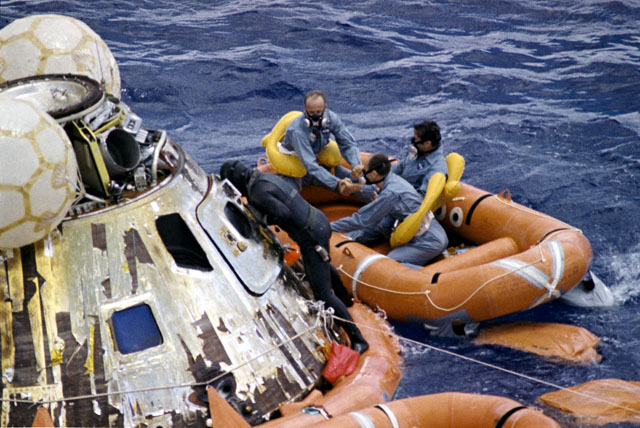
Navy frogman assists the Apollo 12 crew out to the recovery raft.
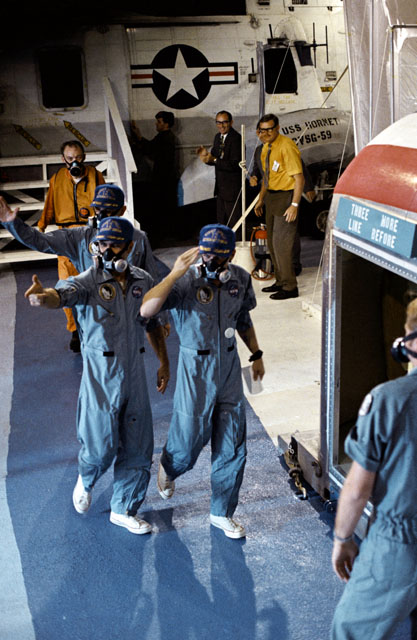
Pete, Dick and Alan salute the cheering crowd as they walk to the MQF. The sign above the MQF door says "THREE MORE LIKE BEFORE", in reference to the 'Hornet +3' slogan during the Apollo 11 recovery.
The biggest change implemented in the crew recovery procedures for Apollo 12 and subsequent missions was the discontinuation of the BIG suit for crew containment. The BIG had been found unnecessarily cumbersome, uncomfortable, and most likely unneeded for the purpose of maintaining the quarantine. Instead, the rescue divers passed to the crew a set of new clean flight coverall suits as well as special breathing masks that filtered the air flowing out from the masks - while recovery personnel wore masks with filters to clear the inflowing air. Otherwise, despite the lack of evidence that lunar material exposure was hazardous, the quarantine was maintained as before.
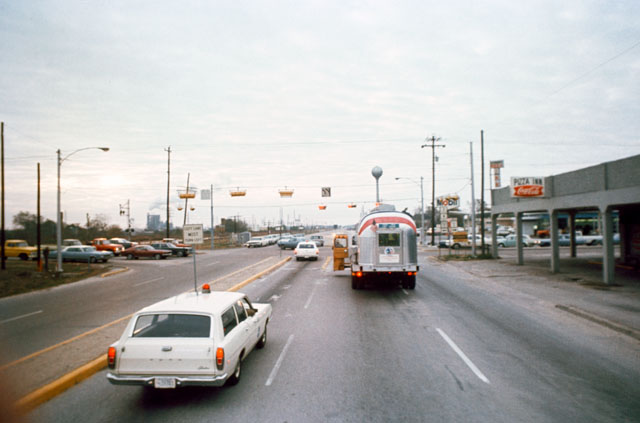
The MQF containing the crew of Apollo 12 makes its way from Ellington Air Force Base to the Manned Spaceflight Center and the LRL.
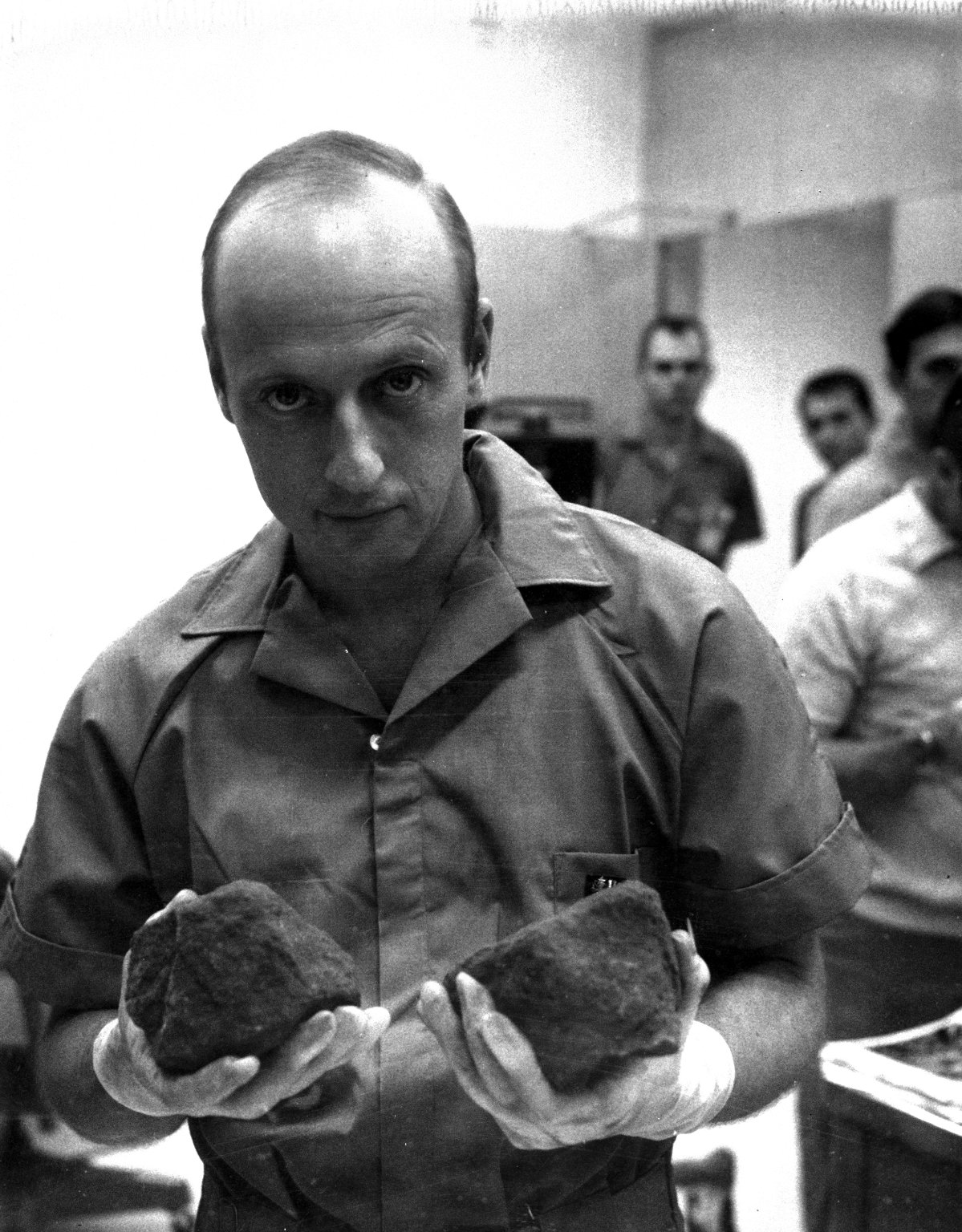
Pete Conrad shows off some of the lunar samples brought back by his crew.
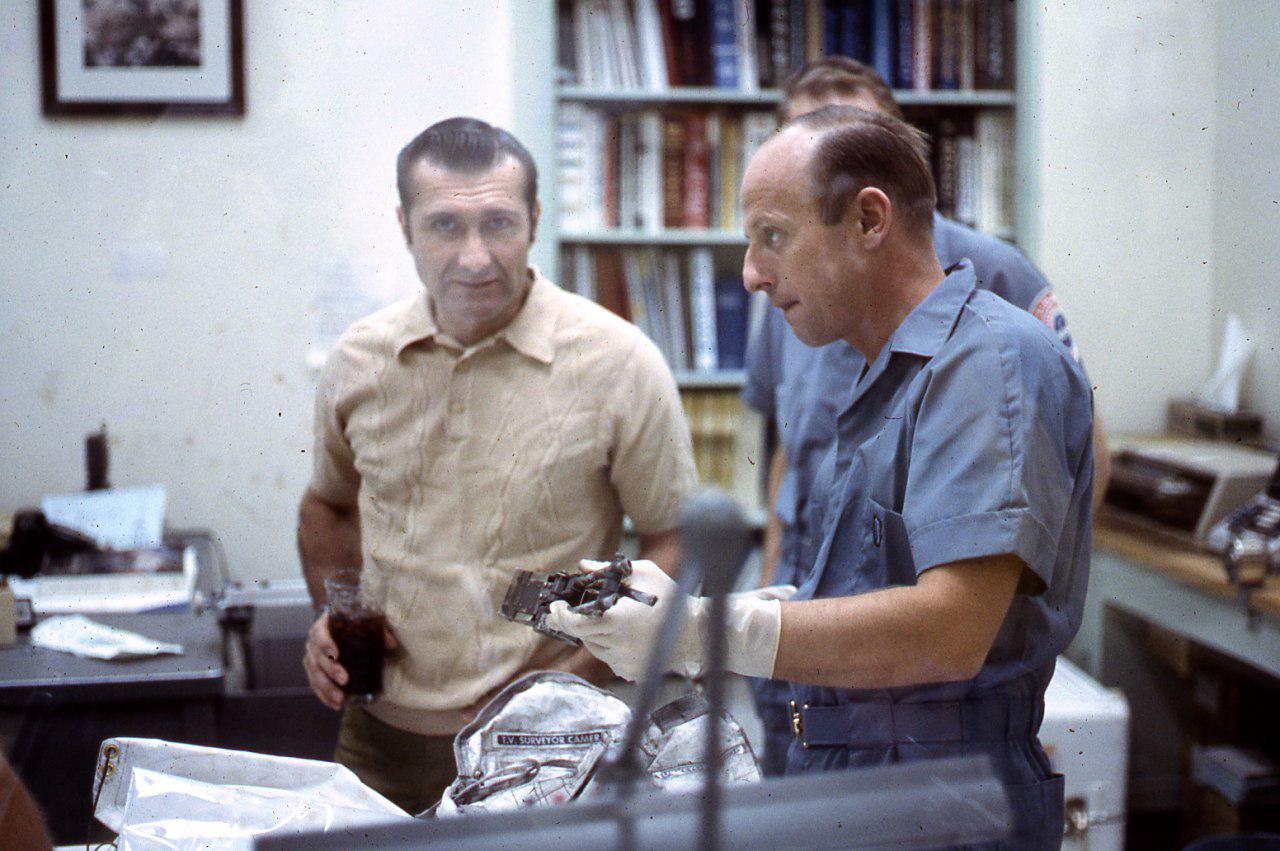
Pete Conrad unbags the Surveyor components. Judging by the fact that Dick Gordon is drinking Coke while Pete Conrad handles the Surveyor lander parts, the crew was not particularly worried about being harmed by lunar dust.
The biological challenge program continued with the new samples brought by Apollo 12. Again, none of the crewmembers, LRL staff, or the test animals or plants showed any signs of ill effects from lunar material exposure, or the presence of pathogens. Although some reports have suggested that viable bacteria could be recovered from the Surveyor III components brought back for study, these claims have not been substantiated, and any results are likely to be the result of contamination while on Earth.
Apollo 13 and 14
Mission: Apollo 13 (H-2)
Duration: 11 to 17 April 1970
Crew: Jim Lovell (CDR), Jack Swigert Jr (CMP), Fred Haise (LMP)
Quarantine period: Not applicable. Planned 21-day.
Lunar samples: None. Targeted landing site was Fra Mauro.
1970 opened with the next lunar landing mission, the second of the more science heavy, longer duration H missions. Veteran astronaut Jim Lovell was going to be the first man to return to lunar orbit, and then to step onto its surface along with Lunar Module Pilot Fred Haise. The three-man crew was completed at the last minute by Command Module Pilot Jack Swigert Jr. of the backup crew after the Prime CMP Ken Mattingly became a true victim of a biological hazard in the space program - a threat of German measles after exposure to the disease via another backup crewmember, Charles Duke. It was decided to go forward with the mission. 55 hours into their trip to the Moon, an explosion inside one of their oxygen tanks disabled the Command Service Module. This led to the cancellation of the lunar landing and to the use of the Lunar Module as a lifeboat to provide propulsion and life support for the return trip. An exhausted crew returned to a successful splashdown into the Pacific on the sixth day of the mission. It was another very Earthborne case of a urinary tract infection that threatened the health of the LMP Fred Haise. Ken Mattingly did not develop German measles.
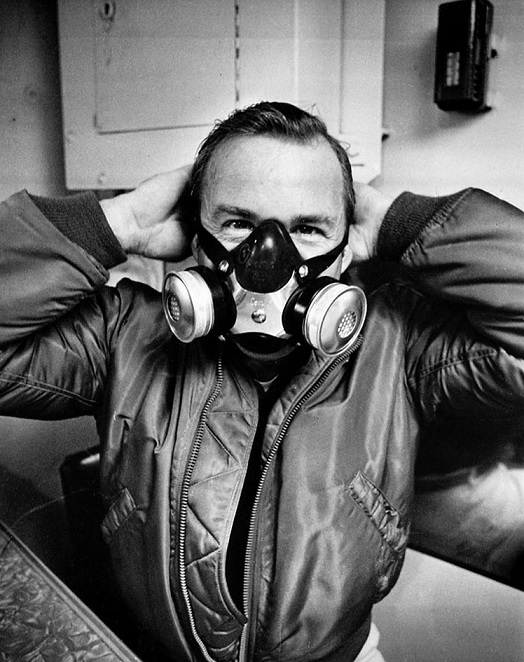
James Lovell poses with his respirator during recovery training.
The cancellation of the lunar landing of course meant no new samples to be tested, nor a crew to be quarantined. The trio of Lovell, Swigert and Haise had been prepared for the standard quarantine procedures and had trained for them as well. This even made for a wry piece of conversation during the journey back home.
087:50:48 Lousma: Jim, you'll be splashing down about 560 miles southeast of Samoa at about 08:00 local time. The weather forecast for the area is good; 1,500, scattered, high broken, 10-mile visibility. The seas will be 5-foot waves, 15 knots, and you'll be going to Samoa by boat and/or aircraft. You'll spend either the night on the boat or in Samoa and return to Ellington by 141 on Saturday, the following day.
087:51:37 Lovell: Roger. Would you tell the people of the LRL to turn it off.
087:51:46 Lousma: Oh, no. We're going to do the whole bit.
The recovery of the crew was not troublesome, but saw some differences to the original plan, due to the lack of the need for decontamination and isolation. Instead of having respirators and protective clothing passed to them by the rescue divers, the astronauts simply received life preservers for their safety on the recovery raft. They were provided with clean clothes that they put on inside the recovery helicopter instead of having to wrestle into them on board the Command Module bobbing in the sea. Once aboard the aircraft carrier USS New Orleans, they were shipped to the sickbay for medical treatment, instead of the MQF that would have been standing by to receive them for the trip to Hawaii.
Mission: Apollo 14
Duration: 31 January to 9 February 1971
Crew: Alan Shephard (CDR), Stu Roosa (CMP), Ed Mitchell (LMP)
Quarantine period: 9 February to 27 February 1971
Lunar samples: 42.28 kg (93.21 pounds) - from Fra Mauro
The accident of Apollo 13 saw many changes to procedures, training, as well as a refit and redesign of the Apollo spacecraft itself. It was in January 1971 that the next mission could finally get under way. Mercury astronaut Alan Shepard became the only member of the "Mercury 7" to walk on the Moon during a successful landing to the planned site of Apollo 13, the Fra Mauro highlands. Their splashdown closed a perfectly nominal mission that ended with the quarantine for the crew, as during the previous two landings.
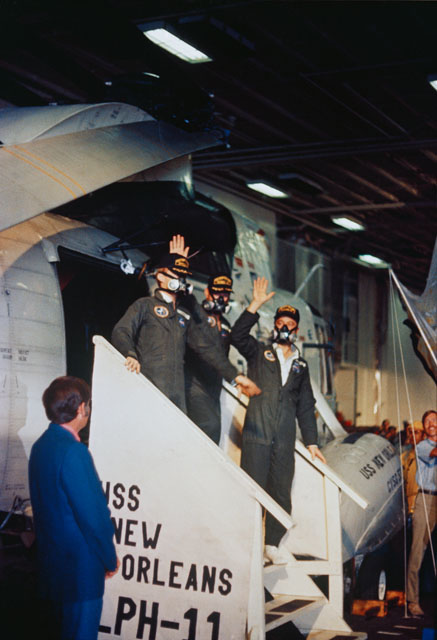
Alan, Stu and Ed wave to the cheering crew of the New Orleans.
The biggest change in recovery and quarantine procedures since the beginning of the landing program was the use of two MQFs during the return of the Apollo 14 crew. After their initial containment onboard the first MQF onboard the recovery ship, they were flown over to an airbase where they boarded another MQF trailer for the transport to Houston. This shortened the time they needed to spend in the confines of the MQF. they were released on the 27th of February, as the last crew to undergo the quarantine of personnel after a lunar landing. No biological hazard or ill effects had been detected.
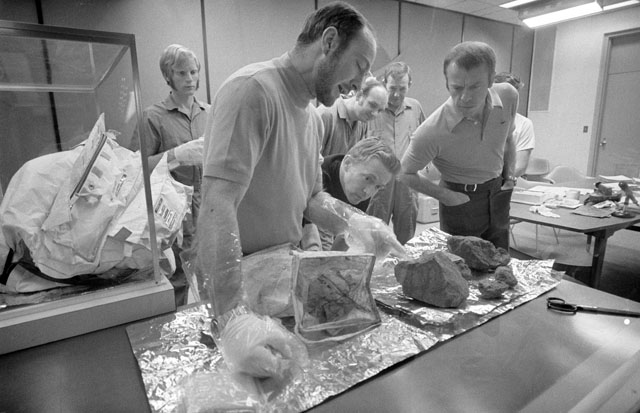
The Apollo 14 crew investigates the samples gathered from Fra Mauro.
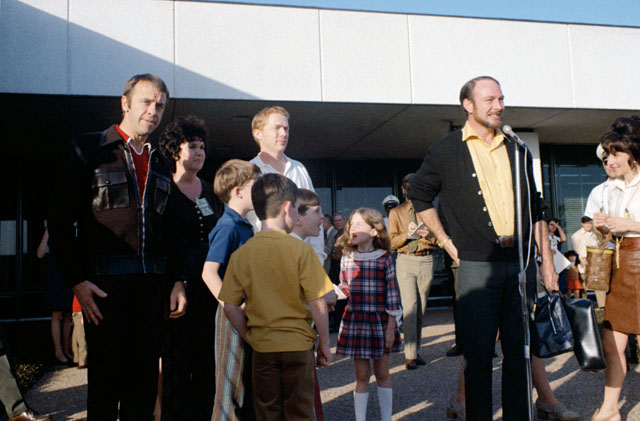
End of one era - the last quarantined crew photographed just after release, outside the LRL. Family members accompanied the crew of Apollo 14 for their appearance outside Building 37.
End of the Lunar Quarantine
After Apollo 14, it was determined that none of the biological examinations had produced any evidence of biological activity in the lunar samples, nor had they found the lunar material to be harmful to human life or other Earth life forms. Hence came the order to dissolve the lunar quarantine for the crew, which meant that the crews of Apollos 15, 16 and 17 were spared the experience. David Scott of Apollo 15, however, wished it had remained in order to provide a decompression period after the rigours of the mission.
This was not the end of the LRL's usefulness, however. The quarantine procedures for the lunar samples remained as strict as ever, to prevent the priceless samples from being contaminated by Earth materials that could affect the analysis. The three extended duration, 3-day landings to geologically diverse areas of the lunar surface produced excellent results and many more samples to be processed at the LRL. It remained the only primary facility until a further sample storage building was constructed in 1979.
Mission: Apollo 15 (J-1)
Duration: 26 July to 7 August 1971
Crew: David Scott (CDR), Al Worden (CMP), Jim Irwin (LMP)
Quarantine period: Not implemented.
Lunar samples: 77.31 kg (170.44 pounds) -from the Hadley Rille/Apennines
Mission: Apollo 16 (J-2)
Duration: 16 April to 27 April 1972
Crew: John W. Young (CDR), Ken Mattingly (CMP), Charles Duke (LMP)
Quarantine period: Not implemented.
Lunar samples: 95.71 kg (211.00 pounds) - from Descartes Plain
Mission: Apollo 17 (J-3)
Duration: 7 December to 19 December 1972
Crew: Gene Cernan (CDR), Ron Evans (CMP), Harrison Schmitt (LMP)
Quarantine period: Not implemented.
Lunar samples: 110.52 kg (243.65 pounds) - from Taurus-Littrow
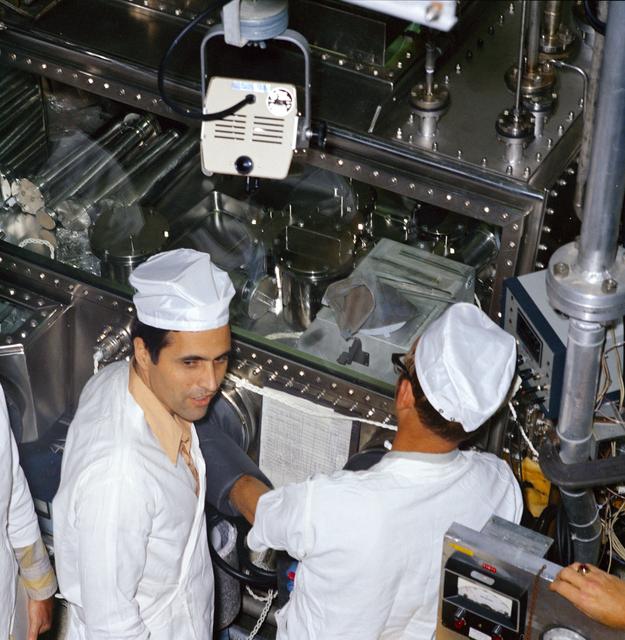
Apollo 17 LMP Harrison Schmitt examines samples in the LRL.
First The Moon, Then Other Worlds
Apollo was the end of manned exploration of outer space, but robotic visitors were already on their way or planned to other parts of the solar system. The experiences gained from the quarantine and science operations of the LRL and associated programs were of great value for these further efforts in planetary exploration. None were likely to be as exciting as NASA's Viking program to Mars, launched in 1975. Two spacecraft were sent to explore Mars, first to orbit it, and then to have landers settle onto the surface of the planet to make the first exploration of this alien world.
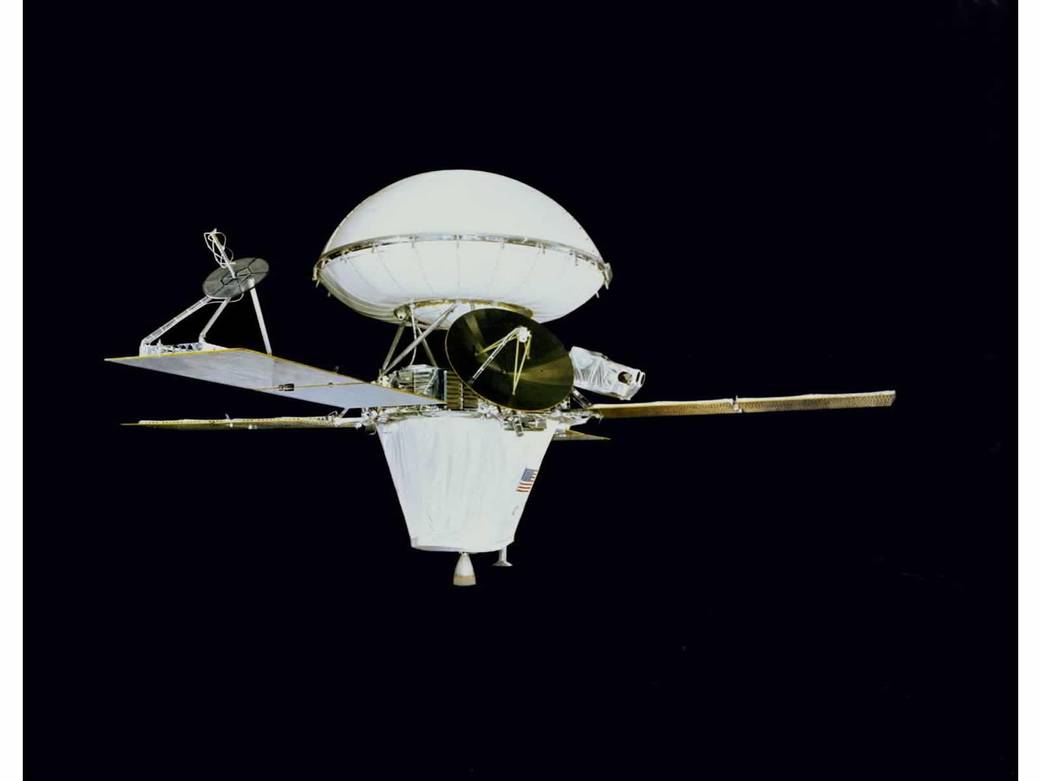
Model of the Viking spacecraft to Mars. The Viking spacecraft was composed of the Orbiter (below) and the Lander. The Mars lander traveled inside an egg-shaped protective cocoon.
Again, biological safety had not been forgotten. The Viking spacecraft was heat sterilized and enclosed in a so-called bio-shell that would prevent the spacecraft from coming into contact with microbes that could be carried from Earth to the potentially pristine environment of Mars.
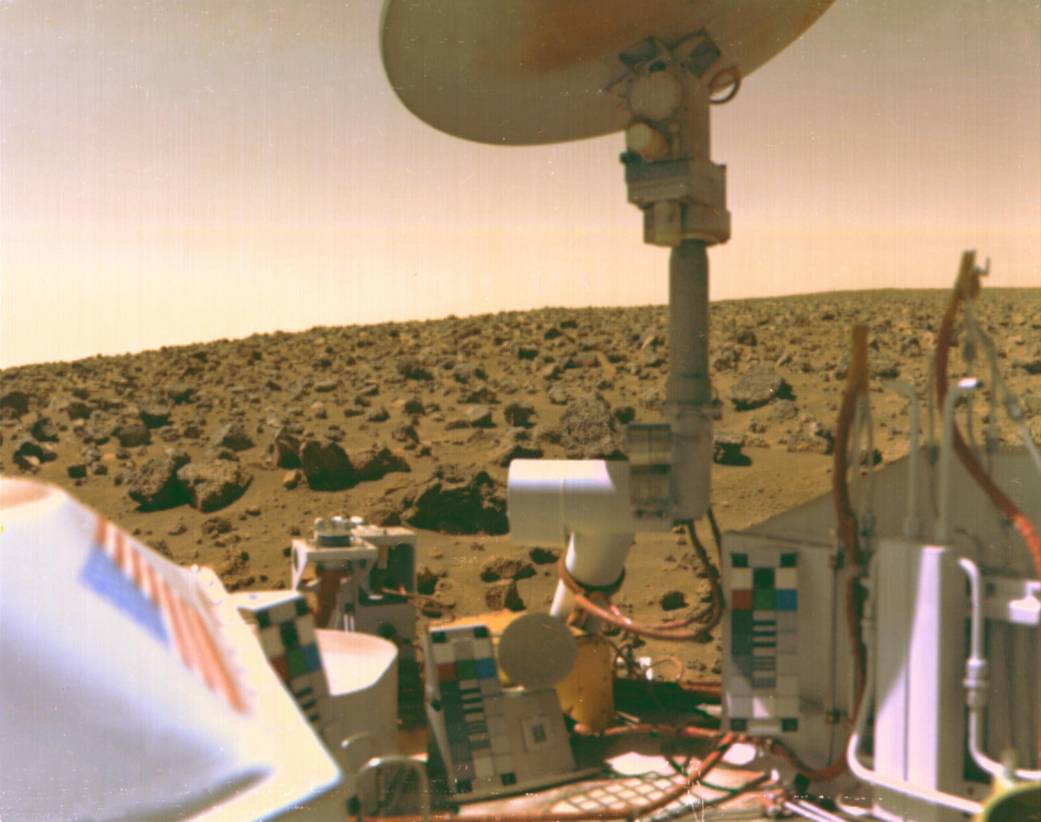
Viking 1's view of Utopia Planitia, on Mars.
Both Viking spacecraft landed successfully in 1976. Each Viking lander carried an automated miniature laboratory system with a purpose not unlike that of the Lunar Receiving Laboratory. This equipment was designed to detect even the most minute signs of life or biological activity in general in surface samples picked up via a robotic arm. The results were infuriatingly - and perhaps tantalizingly - inconclusive.
Further reading
This overview of the Apollo quarantine program could not have been written without the help of these resources, which are wholeheartedly recommended for anyone wishing to learn more about the LRL, the quarantine program, and the biological concerns of space exploration in general.
Biomedical Results of Apollo (SP-348, 1975) is an overview on the medical aspects of the Apollo program, including the medical and biological research conducted before, during and after the missions. It has fine chapters on the LRL and the quarantine program and the biological challenge and analysis programs conducted to ensure the safety of the lunar samples.
When Biospheres Collide (NASA, Michael Meltzer) expands the history of the biological protection programs from before Apollo to the great beyond. Besides the section on Apollo, it details the work done to ensure that space exploration will not contaminate the other worlds in our solar system. It contains good notes on the planning involved and the origins of the Apollo quarantine system as well.

